#composition and the choices made about the lighting or the setting or the costuming
Explore tagged Tumblr posts
Text
The best thing about severance to me is the fact that the pacing is so deliberate and the writing/dialogue is so non-expository. Apparently they were people complaining about some of the slow, very wide shots of the landscape in Sweet Vitriol but it's there for a reason!! It's there to draw you in!! Stop worrying about the next time someone is going to be on screen actively involved in a scene and start paying attention to what the show is putting directly in front of you. Think about it as you're watching it. Look for the very minor details within those very long "nothing" shots. It wouldn't be there if they didn't want you to see it
#the way i feel about any very very slow paced piece of media tbh#like In a Violent Nature last year#yes its a lot of very slow 'nothing' shots of a man walking in the woods#but it gives you space to sink into it. to really listen to the sound design and analyze the way the actor is moving. to think about the#composition and the choices made about the lighting or the setting or the costuming#i love a Long Nothing Shot
6 notes
·
View notes
Text
I mentioned in this post here that Thresher feels like it's building on the production and cinematic choices Critical Role made when producing UnDeadwood, in terms of the shots being used and the fact that the camera is slightly mobile (as well as the immersive sets and costumes), and both @utilitycaster (post here) and @wardensantoineandevka (post here - see also her tags on utilitycaster's post) have made posts about how Thresher is following in the cinematic language of actual play shows outside (and occasionally inside) of CR's banner in terms of having how it films the gameplay and in turn, how that makes the fact that most of the shots are close ups flow naturally as opposed to the blended close ups CR has tried in a number of projects (Candela Obscura: The Circle of Tide and Bone, Candela Obscura: The Circle of the Crimson Mirror, Exandria Unlimited: Divergence, and Wildemount Wildlings), which tend to feel jarring and out of place. I'd like to add that in addition to the blended close ups often being, as referenced in the post's linked above, at odds with the cinematic language one has come to expect from CR, it also doesn't feel like a meaningful evolution of the production and camera choices made in the works that the shows that are trying to use it are building off of. Under a cut because this got very long.
To start with Candela Obscura, this series has always seemed that it was building of off the groundwork laid in the one-shot Call of Cthulhu: Shadow of the Crystal Palace. Shadow of the Crystal Palace featured costumes appropriate to the setting of the one-shot and a thematically decorated set in order to set the tone of the work, both of which would become common production practice for Candela Obscura. To reinforce the connection between the two Marisha Ray's player character from Shadow of the Crystal Palace, Alexandra Elise O'Neill, appears in Candela Obscura: The Circle of the Vassal and the Veil as the eponymous Circle's Lightkeeper. Most notably here, however, is that Shadow of the Crystal Palace as well as both of the first two Candela Obscura miniseries (The Circle of the Vassal and the Veil and The Circle of Needle and Thread) used the camera arrangement that is standard for an actual play series produced by Critical Role Productions: three static straight on camera shots, one of the Game Master and one of each half of the table, arranged in an overlay so that all participants are visible at any one time. The Circle of Needle and Thread did make use of dynamic lighting in order to highlight which characters were in scenes, keeping the physical spotlight on only the characters in the metaphorical spotlight, but no deviations in shot composition were made.
This changed for third Candela Obscura miniseries, The Circle of Tide and Bone, where the addition of blended close ups of the Game Master and whichever player character was relevant was made. This was not, however, a choice that was applied consistently throughout the work, while sometimes it was used when only a single player character and an NPC controlled by the GM were in a scene (most notably this is how these shots were applied during the third episode of the miniseries, "Candles in the Dark" during each player character's scene with Iomene), they also occasionally appeared when all player characters were in a scene but a character was simply having an emotionally intense conversation (such as the use of these shots for a conversation between Ashly Burch's character Dr. Elsie Roberts and Lightkeeper Nokari, for which the other player characters were present just off to the side). This lack of consistency made it feel less like an evolution of The Circle of Needle and Thread's usage of lighting (as some emotional scenes would still use the standard framing which still comprised the majority of The Circle of Tide and Bone's shots) and more like the editors had decided to zoom in on certain scenes with no clear reasoning. In particular the usage of these blended close ups for earlier emotional scenes weakened their usage for the scenes with Iomene as any semblance of them being a way to place the audience in the same situation as the player characters (suddenly isolated from the rest of the group in a void with only Iomene) was lost because earlier scenes did not have this isolation element. The blended close ups reappeared in the fourth and to date final Candela Obscura series, The Circle of the Crimson Mirror, and while the shots themselves were more elegantly composed (airbrushing the boarders of the shots together rather than simply placing them side-by-side as The Circle of Tide and Bone did), they still had the problem of not being used consistently for any one type of scene beyond "this is an emotional moment involving a player character and the GM", and not being consistently applied for even that, making it feel less like a deliberate choice to allow the emotions of certain moments to come through by allowing the actor's faces to take up more of the screen and more a choice the editors made in post simply because, as all CR produced series have been since 2020, Candela Obscura is live-to-tape and they can.
The first time blended close ups were used in a work outside the Candela Obscura banner was in Exandria Unlimited: Divergence, which featured both these shots as well as close ups on individual actors. It should be noted, however, the Divergence is the fourth miniseries under the Exandria Unlimited banner, following an initial miniseries simply titled Exandria Unlimited, Exandria Unlimited: Kymal, and Exandria Unlimited: Calamity. It also exists in conversation with an interlude which occurred during Critical Role Campaign 3 entitled "Downfall". All of these series, and indeed, every work Critical Role had created to that point which used Exandria as a setting, once again used the static camera arrangement of three shots showing the entire table arranged in an overlay so that the whole table was visible, and this was likewise the primary shot arrangement for Divergence. It was here that another weakness of the use of close ups was made apparent. An oft cited benefit of CR's use of static whole table shots is that it allows actors to react in character to events even when their character is not speaking and not the focus of the scene. For an incredible example of this, pay attention to Liam O'Brien as Caleb Widogast during early Critical Role Campaign 2 scenes which mention the Cerberus Assembly, an organization which features heavily in Caleb's backstory that he is actively on the run from but whose connection to him he hasn't yet articulated to the rest of the Mighty Nein. These reactions would have been lost if the shots were composed to exclude Liam due to his character not actively participating in the scene, but become crucial moments of character building in retrospect. Such a moment comes up in Divergence, as there is an emotional scene in the second episode which features Alexander Ward's character Crokas where the camera is focused solely on Alex, and he notes that his (Dragonborn) character cannot speak Draconic, and Jasmine Don can be heard from off camera saying that's because her (Halfling) character Fiedra raised him. The fact that Fiedra raised Crokas but is unable to be emotionally honest about what that means, to herself but more importantly to him, is a crucial aspect of their relationship and a facet which becomes incredibly relevant to their interactions during the final episode of Divergence, so in retrospect it feels like something was lost having Jasmine off camera when she delivered that line, if only because it denied the audience the chance to watch as well as listen to her perform it. There is also something to be said that making that line something which is only heard coming from beyond the camera's gaze minimizes information which is in fact crucial to understanding Fiedra, Crokas, their relationship, and the journeys both characters undertake in Divergence.
Additionally, the close ups in Divergence still suffer from the issue the close ups in Candela Obscura suffered where they are not used in a consistent enough manner to make the choice to use them mean anything beyond "this is an emotional scene involving this character". There are scenes where only one or two player characters are present that use the static whole table shots (such as an emotional scene in episode 4 between Liam O'Brien's character Erro and Celia Rose Gooding's character Rei'nia in a temple of the Platinum Dragon were Erro discusses needing to move on soon which takes on extra poignancy both when Erro later dies and when he later still is revealed to have been the mortal incarnation of the Platinum Dragon himself, in a time when the gods are pulling back from Exandria), and scenes where all player characters are present which use close ups (the above mentioned scene involving Crokas). The closing sequence of Divergence, featuring Erro as the Platinum Dragon and Matt Mercer's character Garen as the All-Hammer, alternates between full table and close-up shots even though the characters involved in the scenes remain consistent and the change in shots is not following a change in setting or action, making the choice to change between the two feel arbitrary. So once again, the close ups fail to build on the groundwork of works before them, nor is their usage itself meaningfully improved from previous works. In fact, they actively subtract something which added meaning to previous Critical Role works.
The most recent Critical Role work (bar Thresher) to make use of close ups is Wildemount Wildlings, an Exandria-set miniseries which at least tonally most closely lines up with the similarly Exandria-set but wacky Honey Heists and A Familiar Problem: Sprinkle's Incredible Journey, which all, once again, solely used the three camera static shot composition which is CR's hallmark. Wildemount Wildlings deviates from this both by having close ups but also by having full cut aways to two player characters who are not at the table but are having a parallel adventure to the characters that remain. However, I feel this works better as an evolution in production than the close ups (which suffer from the same problem as previous close ups of their usage being too inconsistent to truly mean anything), both because they are used consistently (only for scenes where Beau and Yasha are separated from the rest of the group but having interactions relevant to the narrative of the whole work) and because it feels like a natural evolution of a longstanding practice in Critical Role produced actual play: having players leave the table when their character is absent for long stretches of gameplay (or the character is present but deceased). In Wildemount Wildlings, when Beau and Yasha are separated from the campers and Marisha Ray and Ashley Johnson leave the table, the camera simply takes the additional step of following to them to see what they're up to in the meantime.
To bring this all back around to Thresher, the use of close ups there works because as the posts I linked way back at the start of this state, the cinematic language of Thresher is following in a different tradition to most Critical Role works (and notably Thresher was produced in partnership with 12-Sided Studios and Paragon Pictures), where these shots are the norm. With works following in the tradition set by Critical Role as a production studio though, close ups are very much a deviation from a long standing cinematic language which relies solely on static shots. And the way these close ups has thus far been used has failed to add anything meaningful (and occasionally actively obscured meaning) or to meaningfully build on other aspects of Critical Role's production practices (as the cut away shots in Wildemount Wildlings did). As a result, these close up shots feel jarring, and more damningly, unnecessary except as a way to show production value for its own sake, rather than using production values as a way to enhance the narrative a work is telling.
63 notes
·
View notes
Text
Vladimir Paley and his relationship with his sisters

The person who had the most lasting impact on Natalie's childhood was her brother Vladimir, who had all the talents. So much so that throughout her life, she searched for imitations of Bodia - who over time became to her the very essence of masculine perfection in most of her friends.
“He read to us plays by Edmond Rostand, The Blue Bird by Maeterlinck, extracts from Rabindranath Tagore and naturally his own works,” remembers Princess Irène Paley . “He wrote small plays for us, drawing the costumes, brushing the sets, adjusting the lighting. He played works of his own composition for hours on the piano." As Jacques Ferrand recalls, in the portrait that he paints of himself, one might have believed at first glance that he was an affected and spoiled child whereas in reality he had great maturity, very unusual for his age.

His parents, and particularly his mother, to whom he was very close, always encouraged his rare gifts. "From childhood, he wrote verses of which he had nothing to be ashamed of - some of his works can be compared to those of Pushkin", Prince Félix Youssoupoff assured, translating the general opinion with these words, "painted and played the piano like a virtuoso." An ideal big brother. If we add to so many intellectual qualities his Narcissus looks, then we have a precise idea of his personality. (...)
Vladimir was a source of joy for everyone. Grand Duke Paul himself, so often lost in thought, laughed a lot in her presence. He liked to leaf through the album of caricatures made by Bodia, who always caught everyone's faults, starting with his own.

Concerning Irene and Natalie, we owe him the most revealing text, the most psychologically accurate, as to the links which united them: "This year, Iricha is doing her devotions for the first time. She came with us to church without Natacha who didn't know what to do at home. We took her for a walk but she still seemed bored." Since it was always Iricha who was 'the leader', Natacha had difficulty being without her older sister, and what's more, they were not used to living apart. When one of them was ill, the other wandered sadly, like a shadow around the house, but when they played together in the garden, they invariably fought but resumed their games after five minutes, as if nothing had happened. As the popular saying goes: “Together we feel cramped and apart we feel bored.”

Until 1913, when Natalie was eight years old, Bodia shared his parents' exile then, with the authorization of Tsar Nicholas II, he returned to Russia in order to complete his education in the Corps des Pages; he was left with little choice... a career as an officer in the family tradition. From then on, his two sisters impatiently awaited his return to Boulogne, dressed in his dark blue uniform with golden frogs and peaked helmet with a white mane.
The direction given to Vladimir's studies is surprising, because nothing about his nature predisposed him to such a change of heart [from his artistic inspirations]. This choice had the stamp of Grand Duke Paul, who, unlike his wife, "didn't understand the qualities which gave his son all his value"; moreover, his somewhat bohemian tendencies surprised him and, perhaps, also worried him slightly. Time proved him right. Bodia, separated from his family, far from the adoration his mother and sisters bestowed on him, took full advantage of the contact with other boys his age and the merciless discipline of the Corps des Pages. He became more natural, more spontaneous, while never neglecting his different passions. His departure was the first heartbreak of Natalie's childhood.
Princess en Exile - Jean-Noel Liaut
#romanov#paul alexandrovich#imperial russia#imperial family#royalty#olga paley#natalie paley#irina paley#vladimir paley#royalty in exile#paris#belle époque
31 notes
·
View notes
Text
Mindmap and Brainstorming for our Plot

During the week me and my group were gathering ideas for the plot of our short film, and today we finally met to share our ideas and create a mindmap. We decided that we want to make a crime/mystery/noir story with a psychological edge. One of our members suggested his ideas inspired from a book called "The Black Dahlia". Of course we didn't want to fully copy everything so we made changes and twists.


We concluded that the story will be set in 1940s, about two detectives, and one of them hyperfixates on a victim (prostitute) they are investigating, who was brutally killed. He investigates this along with his high-status, cop who could be covering for his brother (who could be the killer). We are still deciding on the names of the characters, so we might change them in the future. Also we want to include a plot twist in the end. We will explore themes like morality, obsession, and betrayal.

Once we finish establishing the foundation, Ruben and I plan to dive into these areas below (we will probably divide them), and research in those directions, so we can bring our ideas to life:
🎬Cinematography (lighting, framing, shot composition)
🎨Mise-en-Scène (set design, props, costumes)
📢 Festival Postcard (our genre conventions, promotion)
📝 Script Development (sharp and meaningful dialogue, plot twist, character arcs)
🎭 Performance & Directing (casting choices, how can we guide our actors to bring out the psychological complexity of these characters?)
🎶 Sound & Music (sound design, score to enhance tension and unease)
Also I wanted to mention that I've recently been watching a lot of short films, especially in neo-noir and noir genres, and those four below were the ones I liked the most. While watching them, I payed attention to what kind of stories get told, what kind of protagonists are there, what kind of challenges/obstacles they face and how it all gets resolved in the end. Watching those short films allowed to get a taste of those genres, and see what ideas I like. I already feel more familiar with their conventoms, but I will dive deeper into neo-noir and noir in my future posts.

0 notes
Text
Hands of Men - On Set
Day 1
Having not been on set in a while, I was looking forward to getting back into it. Our first shoot day was the 9th November at 5:30 pm until 11pm. I was working closely alongside Cara, who had brought many props to design the set with. We had been on location (Abbie’s room) the day before to move furniture around, accommodating all the equipment that we needed to fill the room with. We decided that we wanted to use any red props to design the set with, such as vases, plant pots, books, plants. It was a big decision whether we wanted the room to look bleak or homely. The initial inspiration for the room in the moodboard was to be empty, signifying the breakdown of the couple’s relationship.
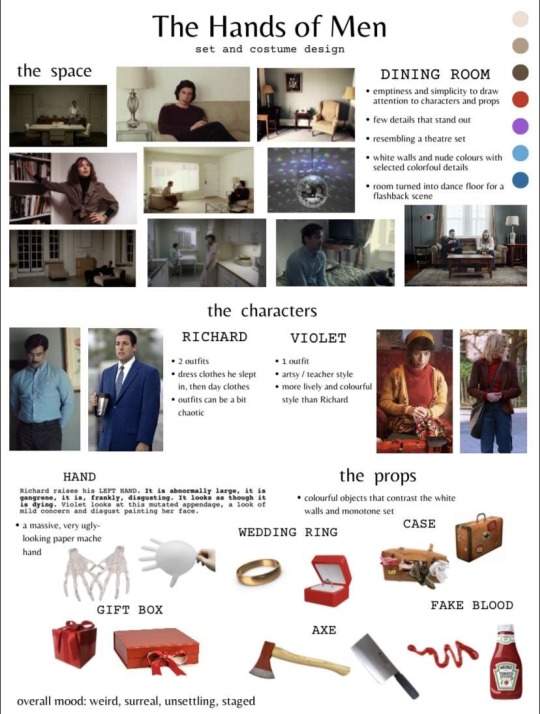
On set, we decided this didn’t work because it simply looked unfinished, like there was no production design apart from the props mentioned in the script. So we decorated the surfaces like so:


… making sure we had a lovely composition of red objects in the frame. This of course included Violet’s costume, the big red gift box and the blood marks on the hand. I liked the choice of red not only because of the aesthetic, but also because it symbolises love, and blood - foreshadowing the events to follow. Additionally, it looks good with the specific lighting setup used by the camera team.
The first shot we captured was a dolly zoom/ close up, so little attention was needed for production design here. However, as spare ‘hands’ on set, Cara, Hayley and I were cast as extras. We played the hands of the women in the flashback (with painted red nail varnish I might add).
After the set and first shot was finished, the art department were responsible for keeping an eye on continuity, making sure props and costumes were kept in the right place. The main props which needed resetting were Violet’s blindfold and the ribbon on the gift box, as both are removed halfway through a shot. We had to take a lot of pictures to make sure we were as accurate as possible.
Day 2
Second day of shooting was at 2pm on the 10th November. This was the day we needed the extra hands for the final shot. Cara had made replicas of the main one, and I was to paint them. As these hands have already been cut off in the film, they need to look more dead than before. They had a base layer of white spray paint which I think worked well as pallid skin. I then used a sponge to add the same grey I used before, but mixed in a lot more red and purple for the blood. We also had fake blood, which we had to pour over the pile of hands, to make sure they looked freshly cut off. Cara and I had to experiment with this first, so we lay down the carpet which we were going to use and began dripping the blood, making sure it pooled in the right places and splattered over the fingers etc. It was actually pretty difficult to make it look realistic, as the blood would sometimes absorb into the rug, or the splats would look unnatural. Plus the fake blood was sticky, and made me feel queasy. We needed a good composition to pile the hands for the perfect looking shot.
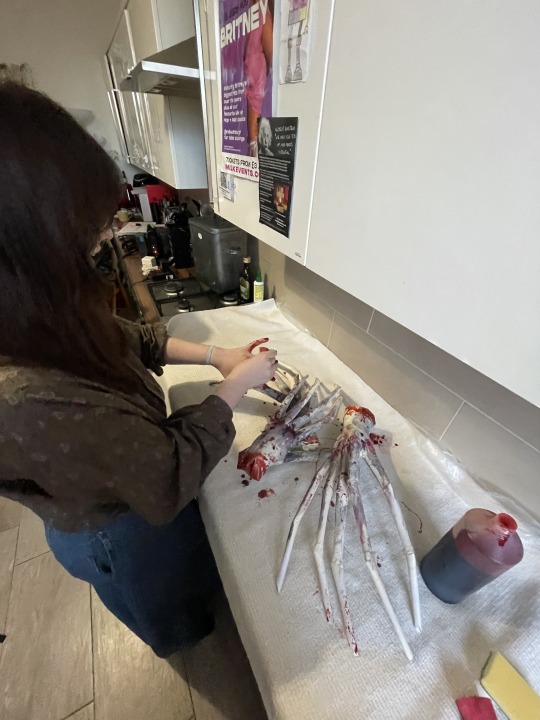

As the shot we needed the extra hands for was the very last one, we had to leave the bloody mess, and the blood just seemed to disappear. This meant we needed to revisit it later, which was fine as we had plenty of fake blood. The final shot did look incredible:

Apart from mastering this (at the end), we had still needed to keep an eye on continuity. The biggest problem we had today was the hand itself. It had been worn in, and started to look slightly wrinkly. This meant a lot of quick readjusting of the fingers, bending them into place before rolling the camera.
We were also worried about how the shot of the hand rolling onto the floor may look. As it was just papier mâché, it didn’t have the right weight, and getting it to roll from the right angle was going to be a challenge. We succeeded, however, though it took a lot of rehearsing. It was nerve wracking as we only had one take to get it right - as the blood would stain the carpet.
I was amazed with how good the hand looked on camera….
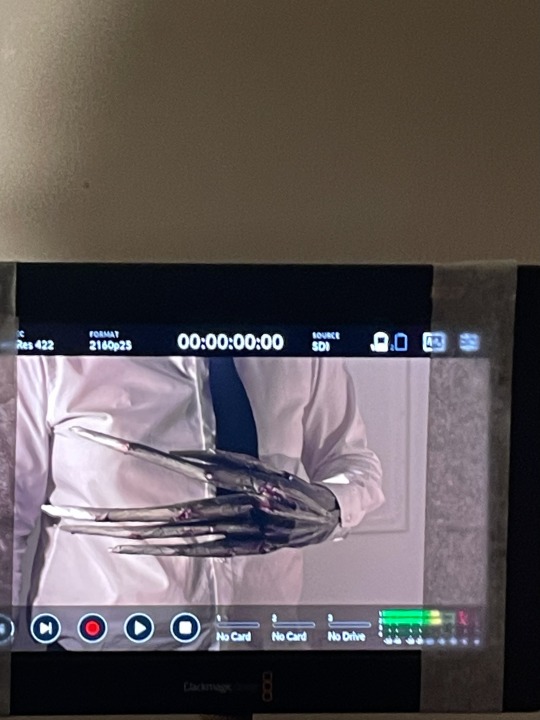

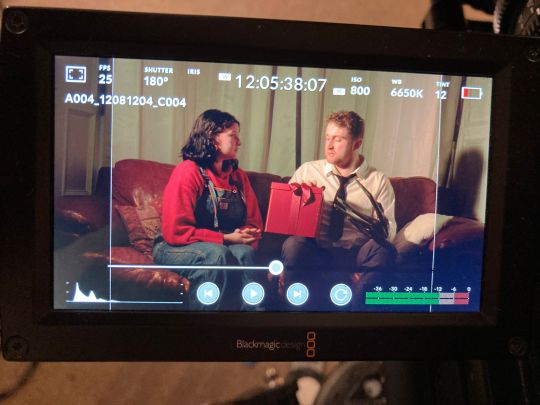
…and was amazed with the talent shown by the rest of the cast and crew. Here are a few bts photos of how the shoot went:

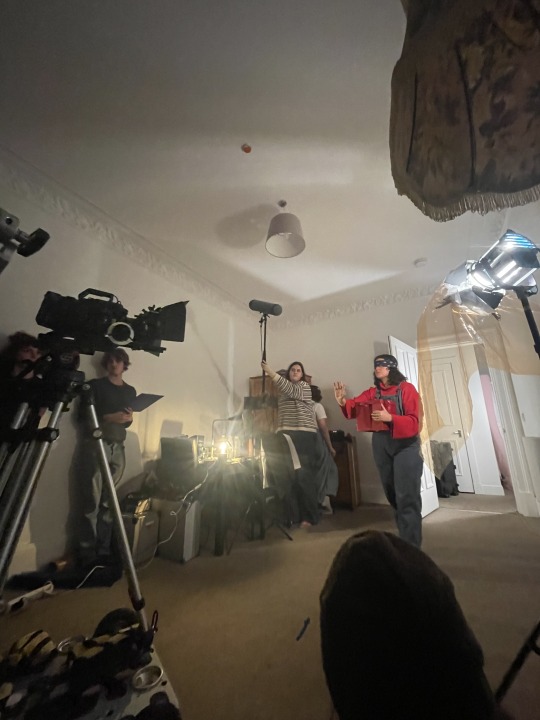

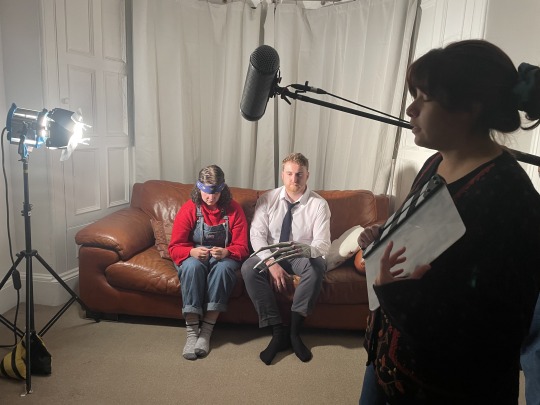

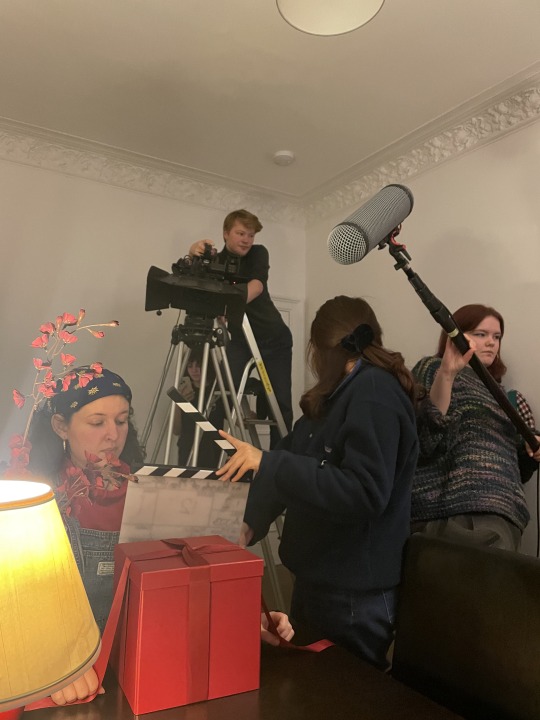
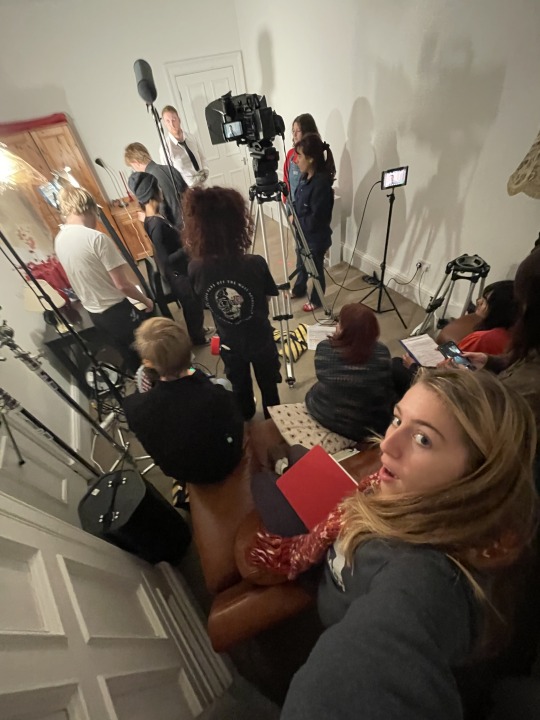
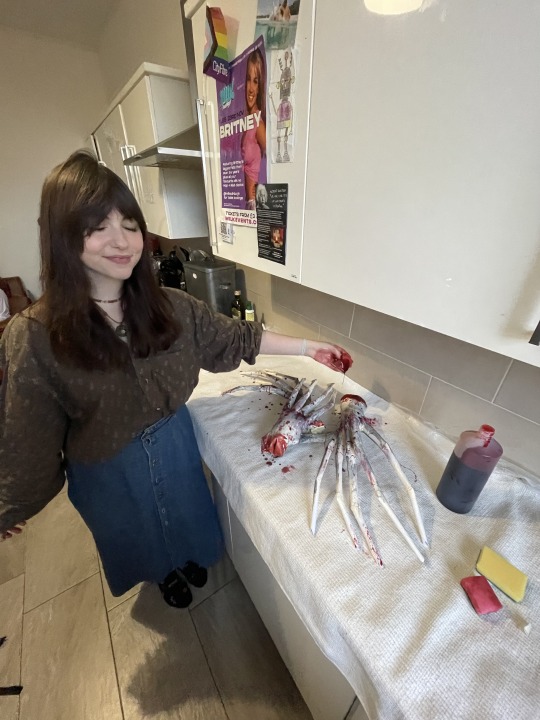
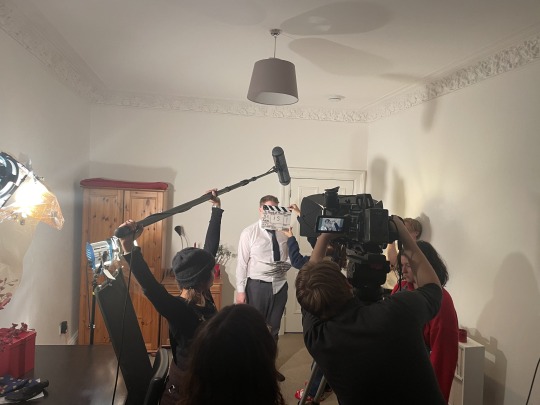
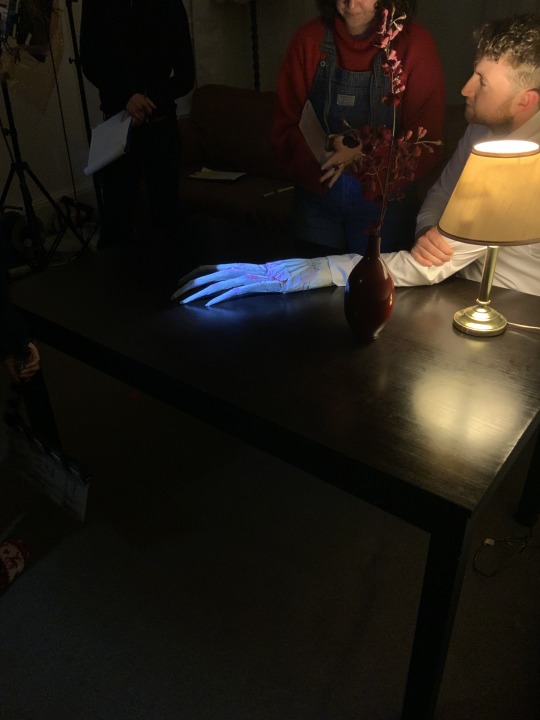
Well done everyone.
Producer - Abbie George
Writer - Hayley Exton
Director - Paula Sosa Martín
1st AD - Vanessa Townsend
DoP - Max Brodbeck
1st AC - Oliwia Szostka
2nd AC - Owen Neill
Gaffer - Lewis Norton
Sound Recordist - Sophie Brownlow
Boom Op (Day 1) - Mara Prentice
Boom Op (Day 2) - Gabrielle Hafner
Script Supervisor - Krisztián Kajtár
Production Designer - Cara Fidelo
Art Department - Catherine Paterson
On-Set Photographer - Taylor Cowe
Violet - Isabella Dellazari Velarde
Richard - Peter Morrison
OSP and FW
0 notes
Text
Miraculous’s Paris feels quite impersonal and its geography is incomprehensible most of the time, which makes it difficult to care about it whenever it’s in danger
TL;DR: Paris in Miraculous has a weird geography, and unfortunately, the show doesn’t hide it all that well, which makes it hard to believe in the city as a coherent and cohesive space. Bad lighting and poor texturing makes scenes set outdoors during the day look real bad, and while some of the famous buildings in Miraculous are pretty close to the real thing, they don’t mean much to the viewers emotionally speaking, they don’t elicit a reaction other than “huh, that’s neat”. If your heroes’ mission is to protect a city that’s just “neat”, well it’s pretty hard to care about said mission.
When you aren’t French and you want to make a show or a film with a scene set in Paris and you want to sell it to an international audience, you put the Eiffel Tower, the Louvre and cafés everywhere. And that’s fine! It’s just a backdrop, you’re not supposed to care about it all that much, because you’re going to spend 2 hours there at most and what’s more, more often than not, Paris is just a decor, not the whole conceit of the film/show.
Miraculous’s version of Paris follows that same logic, weirdly enough, even though it’s made by French people, and initially intended for a French audience. The Eiffel Tower is in a whole lot of shots, we spend a lot of time at the Louvre and near some other touristic landmarks such as the Arc de Triomphe, Notre Dame, the Grand Palais, the Place des Vosges and the Place du Châtelet alongside the occasional metro station, they’re all decently made, at least they’re recognisable. Good job, you guys! (I’m sincere about that bit of praise, too)
It uses referential elements, i.e. things from the real-life Paris… And mashes them together in a bizarre way. Monuments are way too close to one another, or they are places they shouldn’t be. That, in and as of itself, would be fine. Paris is big. You can’t model every single Parisian street in existence, you have to make choices to stay within your budget. And with Miraculous, it kind of works…? If you don’t think about it too much, that is.

This, for instance (that’s from Animan) doesn’t make any damn sense. The Eiffel Tower should be on the other side of the Seine, not here, and the Place des Vosges isn’t that close to the water. Still, it sort of works, if you haven’t lived in Paris yourself. Which will be the case for most people watching Miraculous. It’s a show about a girl who uses a magical yoyo, so I can excuse that sort of weird stylistic choice due to budget constraints.
So, basically, Miraculous has pretty good individual sets, especially indoors sets,Marinette’s house, Agreste mansion, the school, these cool touristic locations, the Grévin museum, even, but they either feel too close to one another or like they belong to different, disjointed spaces. It’s hard to tell where each location is meant to be in relation with one another, even when our characters travel from one place to another.
And how do they travel? Well, they jump from rooftop to rooftop and the landscape stretches endlessly. Rooftops that all look the same. It’s the exact same "set” every time. That isn’t a bad stylistic choice per say, if the point you want to make is that Paris is really really big and there are lots and lots of houses that all kind of look the same, it’d work really well. It’d make the city feel a little oppressive. But you want Paris to be a space the audience cares about, right? So maybe don’t do that?
The way travelling works in Miraculous is, you jump onto a rooftop, you run you run you run and then you land and you’ve reached your destination. Each trip works the same. Doesn’t help make the various sets feel connected, no, sir. Plus, the Eiffel Tower teleports all over the place.
Can you tell me where Alya’s flat is supposed to be? No, really, can you? It’s a nice art déco building, someone probably went through lots of references to model it and it shows! Nice job, really, I mean it. But where is it?
Well, it’s in an Autodesk Maya file in a database somewhere, but other than that… You’ll tell me if you ever figure that out, I sure wasn’t able to!
So it’s hard to believe in Paris as a kind of non-fragmented space, even more so when wide shots look like this
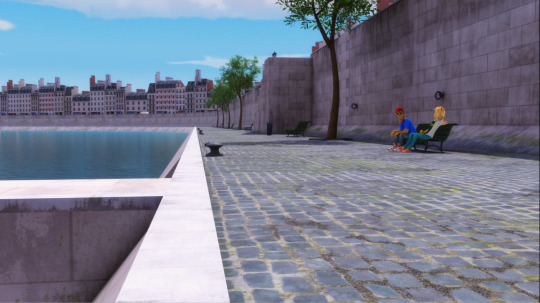
and that tells you everything that can go wrong with Miraculous’s outdoors scenes. (also that shot composition isn’t bad at all but it’s weird for a scene like that)
Copy and paste your assets, benches, trees and houses, and don’t modify them one bit. The thing it, that’s fine in shots in which the camera moves a lot, it works well with certain angles, which is the reason why there are lots of chase scenes that go too fast for you to notice that there aren’t all that many “regular house” models, some with an alternate “café” ground floor which features awnings with three different colours. That’s a trick cartoons like Scooby-Doo already used in the 60s to simulate speed. That’s good when things move!
Only, sometimes you see two awnings with the exact same colour in the same, very still shot that lets you see the street in which the house models alternate in a pattern that is easy to detect. You become truly aware that this is a set created by people that feels very artificial.
Textures in Miraculous are great when it comes to the character models. For the rest not so much. The really ugly pavement texture you see here…
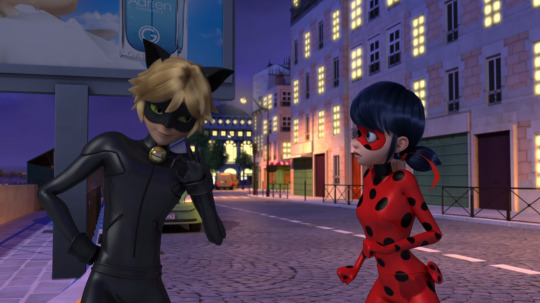
… looks fine when shot from above but looks like dogshit when the camera is closer to the ground, if I may be so blunt. Everything looks worse in the daytime, because daylight is rendered rather poorly most of the time, and the textures either haven’t loaded properly or aren’t high-res enough. That pavement feels real flat, like a texture, not like pavement. Which isn’t very good. Trees often feel like plastic, dirt doesn’t look like dirt at all, more like sand. Miraculous isn’t going for a photorealistic vibe, nor should it be, but these textures just don’t work very well to represent what they are meant to represent. They seem a little off, just enough for you to notice.
Often, everything looks squeaky clean too. Norman Reynolds of Star Wars fame understood that squeaky clean props and sets and costumes aren’t very convincing and tend to feel cheap, so you need to apply a bit of weathering. And Paris isn’t exactly clean. In Miraculous, most buildings are spotless. They don’t feel like they’ve existed for long despite their 19th century architecture. Are you supposed to feel like this is a story set in a giant dollhouse starring action figures? I’m not sure that was the intended effect, there’s an episode with alive toys and the toy world looks even plasticky-er
(Nighttime scenes, on the other hand, can be really gorgeous. Sapotis’s outdoors scenes are truly magical, it’s a really nice-looking handful of scenes because you get to have a better control on the way your scene is lit. Likewise, most scenes set indoors tend to look quite good because there’s greater control over the lighting sources).
Some spaces feel familiar and friendly, homely, even, namely Marinette’s house, the houseboat to a lesser extent, these are all places you’d hate to see get destroyed, and you get a sense of where they are. Sort of. Ish. But outside of that… There aren’t any memorable streets, most monuments are just that, monumental, important imposing buildings don’t feel personal. There are no charming details about them for the camera to zoom on either.
Miraculous’s outdoors Paris is a series of more-or-less well-made sets that are loosely connected to one another in a way the audience can’t properly process. You aren’t made to feel attached to most of these sets. Technical issues and a limited budget alongside creative choices to feature iconic touristic landmark rather than having streets that feel more intimate, unique and lived-in means that you can’t really care all that much about Miraculous’s Paris as a place.
And it’s a shame. If these two heroes are fighting to protect a city the audience isn’t made to care about, the stakes are much lower all of a sudden.
The scene in the New-York special with that helicopter shot of all the destruction caused by Mayura’s amok didn’t feel nearly as impactful as it should have. You really ought to wonder why.
105 notes
·
View notes
Text
Ranking : Gus Van Sant (1952-present)
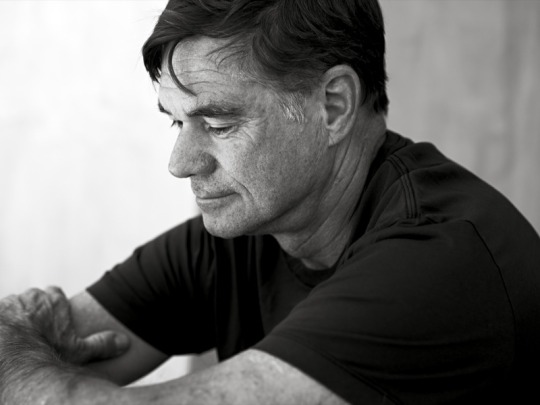
I was somewhat familiar with Gus Van Sant prior into taking the deep dive through his catalog, but he was certainly a man that I thought I had a handle on. I knew he had more than a few amazing films under his belt, but the recent years had not been kind to him (see the shot taken at him in Jay and Silent Bob Strike Back). I knew that he was from the Pacific Northwest��(Oregon specifically), and his coming of age in an area that embraces weirdos and outsiders had an impact on him as a human and as a creator. I knew that films like Milk and Good Will Hunting had taken Van Sant to the highest heights, while the collective panning of films like Psycho and Last Days served as valleys in a career full of glorious peaks.
What I came to discover, however, was a man with genuine creative integrity, and lots of it. I found a director who understood his characters and actors on a human level, and shared them with viewers in ways that helped rich connections develop. I saw a director who was not afraid to make those that society often considers outcasts the emotionally rich and important centers of his narratives. I watched Gus Van Sant present, explore, develop and refine his style over deeply independent and infamously studio-driven projects, giving all experiences as much care and attention as he was able. I saw films I was familiar with find placement behind films I was new to, I discovered that his recent creative years have not been as kind to him as the first two-thirds of his career, and I can see that there still may be a bit of a smolder left in his creative fire.
Ranking directors is a labor of love, but by no means do I consider myself the definitive professional on film canon. I enjoyed all of the Gus Van Sant films I watched on some level, and as always, for those brave enough to interact, I’d be curious to see where you would make adjustments to the list. But enough introduction talk, let’s get into what you folks came for!

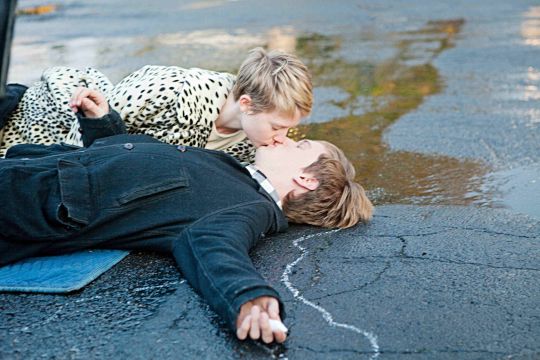
17. Restless (2011) There are things about Restless that I want to love without judgement. First and foremost, Mia Wasikowska is an absolute treasure who shines in this performance from the earlier portion of her career. The portrayal of Hiroshi is one of the more subtle, substanced and interesting ways of using a ghost within the film framework. As minor a thing as it may be to the casual moviegoer, some of this film’s technical aspects are astounding, specifically the costuming and the lighting choices. Where the film distracts me, and therefore drops in these rankings, is where it takes the YA approach to the romantic drama, with a healthy dose of manic pixie dream girl energy thrown in for good measure. When it comes to displaying romance on-screen, be it teenage or otherwise, there are no expectations, even for a director with a distinct style. Where my issues arise are in the way that death is handled in this film… while I do understand that not every film has to be a distinct statement for a director (especially a film written by another individual), Gus Van Sant had already established a very mature approach to the subject of death, and the way that death and the manic pixie dream girl aspects are intertwined feels more on the amateur side than I am comfortable with for a Gus Van Sant film. Maybe giving the impossibly troubled young man a muse with an expiration date as his way to find the best version of himself is a stroke of genius that provides a gateway for deep commentary on the concept of the manic pixie dream girl, but the film is so approachable and not the type to bare teeth (be it satirically or otherwise) that I doubt there is any subtext to its intention. For that reason, this film finds itself on the bottom half of the Van Sant canon.

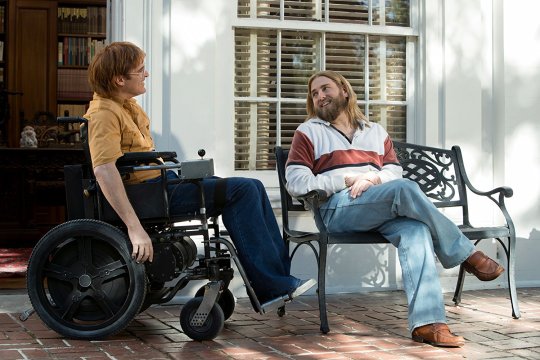
16. Don't Worry, He Won't Get Far on Foot (2018) After the critical and box office disappointment that was The Sea of Trees, director Gus Van Sant had quite the hill to climb with his next film, and with his adaptation of Don’t Worry, He Won’t Get Far on Foot, it seemed he was able to right those respective ships. Strangely, the film failed to connect with me, and as far as I can tell, it seems to be the victim of an “all sizzle, no steak” scenario. The film is certainly a showcase of a very diverse cast, and based on both the flashback-based and group therapy approach to the story, there are a wealth of opportunities to create memorable moments. Unfortunately, and perhaps due to an oversight on my end, I failed to find enough substance during my viewing of the film to prop up the parade of moments. What it felt like I was left with, sadly, was a Simple Jack-level approach to conveying a paraplegic-centered story, which undercut the fact that the film is actually telling the true story of cartoonist, artist and musician John Callahan. That’s not to say that the film doesn’t have it’s positive aspects, such as the John Callahan illustrations and the animated versions of his work, but those positive aspects feel sparse in comparison to how much the film relishes in what feels like Oscar bait. If nothing else, see this film for Jonah Hill, because it took me much longer than it should have to recognize him, partly due to his impressive weight loss and partly due to how dedicated he is to achieving the film’s period look.

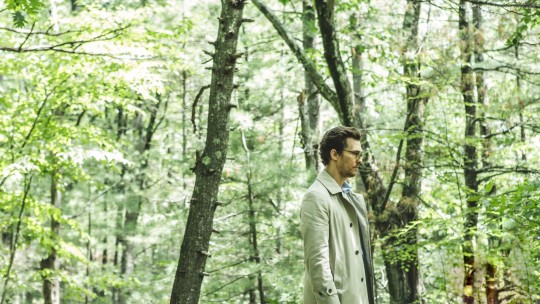
15. The Sea of Trees (2015) Death is no stranger in the films of Gus Van Sant, but I don’t feel that it would be bold to state The Sea of Trees deals with death in the most direct manner. For those that subscribe to grief having stages, this film accounts for all of them in some way, shape or form during the course of the narrative as we watch Arthur Brennan fall apart and rediscover himself in the wake of losing Joan Brennan, his wife. Placing the film in Aokigahara (aka the "Japanese suicide forest") not only gives the film a sense of natural beauty, but a foreboding sense of dread and despair as well. The core cast is as strong as any found in a Van Sant film, with Matthew McConaughey, Ken Watanabe and Naomi Watts all turning in solid performances. Sadly, the film falters in one very core aspect : sympathy for the protagonist. I found myself feeling very bad for Joan Brennan as I watched her arc, and despite knowing nothing about Watanabe’s character portrayal of Takumi Nakamura, I found myself sympathetic to him based solely on what he was emoting. Arthur Brennan, however, is interesting in all the wrong ways… he is extremely cold and purposefully flat when introduced, the moments we share with the Brennans only seem to show Arthur finding joy at the expense of Joan’s pride, his view of the loss of his wife (and his world view in general) seem to be extremely self-centered, and when he does show heroic attributes they are rooted solely in self-preservation. Perhaps if Van Sant had not already made such eloquent reflections on death via The Death Trilogy and Paranoid Park, The Sea of Trees could have been seen in a different light, but when you set such a high bar for your work, returning to stereotypical storytelling can feel flat and uninspired.

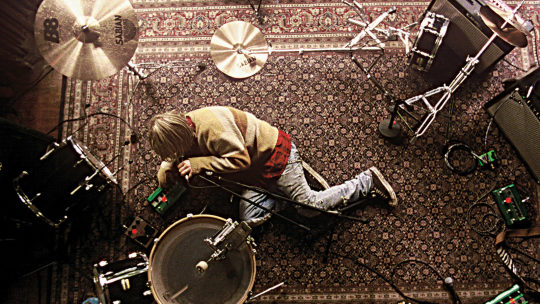
14. Last Days (2005) Last Days is a film with a weird energy and aura surrounding it… in some ways, it feels like the most performative film not only of the Death Trilogy, but out of the entire Gus Van Sant catalog. At the risk of using too negative an adjective, it also feels the most exploitive, though neither of these observations are necessarily meant to be a knock against the film. The Death Trilogy could not help but be exploitive at its root, as each film was inspired by an infamous death event, and with Michael Pitt’s Blake meant to be an avatar for Kurt Cobain, it would be simple to take the film at face value for some sort of glamourized and idealized fictional retelling of his tragic final moments, not to mention a few stylistic nods to iconic Cobain-related imagery. What that viewer would be missing, in my opinion, is a film looking to make some familiar points on outsider culture (specifically alternative rock and roll counterculture and addict culture) minus all the glamour and shine. While Blake’s house is grand, it’s decrepit and in a state of disrepair… despite it being isolated, expected and unexpected guests arrive constantly, not to mention an intrusive ringing phone that connects Blake to outworld obligations… Blake has a number of people living with him, but he almost never interacts with them. Michael Pitt is done up to look so similar to Kurt Cobain that much of the narrative background is implied, and what we are left with is the Death Trilogy style implemented and fused onto a loose leaf narrative with just enough structure to let the supporting actors have isolated memorable moments while we watch Pitt’s Blake decay in the ways that many of us Cobain fans ruminated on in the wake of his sudden and tragic death at the height of his tortured popularity.

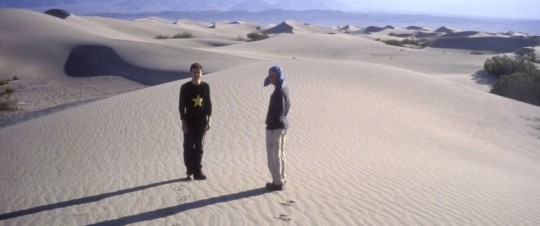
13. Gerry (2002) At the risk of sounding cliché, Gerry may be the most fascinating film in Gus Van Sant’s canon. It marks a clear and definitive break in convention from a director that seemingly never cared too much for convention anyway. Multiple aspects of this film make it extremely unique : both characters referring to one another by the same name (though Gerry eventually evolves into an all-purpose non-specific descriptor), a seemingly absent narrative, a shared goal between the characters literally referred to as “the thing” in order to purposely keep viewers in the dark and, perhaps most importantly, a deliberately methodical pacing that pushes even seasoned film lovers to the limits of their patience. The film is beautiful, and that is a fact that cannot be denied… the painterly shot compositions of our characters in the isolated desert, the unfathomably long tracking shots that pull us deeper off the beaten path and the sonic stillness (due to a largely absent score that is replaced with the sounds of nature) either commit you fully to the experiment or come off as massively pretentious. To view the film through that secondary lens, however, is to miss the point of it all. Once it is understood that Gerry marked the entry point for Gus Van Sant’s Death Trilogy, you began to realize that Van Sant, in tandem with Matt Damon and Casey Affleck, are giving us an understanding of how we should view the trilogy, and how open-minded we should be in processing what is given to us, like some early high-concept version of what Quentin Dupieux would later go on to master in a more abstract manner.

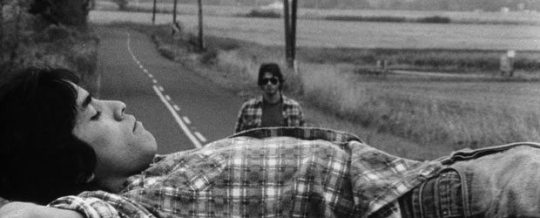
12. Mala Noche (1985) It’s fitting that this was a feature-length debut from a driven and working director, as it has a very distinct look and feel to it that immediately lets you know you’re dealing with an innate storyteller and someone who has spent time observing the human condition. In terms of visual and narrative balance, Gus Van Sant utilizes what feels like a mix of John Cassavetes and Jack Kerouac, respectively. Van Sant’s use of titles in the film is striking, specifically in terms of the handwritten opening credits and the Dr. Pepper ad copy used to subtitle the Spanish language dialogue. Focusing so heavily on immigration and homosexuality in 1985 is a bold choice, especially as neither group had yet to benefit (even if only minimally) from the onset of politically correct culture policing. While the film was more than likely shot in black and white due to budgetary constraints, the infusion of somewhat modern elements (for the time) gives it a youthful and forward-thinking energy. Having a film of this nature lean so heavily on multilingual and multicultural elements is refreshing, and even more impactful when examined under the boorish and (at times) tone deaf application that humanizes these elements. For all of these aspects of the film, however, when examined at the pure narrative foundation, what we find is a story about how love can blind us from the reality we inhabit, and how we often choose to ignore the obvious when romance and romanticism enters the picture.

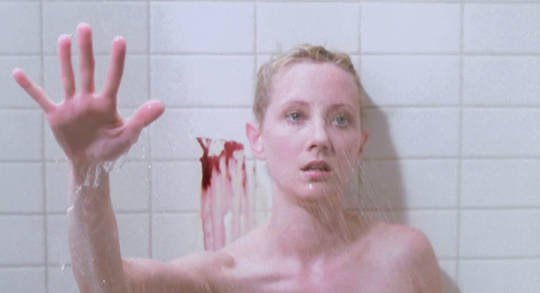
11. Psycho (1998) Of all the films in the Van Sant catalog, perhaps the bravest, boldest and most baffling entry is his nearly shot for shot remake of the iconic Alfred Hitchcock thriller and cinematic game changer Psycho. Remakes were certainly not a new or unheard of practice at the time of the Van Sant Psycho release, but most directors opt to put significant twists or updates into their retelling of most remakes, and most films chosen do not hold the lofty stature and position that Psycho does when it comes to remakes. Van Sant’s approach not only made viewers keenly aware of just how direct the homage was, but in some places, modern touches were added in very subtle ways to make the movie more palatable for modern audiences, including more salacious references to sexuality, sound design choices in both the diegetic and symbolic realm, and even an update or two to iconic scenes meant to make us much more uneasy with the Vince Vaughn portrayal of Norman Bates. The actors cast were all famous and respected enough to keep the film’s timeless feeling in-tact, even if the remake could be taken as its own weird and warped project. Personally, I’ve always loved this remake, and taken it as an experiment on the highest commercial level, and a signal to all that Van Sant (at the time) was done with the traditional approach to filmmaking and concepting.

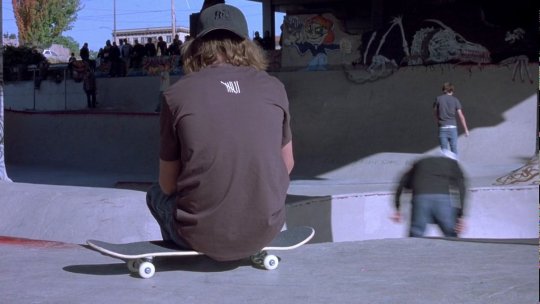
10. Paranoid Park (2007) While many movies centered around skateboarding spend their time and design budget trying to make the outsider nature of the practice look “cool”, Paranoid Park spends its time making sure that the isolation, deep focus and rebellious attitude that come with skateboarding were more authentic than they were appealing. High school is already a very taxing and polarizing section of juvenile development, and based on your perception at the time, the weight that the world unloads on you can feel wholly unbearable. Perhaps this is what makes Paranoid Park such a tense film… that natural teenage angst is already imprinted into the film (and amplified due to the casting of relative unknowns), but Gus Van Sant’s signature use of alternative film stocks, obscure soundtrack and expressive, layered sound design but you square in Alex’s head from the opening moments. As the narrative unfolds, we realize that Alex is not only dealing with standard-issue teen stress, but has unwillingly found himself involved in the type of events that change an individual’s world. This film plays well as the first film post-Death Trilogy, as it deals with the gravity of mortality head-on much like the aforementioned three films, but does so from an adaptive stance rather than one based on true events. If you’re a fan of skater flicks, movies with strong teen acting, or little-known Gus Van Sant gems, then Paranoid Park is a gem waiting for discovery.

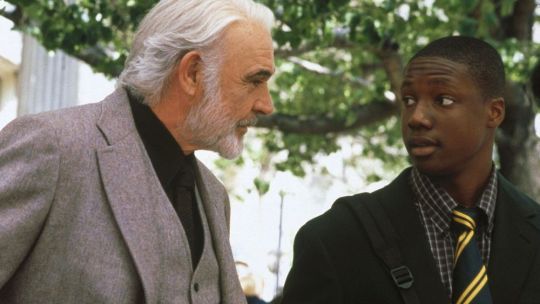
9. Finding Forrester (2000) Gus Van Sant has always had a way with stories that dive below the surface of the human experience and condition, so it makes sense that his attempt at a New York-based movie about people living in “the hood” would cover an array of topics with masterful subtlety, specifically the topics of race relations, generational gaps and the blurry line between education and exploitation. The casting on this film is extremely strong… then newcomer Rob Brown gives a riveting and dynamic lead performance, it’d be harder to cast a more perfect curmudgeon than Sean Connery, and appearances by F. Murray Abraham, Anna Paquin, Busta Rhymes and a Matt Damon cameo all stand out. Speaking of Damon, Finding Forrester shares a similar energy to Good Will Hunting, but the proximity of release ultimately held Finding Forrester from finding its proper audience (no pun intended). I wish I had more to say about this film outside of my personal feelings and connections to the story (which I will save for a dedicated deep dive in the future), but Finding Forrester is one of those films that has no trouble speaking for itself.

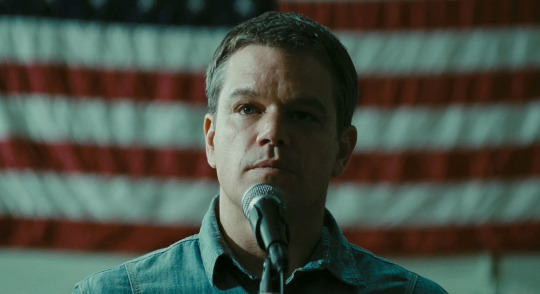
8. Promised Land (2012) As of the point that this blog post was created, this film stands as the last of the great Van Sant creations. There is something about the Gus Van Sant approach to filmmaking that works best with “salt of the Earth” types, and with Promised Land being centered around the practice of fracking, much of that down-home nature is immediately baked into the story. Speaking of the story, the film was co-written by the characters who ended up being the protagonist and antagonist of the picture, respectfully, which created an electric main dynamic that served as the spine for many other strong dynamics present in the film. In terms of the cinematography, much of Van Sant’s bold approaches and stylistic shifts are absent, save for a few beautiful bird’s eye view perspective shots that give you a real idea of what rural America looks like. Van Sant is no stranger to stacked casts, but he gets some truly top notch names to take part in this affair, and true to the clout behind these names, the performances are as stellar as they are believable and natural. The film also touched a nerve with the actual oil industry due to some of its comments on fracking, despite it not having the reach or success of other Van Sant films. While possibly an indicator that Van Sant would be making a stylistic shift, Promised Land still manages to capture what makes Van Sant his best self in terms of not only presenting real people, but topical and important situations.

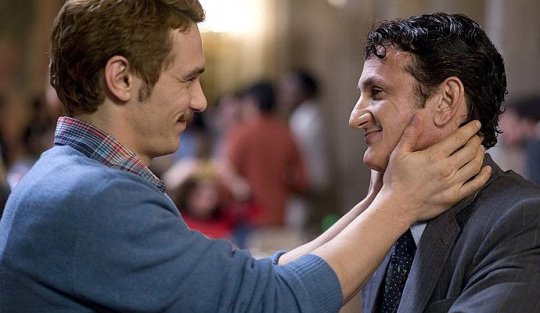
7. Milk (2008) Gus Van Sant is clearly no stranger to having representation for the gay community in his films, so it makes sense that one of the hallmark films in his canon would center around gay rights activist and politician Harvey Milk. Much like JFK crystalized Oliver Stone, or Spike Lee was raised to another echelon by Malcolm X, Van Sant found a second round of Academy Award-level validation via this biopic while solidifying himself as a creative who could go back and forth effortlessly between big budget studio films and independent projects. With Sean Penn giving one of his signature chameleon-like performances and leading the pack, this Van Sant production is filled with tons of burgeoning talent who have since gone on to make names for themselves in the industry, including the likes of Emile Hirsch, Diego Luna, James Franco, Alison Pill and others, plus a standout performance from Josh Brolin (who also depicted George W. Bush in the same year for the aforementioned Stone). While it may not be the most technically marveling film of Van Sant’s career, it is clearly one of his most important, and the way that it handles the messages it intends to share is as confident as it is even-keeled, which is important for a film that could have easily become a soapbox for espousing personal beliefs and political agendas.


6. Even Cowgirls Get the Blues (1993) This Gus Van Sant adaptation of the famed author Tom Robbins novel shares the same creative energy of films like Fear and Loathing in Las Vegas, Natural Born Killers, Harold and Maude and so on in the sense that it is a very expressive film with a very specific idea it is looking to present. Where the aforementioned films explored ideas of free love taken to the extreme, the toxicity of media, love without judgement and so on (respectively), Even Cowgirls Get the Blues puts femininity and identity outside of the male gaze squarely in its crosshairs. Uma Thurman takes on the role of Sissy with wide-eyed zeal, floating through a series of hitchhiker-based adventures until her reluctant visit to the Rubber Road Ranch helps her find the missing piece of her puzzle. Seeing a bizarre, star-studded tale of a woman finding her agency sounds like it would work on the surface, but from what I could find, the film failed to make a connection with audiences and is considered a commercial and critical failure (which is probably why it was the toughest film to track down on this list). That being said, I’m a sucker for films that catch a bad rap, especially when the combination of such a unique director and visionary author are the foundation of it, because it makes me curious about why I find connection where others did not… who knows, maybe it was those extremely distracting rubber thumbs (the only real knock I can make on the film), or maybe the Tom Robbins style is tough to transfer from page to screen, but for my money’s worth, I can see the vision.


5. My Own Private Idaho (1991) Somewhere within the intersection of films like Midnight Cowboy and Fight Club lies My Own Private Idaho, an extremely personal and nuanced film that covers many topics with depth and an ease that comes with wisdom and experience. For example, when it comes to views on identity, we get two rich narratives that could easily both be their own film : Mike (portrayed by River Phoenix) is going through a crisis of identity based on a sordid history with his mother and absentee father that makes his search for love transform into a life of hustling as a way to find momentary intimacy; meanwhile, Keanu Reeves (who plays Scott) is an entitled young man awaiting an inheritance that decides to spend the time until it happens “slumming” with those many would consider the outcasts of society, much like the “tourists” spoken of by Edward Norton’s narrator in Fight Club. The struggle with masculinity in the face of homosexuality is all over this film, from its multiple male on male connections to the very toxic manner that the core group interacts with one another, when they are not grieving or putting their livelihood in danger via petty crimes. In terms of Van Sant style, the film is one of his most innovative (outside of the film holding the top spot) in terms of looks, with its unique range of colorful title cards, the pinhole vision that Mike uses on his road, or even the standout magazine rack sequence. The film is also a perfect follow-up to Drugstore Cowboy, and could easily double feature with it to this day. As someone not wholly familiar with Shakespeare’s Henry plays, I did not catch that My Own Private Idaho was an adaptation, so I will not only have to revisit it with that familiarity in tow, but I will have to take a look into James Franco’s re-cut, My Own Private River, as well.

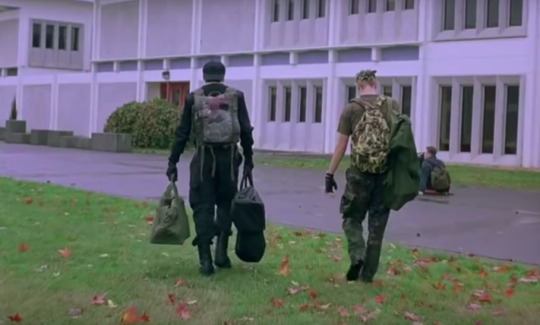
4. Elephant (2003) Based solely on the nature and definition of a trilogy, a second film can make or break things. Gerry and Last Days share similarities in how quiet and isolated they are, so it makes sense that Elephant, part two of Van Sant’s Death Trilogy, would in many ways be the meat of the trilogy sandwich in terms of style and thematic substance. Elephant operates on several distinct levels based on Van Sant’s observations of the world going into the new millennium, as the film allowed him a foundation for both experimentation and examination by proxy. While the long takes and vast amount of distance traveled during said takes was present in all three films of the trilogy, Van Sant made a concentrated effort to make the shots look and feel similar to that of video games like the later Grand Theft Auto entries, hence a number of the shots being positionally locked during travel (often times a few feet behind the character at the center of that moment’s focus). There are ramp-downs of the frame rate to punctuate certain moments, and quite often the camera is thrown on a tripod and allowed to take in the array of high schoolers living their standard life. It is this mundane world-building aspect that not only gives the viewer a rapid but deep look into a handful of character’s lives, but it gives you a sense of the school’s social hierarchy while forcing you to reflect on where you once stood within it. Per the film’s clever title, the elephant in the room eventually appears in the form of Eric and Alex, the pair of school shooters meant to reflect the Columbine Massacre perpetrators. While school shootings weren’t an unknown phenomenon going into the 2000’s, Elephant became prophetic in its vision by releasing right before the numbers started rising at an alarming rate on these incidents. In that sense, Elephant holds the dual distinction of not only being one of Van Sant’s best films, but one of his most important. I will soon be looking into the 1989 Elephant film as well.

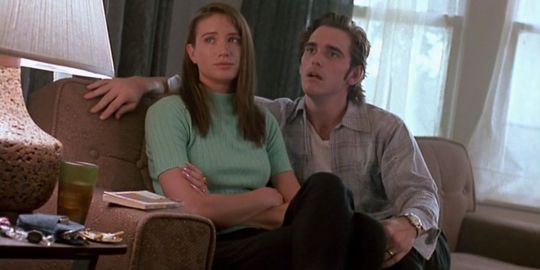
3. Drugstore Cowboy (1989) The power of Drugstore Cowboy as a modern-day narrative tragedy about the epidemic of prescription drugs, the dark allure of crime and the oddball way that broken people find solace in one another is immediately evident to anyone who has had the pleasure to see Gus Van Sant’s studio directorial debut. Where the film really stands out however, in my opinion, is the way that Van Sant is able to achieve his major studio look while deeply applying a very artistic and personal aesthetic to the cinematography and editing. The traditional looks are interspersed with the use of different film stocks, subtle blends of animation and flashes of stylistic edits that were almost certainly an inspiration for Darren Aronofsky’s “hip-hop editing” style. Add to this an incredibly intuitive and expressive core cast driven by the chemistry between Matt Dillon and Kelly Lynch (and a very early Heather Graham supporting appearance), plus a strong appearance by the always memorable Max Perlich, a fiery James Remar performance and an iconic cameo from William S. Burroughs. The jazz-influenced score not only makes key scenes livelier, but it is a symbolic statement on the drug use depicted in the film, while simultaneously playing counter to the soundtrack choices. Period, point-blank, Drugstore Cowboy is the kind of film that surely put the world on notice, and was a clear signal of the magnificent work that would follow.

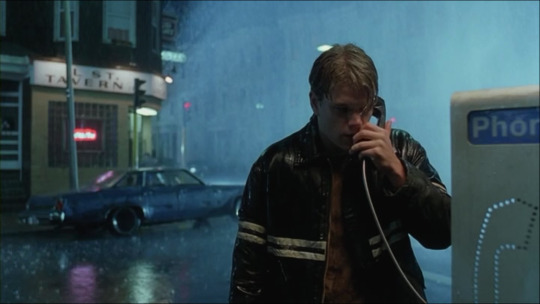
2. Good Will Hunting (1997) If held up to the standards of what people consider to be good (or even classic) film, Good Will Hunting more than holds up to scrutiny. Visually there are a small handful of flourishes, and having Elliot Smith’s music accompany Will’s painful but enlightening journey has only become more of a bittersweet sting as the years go by. In terms of performances, everyone brought their A+ game to the table, be it the leading performances of Matt Damon, Robin Williams or Stellan Skarsgård, the supporting performances of Ben Affleck or Minnie Driver, or even the engaging nature of Cole Hauser and repeat scene stealer Casey Affleck. After a flurry of dedicated fandom viewings in the years following this film’s release, a very long period away from the film where I had leagues of personal growth, and a revisitation for this set of rankings, what I have discovered is that Good Will Hunting presents a wish fulfillment fantasy that was nearly incapable of being a reality in the pre-internet age for anyone other than a character like Will : an undiscovered genius with a degree from the school of hard knocks. In a world where people often wish they had the correct answer to every question, the looks and personality to be a social magnet, and the ability to back up any tough talk with stone hands, Will Hunting stood as an idealized example you wished you could peel off the screen and have some beers with. As the internet has invaded our lives, however, most everyone has turned into a keyboard version of Will Hunting, looking for fights online when not having briefly intimate Google sessions to flex our supposed knowledge. Much like Will, many people find that the knowledge minus the wisdom of worldly experience and vulnerability leaves you a shell of a person filled to the eyeballs with regret, and perhaps that is why this film only gets better as the years go by, and remains among the best of the Van Sant creations.

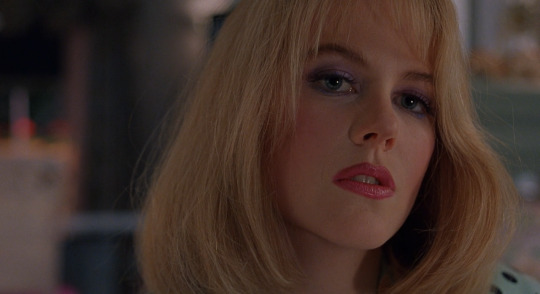
1. To Die For (1995) For the longest time, I avoided To Die For simply because I was not a fan of Nicole Kidman… the vast majority of her roles held no interest to me prior to To Die For (it took Eyes Wide Shut for me to really start paying attention to her), and because she was so key to the film, there was never a sense of urgency about seeing it. As time went by, however, I started to hear rumblings that To Die For may have been a bit ahead of its time, to the point that technology and social practices have caught up to some of the ideas presented in the film. I finally watched it for this ranking set, and man, I really missed the boat on this one. Plain and simple, this film is pure genius on every level. The presentation starts off documentary-esque, which not only allows for expedited distribution of backstory information, but immediately gives you an idea for the personalities of our key characters. Kidman’s portrayal of Suzanne stood as the textbook example for what has become commonly known as sociopathy, with her blind desire for fame and respect leading to a wake of human destruction. In terms of narrative pacing, the film proceeds like a match dropped at the endpoint of a long gasoline trail, slowly drifting towards the eventually point that everything blows up and damage must be assessed while blame and accountability must be handled, resulting in a truly powerful ending more than deserving of the heavy lifting that precedes it. The 24-hour news cycle was on the horizon in 1995, daytime talk shows and MTv’s The Real World had not shifted into the reality TV landscape that we know today, and while a few high profile cases such as the Menendez Brothers and Pamela Smart trial (the loose inspiration for this film) had happened, the bombshell and watershed trail that was the O.J. Simpson murder case was hot on the heels of To Die For’s release (the same month, actually). Stylistically, the film also bears striking resemblance to an updated version of Sunset Boulevard, be it knowingly or not. Long story short, the best films not only comment on the times in which they are created, but gain relevance as time passes, and To Die For handled both of these things phenomenally.
#ChiefDoomsday#DOOMonFILM#GusVanSant#MalaNoche#DrugstoreCowboy#MyOwnPrivateIdaho#EvenCowgirlsGetTheBlues#ToDieFor#GoodWillHunting#Psycho#FindingForrester#Gerry#Elephant#LastDays#ParanoidPark#Milk#Restless#PromisedLand#TheSeaOfTrees#DontWorryHeWontGetFarOnFoot
22 notes
·
View notes
Text
I appreciate you trying to cut down on the reblogs, and your continued well thought-out responses!
Snoke
I'm going to cut to Snoke real real fast because I really don't think that you're reading the scenes he's in in TFA in the proper perspective--
--there's no "film language" evidence that they were really trying to make you guess and wonder about Snoke. Some wondering, yes. Some mystery, yes. But certainly it was not meant to take up any more headspace than the Emperor did in the OT. Certainly not.
Do you know why? Because compare how Snoke is introduced and how much is said about him to other characters. You can tell who the filmmakers wanted you to really, truly wonder about--and it's Kylo Ren.
Everything, from the scene blocking, to the music, to the costume choices, to what every other character says about him, to how much time those other characters are given to audience-surrogate-wonder about Kylo Ren, points to just that: the audience is supposed to be trying to figure this guy out. Lor San Tekka makes his little comments before Kylo Ren cuts him down. Leia and Han have an exposition-tidbit conversation where you get tantalizingly broad-strokes explanations for why the son of a redeemed smuggler and beacon of hope turned to the Dark Side.
Heck, the first scene Snoke is ever mentioned in, at all, is a scene specifically written to tell the audience more about Kylo Ren, not about Snoke himself. It's about "how does this Kylo Ren guy relate to this Hux guy? Oh, he cares more about the droid and the map to Skywalker than he does defeating the resistance, because that's contrasted against this 'Supreme Leader Snoke' guy's orders to destroy the droid if necessary."
More evidence: the first scene Snoke is ever in, that he ever even speaks in, is the one where the audience is teased with--no significant tease about Snoke--but about Kylo Ren. It's the very first big chunk toward the Kylo Ren mystery, and Snoke is the one to introduce it: "...your FATHER, Han Solo."
Yes, you can learn some things about Snoke in that scene. He's disfigured, he's old, he's imposing, we can barely see him, etc. But they're not the kind of "things" that are used to make an audience want to learn more--at least, not more than they're intended to want to learn about Kylo Ren.
Even the lighting in that scene, Snoke functions as a prop. When he's there his hologram blocks the only light source in the room. When he's not, a beam is free to fall, and has Kylo Ren standing alone, in a spotlight --and in that spotlight, he's solitary on the left side of the screen, near the lower-third, in a beam of light, surrounded by darkness, and the space--the space where Snoke used to be--is left empty. The composition of the shot is totally unbalanced. Subconsciously, the visual makes you wish someone else were standing in that empty space, across from Kylo Ren.

Oh wait.

It's Rey.
I could yammer on and on about film language and shot composition, but the point is: "Darkness rises, and light to meet it." That's Snoke's line. That's Snoke's whole point. That’s all. How interesting he is only goes so far--because his point, as a character, is to make space for the audience to focus on Kylo Ren, and by extension, Rey.
There is no evidence that the filmmakers ever intended for you to care more about Snoke beyond what he brings to the table as a big arrow pointing back to Kylo Ren. And his death lights that arrow up so effectively. And since that’s the point of the arrow in the first place, his death was the perfect thing.
Now.
I agree that Kylo Ren as the big bad was not the answer. But a very strong argument can be made that TLJ was not setting him up to remain the big bad. Because: every scene with Hux, who is introduced as "the guy who hates and is surprisingly not afraid of Kylo Ren." Combine that with where Kylo Ren’s head is at, and how far his entanglement with Rey and his motives have progressed by the end of TLJ? And you do not have a recipe for him remaining the big bad for very long.
Now that I'm done harping on Snoke, back to the main argument.
Finn
I hear what you’re saying, but I don’t see how you got there. Not from what’s actually in the movies.
Here's the thing: I believe that when we watch a movie, we should believe what the filmmaker is telling us about the characters—based on the evidence they put in the film. Now, if what they put in there is contradictory, (which I thought was your initial argument) obviously then the filmmaker is doing a bad job, they've broken our trust as an audience, and the whole thing starts to feel like an exercise in futility.
But when I said that Finn is fighting Kylo Ren at the end of TFA, not as an attempt to "try" to do anything, but to vent his anger at the injustice and oppression and cruelty of it all--I gave evidence for how I got there. To repeat myself:
Evidence A: What we know Finn's worldview and entire character flaw is--he doesn't believe good can win.
Evidence B: We've only seen him fight back one other time, and it was in a slightly-similar situation; Takodana, the First Order just destroyed the Republic and Maz's castle, and some random Stormtrooper is calling Finn out as a traitor, proving they haven't forgotten about him and, in some sense, they'll always find him. That makes Finn angry--because he believes he can't win, nobody can, not ultimately, and they won't even let him run away. So he fights back. With an angry expression.
Evidence C: Finn does not work with the Resistance with the ultimate goal of "finally trying to resist," which, since he's already been in one fight before (revealing, in due progression, that he can stop running in key circumstances) could have been his response. But it isn't. "I don't [know how to deactivate Starkiller's shields.] I'm just here to get Rey." There is nothing in the forest on Starkiller that would cause his character to move from "angry at the unstoppable evil" to "believing it's better to resist than run."
Finn does not know that Rey will get up. Ever again. <- I just made a truth statement, and here’s my evidence for it:
That is very clear when he openly turns his back to the guy with the lightsaber to run to her and have that whole reaction, as if she's the only thing worth thinking about in the world, while she's unconscious. Something pretty devastating and grief-inducing has to be happening for the guy with the escape-mentality to turn his back on the monster with the lightsaber. And that devastating thing is: she flew twenty feet up in the air, hit a tree and fell twenty feet down again, and she’s not moving, and she’s not waking up—in that moment, he doesn't know if she's going to wake up ever again.
So there is no way to use "he was trying to resist long enough to distract Kylo Ren so Rey could help" as an argument for his supposed "new some-kind-of-resistance mentality." He doesn’t know she’s going to get up, much less that she or anyone has a chance of being helpful.
All the evidence in the film up to that moment (what other characters say about him, what he chooses to do versus what he chooses not to do, and most importantly, WHY he makes any of those choices) points to the fact that Finn is not fighting because he believes evil can be defeated.
And that is the point.
The movie says, "at least he's not running away. But he's still got a ways to go."
Just like how Luke begins to trust the Force, enough to switch off his targeting system, in A New Hope. But he doesn't jump straight to "trusting that he can also lift giant spaceships out of swamps" or "trusting that if he finishes his training and believes in The Cause, it'll be better for his friends than rushing off to rescue them."
There is evidence in The Force Awakens that when Finn stops running, he still hasn't resolved his problematic worldview. He's still believing that "There is no fight against the First Order. Not one we can win."
Therefore, he tries to get in the escape pod to save Rey in TLJ.
Therefore, he's not despairing when Canto Bight officials find him and Rose, because at least he got to wreck their city.
Therefore, he's willing to ram his mining speeder and blow himself up to take out one cannon--with a furious expression--while Poe and Ross try to call him back--because at least “they won't win” in the moment. He still doesn't believe they'll win the ultimate fight, but he can make them hurt in the moment.
There's evidence for that progression in both movies. And the pacing is good; he has a whole third movie to live out what he just learned: "We can win the ultimate fight, if we focus on saving what we love, instead of the reactive raging against a cruelty we think is inevitable."
But I’ve said all that already, let’s talk about what you’ve said!
Listen, even if what you're saying were true--that Finn goes from "we can't win so I have to run" --> "we can't win but if we can't run it's better to die trying," …you still haven't proven how TLJ messes that up.
I've made my point. Now let's see if we can make yours.
TLJ starts where you claim TFA leaves off: "we can't win but if we can't run it's better to die trying." What's the problem here? He tries to run to get Rey, and he can't, because Rose tazes him. Then he sees that he can still run--with the whole Resistance, running--if he can switch off the light speed tracker. Then he fails and the First Order catches up and so--if he can't run, it's better to die trying. Right?
And then he learns what Rose tries to teach him from the very first moment they meet: his worldview is still wrong. They can win. He just needs to move his goalpost from fighting what he hates for the sake of hate to saving what he loves, which is better than dying-trying.

Do (save your friends) or do not. There is no "try!" (Sacrificing yourself for a moment, against one cannon, is no guarantee that you're saving what you love in the long run. It's just dying "trying.")
See? Even if I come at it from your point of view, there's nothing wrong with TLJ. In fact, even from your point of view, there’s a lot right with TLJ. It takes the next logical step in Finn's progression, and saves the best object-lesson he needs to learn (Rose's sacrifice) for last, so that you can't even fault it for leaving him with nothing to do in the third movie--he got the lesson, now let's see what he looks like when he lives it out. No step backwards. None.
Poe
The narrative does not tell you that Poe is wrong specifically for wanting to save lives. The narrative tells you that Poe is wrong specifically for wanting to save lives only one way; with the in-the-moment stand-and-fight hero action.

He needs to learn that being a hero has more to do with faith than it does control of the moment. That sacrifice is only sacrifice if you actually manage to accomplish something meaningful for someone else.
What happens on Jakku and what happens with the dreadnaught are not opposite actions. They are different scenarios--but the reason behind Poe's actions are the same. A hero saves lives. But how the hero does it, that's what Poe gets wrong. And he gets it wrong the same way both times.
Even if you characterize Poe as needing to learn "he alone is not the difference between success and failure," (which I don't think quite covers it, but nuance 🤷♀️ ) TLJ is still a great story for teaching him that lesson.
You haven't explained how it's not. You've only explained that you didn't like it. You "feel like he's smarter than that." Smarter than what? Smarter than what, that you’ve seen of him from the movies?
When Poe made the decision to attack the dreadnaught, everyone seems to forget that nobody in the Resistance knew they could be tracked through light speed. Therefore, Poe was not making that stupid of a decision, throwing all their bombers at the dreadnaught. Not from his perspective. Not even from Leia's perspective! Taking out a dreadnaught was a great thing, a good thing.

But the point, which Leia is making even before she knows they've been tracked, is that no, Poe isn't stupid--but the ends don't justify the means. The why behind his bombing run decision was bad. The how he accomplished his mission was bad. It demonstrated a lack of faith that there could be other ways. It demonstrated too much focus on a mindset where, as you say, "if he doesn't give everything," every time, they'll fail.
But maybe you meant, "I just feel like he's smarter than that" Or "his conclusions don't fit" about his reactions to Holdo, specifically?
Well, why don't they? What, in the movie, makes you think any of his decisions were illogical or unintelligent?
Remember, all the information Poe has is:
All our other commanding officers are gone, so this Vice Admiral is in charge, even though she clearly wasn't part of the command before.
She just gave a speech but didn't say anything of substance about what we're going to do? She just said "we must survive" is our mission. (Not "we must fight, or we will outsmart them," or anything I or what I believe Leia would've said.)
She won't tell me the plan, and also she just insulted me, borderline called me a traitor; me, the guy who blew up Starkiller base, the guy Leia trusted with plans.
She's not doing anything active to stop the Flagship from tracking us, and they can track us through hyperspace. I sent Finn and Rose off to solve the problem; meanwhile, she is not doing anything active like that.
We lost our support ships and our fuel supply is low. Still she's not updating me with the plan.
She's fueling up the unarmed, defenseless transports, but there's nowhere to go; therefore, she just wants to abandon ship and last as long as we can with no destination.
The transports have no weapons and no shields; meanwhile, our big ship at least has both.
I was up-front with her about Finn and Rose, which is a long shot plan, but it's more of a plan than "abandon ship and get picked off while we have no destination:” she reacted badly to it and still wants to abandon ship.
She's doing everything she can to stop us from my escape plan just because, from what she said, “it’s risky.”
Let's review what Poe does not know.
There is an uncharted mining planet nearby, so the transports actually aren't floating with nowhere to go.
The transports can't fight back but they can actually cloak, which is ONLY useful if they have somewhere to go (which they do.)
On that mining planet is an abandoned rebel base.
Abandoned though it may be, it is heavily armored and powered enough to send a distress signal all the way to the Outer Rim.
If any Resistance members are somehow captured and happen to also know what Holdo's plan is (like Finn and Rose do, because Poe told them) then the First Order could ruin the plan--by running a de-cloaking scan.
⬆️ Poe doesn’t know any of that. Given what he knows, versus what he does not know, then combining that with who he is and what he believes heroes do--plus the fact that Holdo and Poe's personalities are engineered to rub one another the wrong way--all of that equals "consistent, in-character action."
You know what it does not equal?
It does not equal a lack of smarts. Or lack of relatability.
Poe did the best he could with the character flaws and strengths that he has--bravery, straight-up guts, ingenuity, confidence...but he didn't know what he didn't know. Which is where trust is supposed to come in. But he didn't know or like Holdo, and her leadership style seemed antithetical to what he believes heroes do, so he chose to trust Finn and himself instead.
Not stupid. In-character. Young, brash, inexperienced, except in last-stand moves. Needing to learn a particular lesson. But not unintelligent. Not even illogical--his logic makes sense given the information he has.
Now, could he have made other decisions based on the information he had? Absolutely. That's one of the main ideas of the movie, and one of the main discussions around faith in philosophy at large:
“More than one thing is true at a time.”
So, do you take those truths and make a faith-based decision, or a fear-based decision? If so, what are you putting your faith in? Your ability to control as many variables as you can see in the moment? That’s fear, or pride, or both. OR, do you put your faith in what you can't control: things like your friends, your protégés, your commanding officers? The goodwill and rebellious spirit of people across the galaxy that you haven't met but hope are out there? The will of the Force?
Poe knew the things on the list that I made above.
But. Poe also knew other truths, too.
He knew that Leia had worked with Holdo in the past, and trusted her. Poe also knew that Leia had criticized him for thinking too narrowly, instead of like a leader; she demoted him, for a reason. Poe also knew that there was a lot he didn't know. But instead of making choices based on those facts, he made them based on other, simultaneously-true facts.
More than one thing can be true at a time—again, the question is, what will you act on? Will you choose humility and trust, or not?
Same themes with Luke.
Luke knew some truths.
Ben is extremely powerful because he's a Skywalker.
Ben has great potential for good.
Ben also has great potential for evil.
Ben has darkness in him.
That's not all Ben has in him.
Snoke had turned his heart.
Anakin's heart got turned, too, but Luke had experience turning it back.
Ben could cause pain, destruction, the death of everything Luke loved in the future.
Yoda also said "always in motion, the future is."
He can’t have any future if Luke kills him.
Luke could've made several decisions based on any of those truths. For a moment, he considered making the wrong decision, based on those truths. Then he checked himself.
But it was too late. Why? Because Ben Solo knew some truths.
My Uncle is standing over me with a lightsaber.
My Uncle sensed the darkness in me.
My Uncle is definitely afraid of me. Just like my parents, who sent me away.
Also, my Uncle is my Uncle. He loves me, and if not me, he loves my mom and dad; probably not likely to kill me.
He's saying "Ben, no!" which isn't something people who want to carry on a fight to the death usually say to their opponent.
My Uncle can't fear me or threaten me if I kill him.
Ben Solo could've taken any of those truths and acted on them. He chose to act on the stuff he could control right away. Didn't have to. But he did.
Rey knows some truths. Finn knows some truths. Rose! Rose knows some truths, and it is beautiful to look at what faith-based decisions she makes in this whole movie. But you see my point…
…and one of the running sub-points used in this well-structured movie to point back to the Star Wars Main Point: "Faith Triumphs Over Fear."
It still looks to me like we could almost agree on Poe's worldview, or get close to it--you just don't like that his worldview combined with his circumstances cause him to make the choices he makes, which says more about what you wanted than how well the film tells a story.
The film never promised you the things you began to want. Not based on our discussion so far, or what’s in the film.
TFA didn't set Poe up to be right all the time, or careful, or even considerate. It also didn't set him up to be stupid or unlikeable. And TLJ continued both those sets of characteristics: not careful, not right all the time, not considerate, but still not stupid, still not unlikeable.
Unless you're an audience member who...forgive me, I'm not meaning this any type of insulting way...misunderstood him at the start, and therefore expected something different of him, and therefore were pre-disposed to dislike him once you saw more of who he was already set up to be.
(I'm not insulting you or your perception skills; I misunderstood La La Land before someone pointed out where I had blind spots. Luke misunderstood his role until Yoda pointed out his blind spots 😂)
Another day, another looking forward to hearing from you again 🫡
Idk how TLJ can be viewed as a continuation of TFA when it barely keeps the same themes, all the characters act differently, and it barely picks up on any of the story threads TFA left off
#Star Wars discourse#discourse#the last Jedi meta#the last Jedi#very long post#I like discussing this with people like you
75 notes
·
View notes
Text
unmended
For FFxivWrite2021 Day 8, “adroit”. Mid-Shadowbringers but end-of-5.0 spoilers, about 1100 words. This is gen like Shadowbringers itself is gen.
Emet-Selch observes the Warrior of Light, and considers.
“What do you think?” Minfilia dips a spoon into the pot dangling from their improvised roadside stove and holds it out to Frydlona.
Frydlona takes it as if they have no more serious considerations than the composition of their rations, quite as if her soul is not already brightening with the promise of the next rejoining. She tastes it, then closes her eyes as if she is listening to something other than the twittering of birds and the droning of insects: as if the food itself is a song in her mouth, and she needs only to separate its tones to blend them in better harmony.
Something is bothering Emet-Selch about this hero. Oh, it isn’t just her dogged optimism and her ignorant loyalty to the shards that inhabit this pitiful, broken star—though that would be enough to drive any reasoning person to distraction. It is…
He cannot, exactly, define it. That is an experience worth being bothered about, as well.
“It’s good,” Frydlona says, giving Minfilia a smile.
“Oh, good.” Minfilia sits carefully on a log, her dress practically gleaming. A pretty little harbinger of Light—say what one will about Vauthry, and Emet-Selch is happy to, he nevertheless employs excellent tailors. Minfilia harmonizes pleasantly enough with the landscape. “Thancred doesn’t really care what he eats, and Urianger doesn’t really notice what he eats, so I’m very glad this is all right.”
“I’m sure it’ll be wonderful,” Alphinaud tells her.
He is irrelevant, and so are the rest of the shades. Emet-Selch goes on considering Frydlona. The barbaric draperies she has chosen to costume herself in are a clever piece of design; it would please her to know Emet-Selch thinks so, and so he will be sure not to tell her. He might tell her they flatter her, which is true but will please neither her nor the Exarch—so determined to keep his Warrior of Darkness away from the terrible Ascian’s influence and yet so helpfully gift-wrapping her and the rest of the First for delivery. Perhaps Emet-Selch should wait, not until he next makes himself visible to the Warrior of Light and her unmerry band, but until the Exarch is there as well.
“Speaking of Urianger,” Frydlona says, turning to the man in question, “you tore your robe while we were fighting that leshy or whatever it was earlier.”
“Ah, forsooth.” Urianger considers the skirts of his robe, and Emet-Selch does as well. It is nearly as dark as Frydlona’s, but with far less of a suggestion that its wearer is prepared to kick one in the face. “If it is not an imposition on thee, wouldst—”
Frydlona has already turned away from him to rummage through the pockets of her traveling bag. “Go on.”
Urianger rises and disappears into one of the tents. In his absence, Frydlona quickly unearths a leather envelope, a cloth bag, and a small metal box with a close-fitting lid. Whatever is in the box rattles faintly, as if muffled. By the time Urianger returns, in a singularly unflattering nightshirt with his robe neatly folded in his hands, Frydlona has spread a piece of canvas on the ground and seated herself cross-legged with her tools within easy reach.
It is a quick performance. Emet-Selch had few dealings with the backstage side of any theatrical companies, but he suspects them of a similar rush to mend.
The leather envelope contains a smaller strip of leather pierced by needles, as well as a pair of shears and several small pairs of…two of them appear to be pliers of some sort, and one looks like an unusually fierce nail-clipper. One could improvise a reasonable torturer’s kit from Frydlona’s tools, if one had to.
Frydlona shakes out the robe, mapping the tear first on the right side and then on the wrong side. “One of the chains got broken, too. They’re not magicked themselves, are they?” She rests her fingertips lightly on one of the dangling baubles, eyes distant. “The ones on the belt, I mean; I know your jewelry is.”
“Nay,” Urianger says. “Yonder ornaments serve merely to focus the mind and elevate the spirit.”
She nods and opens her bag, from which she produces a pincushion and a spool of black thread. They are on the side of the road in Lakeland, with monsters in every direction and the Rak’tika Greatwood a broad smudge near the horizon, but she pins the tear together as calmly as if she were still at the Crystarium, or even on the Source. When she has finished, she checks it: wrong side, then right side.
Something about her satisfied nod bothers Emet-Selch again; certainly something about her focus, not as she threads her needle but after, while she makes deft minute stitches in the unfailing light. He has seen seamstresses work faster than she, and better; she is hardly unique, except for…something in the way she looks at the seam.
Something in the way—after she has finished mending the cloth and removed the pins, and checked the drape of the skirts again, and nodded again with a sweeter satisfaction—she turns to the jeweled chains. This, it seems, is what the rest of her little torture devices were for; the metal box contains wire and links and more gewgaws. She makes her choice as quickly and unhesitatingly as she had pinned the skirt, quite as if she had never considered that most shards dedicate what little talent they have been left with to a single skill.
Still she works as if she is gathering music between her hands, as if jewelry and cloth are just further chords in that song and mending them can set the dissonance aright. Foolishness. Utter folly. Finally, Emet-Selch cannot stand to watch it any more.
“So much effort, for such brittle objects,” he sneers, allowing them to see him at last.
Alisaie jumps up, already shouting. Thancred is on his feet as well.
Frydlona twists the last loop of wire closed before she says, “We do the best we can.” Her voice is flat and without warmth; whatever song only she was hearing as she made her repairs, she is hardly sharing it now.
Good. As it should be. Emet-Selch has other things to do, and takes himself off to do them, leaving Alisaie’s furious imprecations and whatever other assertions Frydlona might think are clever behind.
#ffxivwrite2021#ffxivwrite#my fic#my fic: frydlona#my fic: frydlona: gen#my fic: 5.0#frydlona merlgeimwyn#emet selch#scions ensemble
4 notes
·
View notes
Text
Heartlines, a Kingdom Hearts fanfic, chapter 3
Twelve years ago, Xemnas betrayed the royal court of Radiant Garden to his father, Xehanort. Prince Ienzo flees to another city and begins university in the aftermath, hoping the anonymity will protect him from eager eyes with ill intent. The darkness spilling across the country, as well as an individual from his past, cut short Ienzo's new beginning and bring new conflicts to light. Strained between the desires of his magic and his heart, Ienzo's choice will change him forever.
Modern Fantasy AU, Soulmates, Zemyx. Updates Fridays until it's done.
Chapter summary: Ienzo begins preparing for university, and has an unexpected run-in with another magic user.
Read it on FF.net/on AO3
---
“See, there, now you look like a respectable young man, and not a hoodlum,” Even said. They’d gone clothes shopping, mostly because nearly all of Ienzo’s things were worn, and he needed clothes for school.
School. He looked at himself in the mirror, the gray sweater vest, dark slacks. This was all so surreal. He felt, again, guilty about the money that was being spent, though Even always assured him they were “provided for” and did not need to worry. “It is nice, to pick what I want to wear, rather than costumes or castaways.” Or illusions.
“I agree wholeheartedly--I never want to wear denim again if I can avoid it.” The way he snarled out the word made Ienzo smile. “Come now. Buck up. Lots to do still, and we don’t want to be late, do we?”
His heart skipped a little. “...I suppose not.”
It was odd to move in daylight, uncomfortable. Ienzo had to consciously remind himself not to cast an illusion, to get used to the world seeing his face. To save his energy. Pedestrians’ eyes slid off of him like he was nothing remarkable, and he hoped dearly he wasn’t. After all, if anyone was looking, likely they’d be looking for a princess . He couldn’t even be sure Saϊx had gotten a good enough look at him in his baggy clothes and hat to really discern the… changes. Even seemed to sense his anxiety and patted him on the small of his back.
They took a streetcar across town to the university. The smell of salt and the sea was stronger here, and when they got off at the station, Ienzo could see it, the thin blue band in the distance. The sight of it evoked memories ( playing with Braig in the waves as Father watched nearby, as Even fretted for his safety ) that Ienzo had to swallow down. “They can truly get wards all the way down to the sea?” he asked instead.
Even adjusted his glasses. “Just to fifty kilometers outside the water--then it becomes a legal issue.” He rolled his eyes.
“I should like to meet that magician.”
“More like a team, I assume, but quite. It’s nothing to be underestimated. You know.” Lowering his voice. “You’re capable of such things on your own.”
“...I’m painfully aware.” He exhaled. “It’s a shame I cannot make myself useful without starting international conflict.”
It was meant to be a joke, but Even’s smile seemed fake.
The university was old, one of the oldest in their country, the rolling lawns well-manicured. Ivy climbed up the stern brick buildings, curling in the dully-colored shingles. There was a fountain in the main courtyard, and pre-season students gathered here, drinking coffee, playing frisbee, flirting. Ienzo felt as though he were observing wild animals in their natural habitat; Even granted him a moment. Finally, he turned away.
Some of the buildings were modern, architecturally impractical with their metal and glass. “Is this giving you nostalgia for your own time at university?” Ienzo asked drolly.
Even wrinkled his nose. “Ah--not quite. Moreso… reminding me of that time.”
Ienzo knew Even had met his father at university--the man hadn’t even known Ansem (then only a noble, not a king) was royal. Apparently he was the only one willing to challenge Ansem’s ideas--hence, the pull between the two. “I’m sorry.”
Even smiled tiredly. “No matter.”
In the cramped registrar, Ienzo used his forged papers to enroll, took a rather unflattering photo for his student ID. Signed up for some classes--slim pickings at this point, he ended up with a rather more eclectic schedule than he would have wished--and this settled, they went to buy books, passing a building labeled as the library on the way. Ienzo had not been to a proper library since-- It almost felt as though his heart were crying out.
Even must have noticed this desire. “I suppose we could take a few moments,” he said instead. “I should like to see the resources here for myself. Text me when you’re ready to move on.”
He was being set free. Unreal. Then again, it wasn’t exactly realistic for Even and Aeleus to hover over everything he did. In an emergency… Ienzo was more than capable of defending himself. So Ienzo wandered.
The library was four floors built into a hill, the first of which had a cafe in the lobby, and a checkout and research desk. Pleather armchairs and small tables were scattered across the space, along with banks of computers. Large, long windows let in a lot of the rosy daylight, with chandeliers compensating the difference. He thought he felt the hairs on his arms rise with a sort of pleasure.
Ienzo took one of the staircases down to the second floor, which comprised of nonfiction. He ran his fingers along the spines absently, just to feel them. Aisles and aisles and aisles of books, which for the majority of his childhood had been his only companions. The thrill of being able to read voraciously again had him near tears.
The next floor had more study space, along with study pods and conference rooms for student gatherings, and a small display for so-called “Zines.” Ienzo was less interested in these at the moment. He went down to the last floor, the only one partially belowground, and there it was.
Fiction.
How else had he gotten through what he did without some kind of escape? Without someone else’s story to comfort him? Even before all this desolation, he’d loved stories.
Then the memories, without warning-- let her enjoy her book, Even. Fiction instills a sense of empathy.
But she’ll fall behind--
Did you spend your childhood days hovering over calculations?
I… suppose not.
Really, Even, sometimes I think you should invest yourself more in stories.
Ienzo was startled from this reverie by a loud bang , which immediately sent a fizz of adrenaline through him, his magic waking up and prickling under his skin.
Another bang, then a growl, and a man’s voice-- “fucking shit. ”
A growl?
Ienzo moved cautiously towards the noise, gripping the small knife in his pocket. He poked his head around one of the shelving units.
A student had been backed into a corner and was flailing wildly with their bag, attempting to drive away the creature aiming for their chest. A creature black as ink, darkness boiling off of it--
A Heartless? But wasn’t this place supposed to be warded against--
“Help me! Oh god--”
Ienzo couldn’t be sure if the student had seen him or was just crying out. Even would tell him to leave well enough alone. But Ienzo could not in good conscience do that--besides, there was nobody else down in this forgotten corner of the library. He pulled at his magic, letting it warm his skin, and then launched a volley of hard light blades through the Heartless’s back. It was a weak one; it vanished instantly.
The student was still crouched against the wall, breathing heavily. Ienzo could see him more clearly now; his blonde hair must’ve been eclectically styled before all this, but in the ensuing scuffle had gotten mussed. The knee of his jeans was torn, and bloody, and he moved his left arm flinchingly, like it hurt. The terror in his sea-green eyes hadn’t faded, however. “Your hair,” he said breathlessly. “It--it’s glowing.”
Ienzo touched it. Stupid. Now he was going to have to wipe this poor man’s memories. “Are you alright?” he asked instead. “Your knee…”
He looked at it, as though startled to discover the blood. “I’m more worried about my hand. I caught myself with it when that thing threw me.”
He’d already come this far. “Let me take a look at it.”
The boy winced when he took a step forward. “You’re a… magician,” he said.
“Obviously.” He had to fight to stop scowling, reminding himself the man was likely in some kind of shock. He took another few steps forward and offered his hand.
Shakily, he placed his injured one in Ienzo’s. Even without a spell Ienzo could tell it was broken, the blood vessels broken and starting to swell.
“Of course it was my fucking left hand,” the man said, and his voice broke a little. “It’ll probably never be the same--oh mother fucker !” His voice hitched in pain as Ienzo set the bone and healed it with another spell.
“I should’ve warned you that it hurts. Sorry.”
The boy flexed his hand. “Huh.”
“A simple “thank you” would suffice.” Ienzo moved to fix his knee while he was at it.
He blinked, smoothing the hair out of his eyes. “No, I… yeah, totally, thanks, I’m just--” He took a quick breath. “You saved my bacon, man. I’d have been…”
“One with the darkness,” Ienzo said dryly.
He furrowed his brows. “Is that what that thing was? A Heartless?”
“Quite.”
“I thought they were… old wives’ tales.”
“I’m confused too.” He began picking up the boy’s papers, which were spread everywhere, to delay the inevitable. He hated doing this; it always made him feel dirty. The papers weren’t essays, but rather compositions. Music. He stared at it, dazed.
“Oh… I’m a musician,” the boy offered shyly. “I’m a Music Ed major. Which is why I was so freaked out when that thing broke my left hand.”
“A stringed instrument, then?”
He nodded. “Not sure if you’ve ever heard of it--sitar. One way to stand out, I guess.”
Ienzo handed over the papers. “I wasn’t sure how to order them.”
A laugh. “I’m sure I can figure it out.” He offered his now-unbroken hand. “Demyx.”
“What’s that?”
“My name?”
Ienzo blinked. He really should wipe the last fifteen minutes from this man’s memory right now. He seemed the chatty type, which was so not good for this situation. “I’m… Ienzo.” Demyx’s hand was warm, the fingertips rough and callused. “I should… get going. I still have to go buy books and whatnot, and I’m sure you’re busy.” He could still do the spell once he’d turned his back. Simple.
“Wait, wait, wait. Hey.” He frowned. “You just saved my life, dude. At least let me buy you a coffee, or something. Or show you around. You’re new here, right?”
“Well--”
“Please? I’ll feel guilty otherwise.”
He wavered. He’d let go of Demyx’s hand, but he could still feel it in his, the magic under his skin prickling in a way he did not know how to read. Accepting this offer would just make him feel worse about the inevitable oblivion, and would be all the more jarring for this man. “I’m not--”
Demyx sighed. “It’s because of the magic, isn’t it?” he asked. “You’re scared I’ll go blabbing all about your secret.”
Ienzo blinked.
He reached into the collar of his t-shirt and brought out a small pendant on a strip of black twine. It was the exact color of his eyes, the shape of a teardrop, curving slightly to the left, as though it had been a circle once, halved now. In this poor lighting, Ienzo could barely see a rune. He wasn’t sure what the character meant, but he didn’t need to know, exactly.
Demyx had magic blood too. “But if you have magic, why didn’t you--?”
His expression hardened a little, and he tucked the charm back under his shirt. “It’s a story for another day,” he said simply. “But I won’t tell anyone, Ienzo.”
“I suppose I should say--thank you.” He swallowed. He was feeling something, but he wasn’t sure what. He hadn’t thought he would ever run into another person like him, however faint and dilute Demyx’s bloodline was, for his hair to still be blonde. Most magicians were… if not in hiding, then snatched up by local governments for use, or… depending on where they were… worse.
He chuckled weakly. “So, coffee?”
“...Sure.” He and Demyx walked in silence back up to the cafe. Demyx got them both matcha lattes, and for a moment they just sat drinking. “...So,” Demyx began at last. “You’re a… freshman, or what?”
“Freshman, technically.” Ienzo wrinkled his nose.
“You don’t look like a naive eighteen-year-old.”
He smiled despite himself. “Not quite. Ah--some family trouble derailed my studies for a while.” “Trouble” was putting it lightly.
Demyx nodded. “Do you know what you want to major in?”
“...You think I would.” He shook his head. “My father wants me to go for the sciences. My heart has always been with literature, or library science, but… likely I’ll just eat my table of crow and go for international relations.” He sipped.
Demyx cocked his head. “Why?”
“Why what?”
“Why go for something you don’t care about?”
“It’s… not always that simple,” Ienzo said.
“Why not?”
He smothered a flicker of irritation and, he suspected, despair. “My family has… certain expectations of me.”
“So? It’s your life.”
He smiled a little. “It is, but…” He trailed off vaguely, hoping Demyx would draw his own conclusions.
“The pressure?” He nodded. “Yeah, I… know what you mean.” For a second, his expression became pinched, morose, before it resumed its previous cheer. “So what do you do for fun?”
Ienzo laughed despite himself. He’d never had much time for fun. “I suppose this sounds rather pathetic… but mostly I read .”
“What do you like to read?”
Ienzo looked into the mouth of his coffee cup. “Fantasy. Science fiction. Anything with good enough worldbuilding to… spirit me away. Though of course I do love the classics in their turn.”
“So you don’t exactly get out much.”
Ienzo felt vaguely naked. He realized this was one of the first times he was having a conversation with someone his age, and felt a blush heat his cheeks. Before he could brush it away with an illusion, Demyx added,
“Hey, no, I get it. Stuffy strict parents. Bet they’ve been keeping you on a short leash. You look so tense .”
He felt another small laugh leave him. ““Short leash” does not even begin to cover it.”
Demyx smiled. Ienzo felt that unnameable feeling again, prickling in his magic. He was fairly sure Demyx wasn’t spellcasting on him, to cause it. Perhaps he was simply reacting to the magic in the man’s blood? Or else… the way this warm light was hitting his green eyes. Perhaps--
“But you’re in college now,” Demyx asserted. “You get to cut loose, have some fun. Really find yourself, and all that crap, you know?” He leaned forward a little. “Listen, if you need some help, I’m happy to be of assistance.”
“What, you’re a party animal?”
He rubbed the back of his neck. “Not really , but… well. I’ve got friends who’d be more than happy to show you how to have a good time.”
Friends. Plural. Ienzo again felt that flash of despair, but kept his face neutral. Would Even ever allow him to go to a party, a nightclub? Would it be too dangerous?
He was here to live a normal life.
Ienzo nodded once. “I’d be willing to give it a try.”
Demyx’s smile sent another current through him. “Awesome.”
---
After this Demyx insisted on showing Ienzo around campus. Ienzo could have easily gotten a campus map, but it was a somewhat useful experience. “Do not ever eat at the Caf if you can avoid it,” he whispered theatrically. “The only edible thing they’ve got there are the chicken fingers, and that’s ‘cause they come frozen in big bags. None of the people there can pass a ServSafe test. My friend Lea worked there for all of ten minutes. Disaster. ”
“Where should I eat, then?” Ienzo asked, amused.
“Most of the cafes have decent soup and sandwiches and shit. The only good place that has anything hot is the Mount.” He gestured vaguely towards some building in the distance. “Every other Thursday they have salmon. Though if you want it you have to be prepared to wait a while. It is to die for.”
“That, or you’re starved of a good meal,” Ienzo said.
“Same diff,” Demyx said, with a shrug. “Anyone who’s smart just buys groceries and cooks for themselves.”
“Sounds like you’ve been here a while.”
Again, that pang of pain on his face, quickly covered up. “This is my last year. After this… I mean, who fucking knows.”
“You said you’re Music Ed. Can’t you follow it up with a Master’s?”
A wry chuckle. “I’m not made of money. Gotta pay the first one off first, you know?”
“...Indeed,” Ienzo said, because he did not know how else to follow that up.
Demyx brought him back to the library. “Hey, give me your phone,” he said.
“What for?”
His expression became a little sly. “You know, Ienzo, when someone tries to give you their number, you’re supposed to just roll with it.”
His heart started a little, and thoughtlessly, he complied.
“...Sweet. Hey, text me any time, alright? I still kind of owe you one.” He winked.
“...Sure,” Ienzo said dazedly.
Before he could really comprehend this, though, he saw Even striding towards him, looking as though he had smelled something sour. “ There you are,” he said. “Why haven’t you answered my calls?” Then he saw Demyx, taking him in with something like disappointment.
“He offered to show me around campus, and I took the invitation,” Ienzo said. “Demyx, this is my father, Even.” It had once felt unnatural to refer to the man as such; in the beginning it had functioned as a cover story. Now, given that he’d raised Ienzo far longer than Ansem had, it was simply truth.
“Nice to meet you,” Demyx said, sticking out his hand.
“...Pleasure,” Even said coolly. “Well, Ienzo, it’s going to be dark soon. We should finish our affairs here and get going.”
“I’m sure I’ll see you around,” Demyx said. “Later.” He saluted once and ran off.
Even scoffed. “Well, I suppose it was nice of him to do that for you. Though that hair is… something.”
“You said yourself “college students do torrid things to their hair.””
“...I know.” He wrinkled his nose. Then, lowering his voice. “Just… be careful who you become friends with, yes?”
“...Quite.”
3 notes
·
View notes
Text
Reflections on Authenticity: A Star is Born
Remaking a film that has been done three times before sets up a baseline challenge for a film’s success. Throw in a major actor’s directorial debut, casting a novice actor to portray the star, and you’ve got a film that is destined to either exceed its potential or completely fall apart. Thankfully, A Star is Born (2018), directed, co-written, and starring Bradley Cooper, alongside a headlining debut of Lady Gaga, delivers on many fronts - artistically, musically, and perhaps more importantly - authentically.
Singer-songwriter Jackson Maine (Bradley Cooper) is a world famous, hard drinkin’ country artist who is just past his prime. After a concert, he meets Ally (Lady Gaga), who is performing at a drag bar; he is instantly smitten and convinces her to spend the night talking, where he discovers that she is a talented singer-songwriter herself. The next day, he flies her out to his show, where they perform the song she shared with him the night before. This performance kicks off her singing career, as well as their fiery relationship. As Ally’s star begins to rise, Jack’s descent into alcoholism becomes more apparent; despite their shifting paths, they decide to get married. However, their troubles only intensify, culminating in a drunken and embarrassing event at an awards show that lands Jackson in rehab. He successfully goes through the program and is welcomed back by Ally, but he ultimately recognizes that his addiction will only hold her career back, so he makes a choice to end his life. Ally, devastated, performs a tribute song to her man; his star has fizzled out as hers continues to shine brightly, although a bit diminished from heartbreak.
Bradley Cooper set himself up for a double challenge in this film - directing himself in a lead role in his first directorial debut - and he rises to the occasion. His character spends the majority of the film on a spectrum of haze from being drunk or high and Cooper is able to capture this altered state, even showing the difference in his eyes; however, the heartbreak of the film wouldn’t work without his winning over the audience with his genuine heart. The performance is truly amazing, not only considering his significant amount of screen time, but also the majority of those in difficult and vulnerable scenes; he has set the stage for his future directorial career, even more notable if he can pull off this duo role additional times.
There are also stellar turns from other players, from Dave Chapelle to Sam Elliot, both who contribute to the film’s tone of being grounded in reality. More credit must be given to Cooper, who co-wrote the script and knew the story inside and out, but also has emerged as an actor’s director, understanding the language necessary to speak directly to his fellows. A highlight is the authentic interplay between Elliot and Cooper, who felt like true brothers with weighted history. Even after their falling out, when they see each other again at a loud venue, the way that Elliot’s character is conscious of Jackson’s hearing difficulties is such a small detail, but one that demonstrates the residual care and deep understanding of these siblings. Also, their final scene, where Elliot drives away after an emotional Jackson tells him a truth that was hard to say and yet means everything, the look on his face as he drives back in reverse...well, that is some good acting while operating heavy machinery.
And finally, the star of the show, Lady Gaga, a worldwide mega-star herself who must capture the journey of a nobody, rising star, and transformed diva, all in her first starring acting role. A herculean effort, but one that she pulls off with humor, strength, and vulnerability. The audience will surely be aware of her queen of pop status when entering into the theater - talented singer-songwriter with outlandish costumes (that include a meat dress), and songs with hooks that get stuck in your head for days. Lady Gaga herself has crafted her career on constructing her image and brand, clothing and making up her body with extravagant concepts and creating pop hits with a clearly studio produced sound; at the same time, she is an accomplished piano player, sings with skillful technique, and has collaborated on jazz albums with Tony Bennett - so her musical bonafides are also legit. This interplay between constructed image and underlying authenticity is at the heart of this iteration of A Star is Born, and Lady Gaga was perfectly cast, as her star persona and career is already a mixture of these two concepts.
The first time we glimpse Lady Gaga as Ally, she is performing at a drag bar, where she is dolled up on stage, performing La Vi En Rose. She catches Jackson’s attention, who is intrigued enough to visit backstage and, in an intimate moment, assists in taking off her fake eyebrows. She emerges from the dressing room as a subversion of her current star persona - she appears with no makeup, regular hair, and street clothing. Once Jackson pulls her onstage and ignites her career, Ally has transformed into the Gaga we know, with outlandish clothing and dyed hair, pop beats that overwhelm perceived musicality, and appearances on popular talk shows. Once tragedy has unfolded, we are presented with a new sophisticated Ally, singing a torch song in an elegant dress and with an orchestra, the focus of the music on her powerful voice.
These various iterations of Ally set the stage for the exploration of the theme of authenticity - what defines it, who controls it, and what is allowed within image, music, career, and love. What can be considered real? The film’s narrative posits the belief that acoustic rock is natural and that the world of pop, with its outrageous outfits, designed makeup, and vapid lyrics, are a construct and therefore not as real. Jackson clearly resents that Ally chooses that path in her career - they have the same conversation three times in the film - on the rooftop in full view of her billboard, an epic fight in the bathroom, and finally her visit to him in rehab - and each time he asserts his disappointment in her choices; only in the final conversation does she see that he won’t back down from this belief. While she defends her career and brand, she does show some early reticence about adding dancers to her act, stating “I don’t want to lose the part of myself that is talented,” implying that adding elements that contribute to spectacle takes her further from the authentic music.
And so, the question is posed - is she asserting her own personality in the pop star version of Ally? Is it an act that she is even conscious of making? When Ally is first presented on-screen, she is completely made up at the drag queen bar and Jackson’s first act is to remove her stage makeup - and they never really break out of this pattern until the end of the film. Does his death shock her out of a constructed inauthentic state - so much that in tribute to their love, she asserts a new star persona - abandoning the roles of the rock sidekick or designed pop star - and evolving into a refined singer in a beautiful dress, backed by an orchestra, and singing a torch song to the man she loved. The film seems to pass judgement on the type of career that Lady Gaga herself personifies and yet, must acknowledge that any presentation on stage is a constructed image, just as the composition of the film itself is a construction as well. Striving for authenticity is a noble task in all works of art, but what defines something as authentic? When asked in an interview for the film about whether it was scary to show her face on-screen with no makeup, Lady Gaga responded that was a representation of Ally and that she herself, as Lady Gaga, felt more authentically herself when dressed up in makeup and hair done. In the end, authenticity is a representation of one’s true nature or belief - who am I (or Jackson Maine) to question someone’s true definition of themselves - whether sans makeup or outrageously painted, expressing studio produced pop music or live acoustic ballads.
Speaking of music, the soundtrack for this film is delightful, not surprising given the talent of Lady Gaga writing the songs, but Cooper contributes to his long list of accomplishments for this film by adding his guitar, voice, and musicality to the songs. Music is integral to the dna of this film, which takes time to feature the multitude of songs, not just in clips or sequences, but sometimes highlighting an entire set piece. To justify spending that much film time, the songs must carry weight in the storytelling. For example, a song lyric that Jackson croons - “maybe it’s time to let the old ways die” - captures the story arc of Cooper’s character in a single melodic expression; he is the old, Ally is the new, and the song is almost a predictive, mournful lament to his future. The variety of the soundtrack is also notable, tracking the various stages of Ally’s persona and career - demonstrating the talent of Gaga’s ability to craft songs that serve story and character, but also that can be listened to and enjoyed on their own merits.
Another aspect of the film that shows a thoughtfulness of direction was the use of light, adding a layer of commentary on character to the scenes. For example, the beginning of the film shows Jackson performing a concert while high and the bright, blurry lights and constant camera movement captures that feeling and invites the audience to (almost) share that experience. After he returns from rehab and enters his dark house, a sign that reads La Vi En Rose turns on and floods his empty house with red light and a burst of Ally’s energy and spirit, a touch that reminds the character and the viewer of the beginning of this couple’s journey. Additionally, when he is settling into the house, sober and playing with the dog as Ally watches from afar - this is literally the most pure that he’s been and the light shows that quality; it is warm and golden and shines bright, almost taking over the entire frame with its radiance, but only for a moment, which parallels his character’s trajectory. Pure in that moment, but winking out soon, for when the camera returns to the house later, flooded with the police’s flashing red and blue lights, interplaying hauntingly with the red sign in the house, the audience knows that this light means death.
The bookends of the film show the crossing of the two people’s careers, life, and energy. At the beginning of the film, Jackson invites Ally to attend one of his concerts, and he sends her a car to pick her up; here, he has the power in the relationship, but by the end, she is the one with the concert, she offers to send a car, she has the complete power in the dynamic. The narrative is truly one of his star falling and hers rising.
The final conclusion to Jackson’s fall from stardom is a heartbreaking one, pushed by a music executive that is selfishly concerned with his pop star’s career rather than a human being’s fragility. Tragically, rock stars too often live the story that is dramatized by Jackson’s character - extremely talented, leaning into the rockstar lifestyle, only to flame out from drugs. For Jackson, addiction is a powerful disease and the chances of relapse could be high; he is vulnerable and listens to a voice that expresses all his fears out loud, internalizes that message, and then makes his decision. At the same time, it is infuriating that this person (who has dragged down multiple people he loves), who put in some work and had been making amends with those people, to be so completely in a vulnerable place and to be thrown down by a ruthless stranger was heartbreaking to watch. Because you want to root for people. But old habits die hard. And he really did love her and want the best for her and so decided to take his potential destructive behavior out of the equation so she could go on to better heights than he could ever have achieved.
This film may be the fourth remake and may be telling a familiar story about artists rising and falling, but ultimately, it is about the journey of that story, the music that is created, the moments that are captured, and the chemistry of the players. A Star is Born, 2018 edition, captures the essence of these characters, highlights the stellar music, and delivers a heartbreaking ending that leaves viewers thinking about the question of authenticity in art, love, and oneself.
5 notes
·
View notes
Note
Hey, I was just reading your post about the eyeshadow (love it by the way) and you mention something about the gold uniforms actually being green? Do you have more info on that because that’s blowing my mind right now.
Sure! I’m veryglad you enjoyed that post. I hope you enjoy this one as well.
There’s not ahuge amount to tell, as far as I know, but yes, the original commanduniform shirts on TOS were meant to be green, and evidently lookedperfectly green on set. But something about the fabric they were madeof made them show up as yellow/gold with the combination of studiolights and camera weirdness. Here’s a bit from an old interviewwith William Ware Thiess [source]:
The three Starfleetcolors were blue, red and green. Lime green, to be exact. “It wasone of those film stock things;” Theiss states, “it photographedone way - burnt orange or a gold. But in reality was another; thecommand shirts were definitely green.”
There’s anoticeable remnant of this design in the show, which is that Kirk’swraparound shirt, and the command dress uniform tunics, are greeninstead of yellow. Evidently this is the green we were meant to beseeing all along, which appeared more accurately on film because ofthe different composition of the fabrics.

[ID: Threescreenshots of Kirk. On the top left, Kirk on the bridge wearing hisgreen wrap-around tunic. On the top right, Kirk attending Spock’scourt martial in his green and gold dress tunic with the medals onthe chest. Bottom center, Kirk standing next to the captain’s chairin his regular gold uniform tunic.]
The regular uniformshirts for the first two seasons were made of velour, but all thatarticle says about the other two is that they were ‘differentmaterials.’ I don’t know much about fabric, so I consulted with acostume designer (my mom). Her opinion upon looking at the wraparoundshirt and dress uniform was that they were likely also made ofvelour, just a different composition and thickness, which was enoughto affect how it caught the light.
While the regularcommand shirts never look as outright green as the other two, there’sdefinitely a noticeable variance in what they do looklike. Compare this shot from Court Martial withone from The Naked Time.
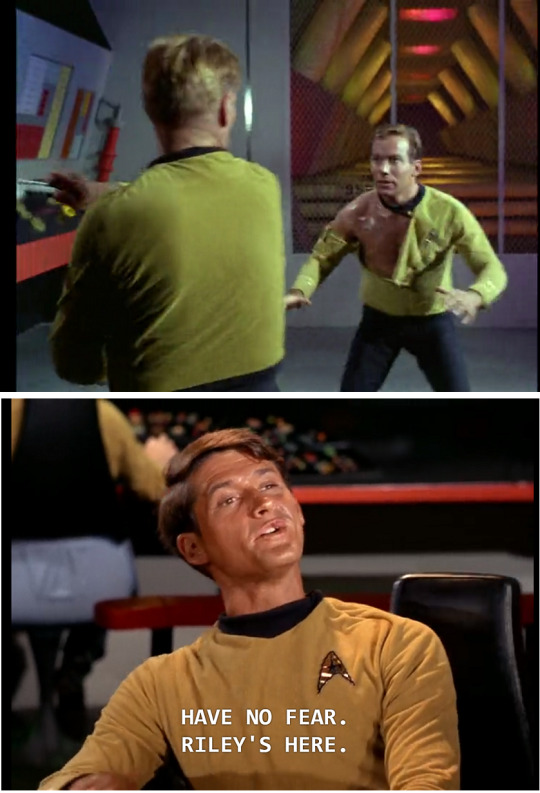
[ID:On the top, a screenshot of Kirk and Finney’s fight in CourtMartial, with both men wearingcommand tunics that appear greenish-yellow. On the bottom, ascreenshot of Riley from The Naked Time,wearing a command tunic that appears much more gold-yellow.]
That’sa pretty extreme example, but a look through my screenshots foldershowed that the exact color of the command shirts fluctuatesregularly in a less dramatic way depending on the lighting. Anin-depth analysis would take some time, but at a glance they seem tome to be a bit paler and more green under outside lighting, and moregoldish or even slightly orange under studio lighting. (Pardon thecut-off caption in that last one there.)

[ID:Six images in two rows of three. On the top: Kirk and Sulu in the airforce base from Tomorrow Is Yesterday;Kirk in Trelane’s manor in The Squire of Gothos;Kirk on the bridge in The Naked Time asMcCoy gives him the vaccine. On the bottom, Kirk in ShoreLeave kneeling down to look atthe ‘rabbit tracks’; Kirk in Arena standingin the desert; Sulu in Shore Leave puttinghis hand on McCoy’s arm.]
Anyexcuse to use that screenshot of Grumpy One-Sleeved Kirk again.
Thisis actually a more common kind of occurrence when it comes tocostuming than you might think—differences in lighting can havesome very dramatic results. One of the stories I’ve heard from myaforementioned industry consultant is of another designer who put anactress in a robin’s-egg-blue dress for Fiddler on theRoof, to the consternation ofthe director, who wanted her in white. She convinced him to hold hishorses until he saw the costume under the lighting it would be inonstage—whereupon, sure enough, it looked white. And that’s inreal time.
Thiess’sinterview says that the issue had to do with the cameras, and who amI to argue with him on that (on plenty of other things, sure, butI’ll pass onthis one). As described in the original eyeshadow post, cameras canhave an odd relationship with color, especially 1960s TV cameras, sothat probably had something to do with it. But, you can see fromthese two pictures how much difference just a bit of lighting canmake. This is the same shirt, just photographed without flash in thefirst image and with it in the latter. (Sourceis from Star Trek Prop Authority.)
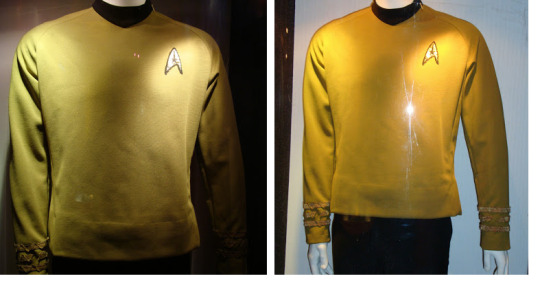
[ID:Two images of a glass case containing a mannequin wearing a commandtunic. In the image on the left, the shirt appears greenish, while onthe right, under brighter lighting, it appears more yellow.]
Forthe third season of TOS they switched to another fabric for theuniform shirts because the velour had a major problem with shrinkingwhen washed (and they had to wash those shirts a lot).According to Prop Authority, this was a nylon diamond double-weavefabric, and the command uniforms were still the same green color.Here’s one of their pictures of a third season command tunic[source]:
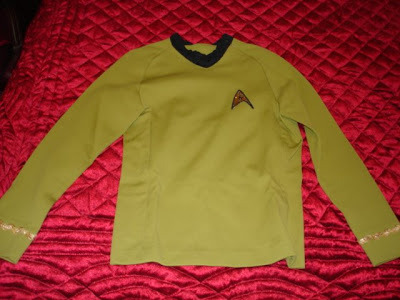
[ID:A command tunic laid out on red fabric; under the lighting it appearsslightly greenish.]
Andhere’s a screenshot from the third season. (I’m sure it’s notthe exact same tunic,but, y’know.)
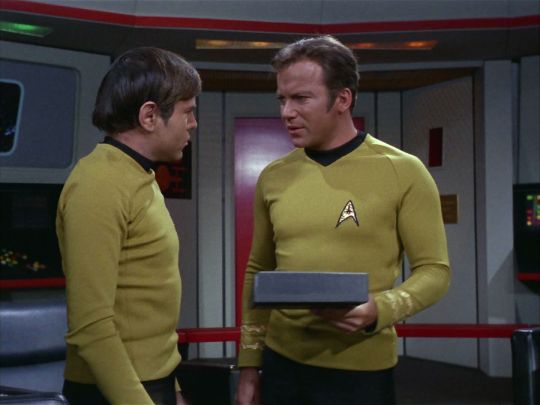
[ID:A shot of Kirk on the bridge talking to Chekov, both wearing uniformshirts that look gold(ish).]
Now,the original post where we were discussing this was here,and was in regards to the Gold Key comics, where all the commandtunics except forKirk’s are green, and I gotta issue a bit of a correction to myselfon that. Originally I said that I didn’t know when they made thedecision to canonically portray the command uniforms as gold butassumed it must have been a decision made for TNG. I was forgettingsomething there which I don’t know how I could ever forget: TAS.
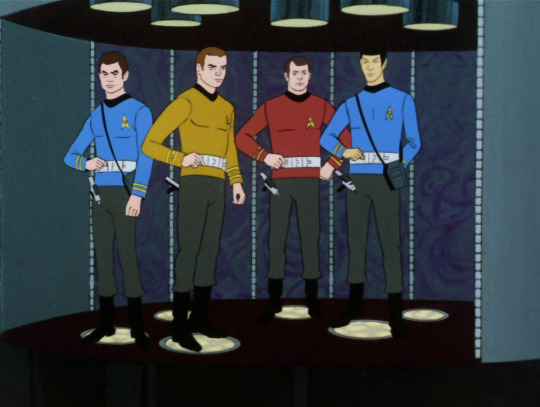
[ID:A shot from The Animated Series of McCoy, Kirk, Scotty and Spock onthe transporter pad. Kirk’s shirt is definitely golden yellow; allof them have dark gray uniform pants.]
TASran from 1973-74, and as you can see, they clearlywent with gold for the uniforms there. Wikipedia has this to say:
Theperception by fans of the command uniforms being yellow/gold insteadof green, thanks to set lighting and other factors, resulted in theproducers committing to a definitive gold-color for animationpurposes. The command dress uniforms remained green to match theperceived colors represented by the live action series.
Sothat would answer that question—the canonical color of the uniformswas decided in 1973. The Gold Key comics started in 1967, before Wordof God came down on that, and so presumably the artists just had tomake their own judgments based on what they could see on screen.Assuming they saw the show at all. I’m still not totally convincedthey did.
Although,thatWikipedia statement also says:
However,the uniform pants were colored gray to match the actual fabric usedin the live action series as opposed to the black they had appearedto be when filmed.
Which,eh. If this picture from the same shoot as earlier is anything to goby, it’s true the pants weren’t solid black, but they seem tohave been more ‘black speckled with silver’ than the straight upgray seen in TAS.
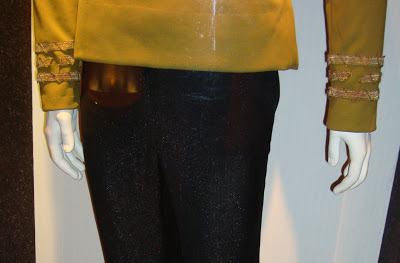
[ID:A photo shot at waist-height of a mannequin wearing a TOS uniform,showing the bottom of the shirt and top of the pants, which are blackwith barely discernible silver sparkles.]
Whichleaves me to wonder if that choice may not have had more to do withthe animation (such as it was)–big chunks of solid black aregenerally something you want to avoid in animation, especially ifit’s something you have to show in motion regularly. But, ofcourse, the animation choices of TAS are a whole other topic (andwhat atopic).
Sothere you have it! Theoriginal command uniforms were green, but we have all been deceivedby the illusory nature of film all this time. It blew my mind toowhen I first found out about it. Just goes to prove you really can’tbelieve your eyes.
121 notes
·
View notes
Video
tumblr
Part One: ^^^
Part Two:
Shipka’s arguments made me consider greatly what it was I wanted to represent. I do use my sewing machine or my PS4 quite frequently, but I felt after reading what Shipka’s students did and understanding that I need to think beyond text and invest myself more in the process than in the final product, I changed my mind and decided to bring my dress form into play. This was based heavily off of her discussion of the environment and the technical tools around me that influence my work and life on a daily basis. I see my dress form every day in the corner of my room and it constantly makes me think about what to do next, what projects I have waiting in my closet for me to work on, and about the time and setting that those compositions require me to have. For example, even creating this minor multimodal composition, my environment was a nightmare, as my adorable demon cat kept attacking the dress form and the measuring tape I draped around its neck. I was also highly concerned about dropping the sewing pins all over the floor and not being able to find them, so I had to work extra carefully. While I do not have the time at the moment to do a 20 page statement of goals and choices (nor do I think such a small creation could fill 20 pages), Shipka did make me think deeply about why I was doing what I was doing. I did not want to create just another voice over video or sticky note collage to represent how nearly every piece of technology I engage with enhances and challenges my creativity, so I instead focused on how my sewing tools allow me to explore and complicate my creation process. This also led me to placing it in a video and adding music (which is a mashup of Persona 5’s “Life Will Change” and JoJo’s Bizarre Adventures Part 3 Theme; I have made and worn costumes for both, so it felt fitting). My mini project overlaps quite well with some of Shipka’s examples, in that it is physical, it engages with more than just text, and while the final product is quite simple, the process of coming up with the idea, executing it, and turning it into a video resulted in changing my goals, original design, and final presentation and explanation.
Part Three:
Chapter One
Composition and writing, while interchangeable in the discipline at times, do not necessarily denote the same things. Composing is the more fitting term because it includes the act of multimodality, even without direct reference to the technology around us, such as lights and floor tiles. The method of instructing composition in the classroom should be different than the traditional English classroom because it ought to involve cooperation with communication studies, like psychology and philosophy among others. Finally, limiting writers to the term of “students” and their writing to just what comes out of their heads eliminates consideration of the place and space within which they write and instead places them inside a written text based box.
Chapter Two
This chapter focused on discussing Wertsch’s concept of individual(s)-acting-with-mediational-means. There were four primary points of discussion, those being 1) using the meditational means framework, a text-based work cannot truly be judged as monomodal because the process of the text might have included outside sources and influences upon its creation. 2) this viewpoint challenges our concepts of technology as only being whatever recently modern creation we use. 3) the framework forces us to acknowledge the psychological and technical tools that go into composition and how the tools we choose to use affect our physical bodies. 4) The framework denies us the ability to see each reader or writer as an individual in composition because of the changes that certain mediational means require. The final point of note in this chapter is about how technology will fade into the background and become transparent when it is working properly as a part of our daily lives. This also has an effect on how we view text based compositions because it forces us to consider the mode in which we compose and how what we choose to write or create with is a technology with its own specific demands.
Chapter Three
The explanation surrounding Muffie and her body/dance based text was fascinating to someone like me who drastically prefers written word to body language. It felt significant that much of the chapter was dedicated not the writing process so much as the location in which it occurs, such as in the beginning of the chapter when a student ran into complications of distractions while making their t-shirt composition. When it came down to the various places and stages Muffie had to go through to get to her final product, it made me think about my own environment when I write, which is normally either complete silence in my room, listening to the Carole and Tuesday soundtrack, or forcing myself into Starbucks to not be distracted by my kitten Darcy. Finally, it was increasingly significant in this chapter, seeing how the author built it up to this point, that the final product is not necessarily the most important part of composition because much of what is multimodal about certain texts is the path and tools used to get there.
Chapter Four
This segment of the book was incredibly interesting and informative because of how the author explained the goals and processes of the two students’ projects. Particularly, the intent of each project informed not only the topic, but the form that the end product took (in this case the goal was to get their audiences to explore the frustration and pain they had gone through in producing a multimodal composition). I found it helpful that the author showed how multimodal assignments do not make things easy or unacademic, as some believe, but rather require different thought and consideration than an essay about a word from the OED might. Asking students and teachers to reevaluate their text based academic worlds is beyond imperative to the ever expanding field of composition and its relationship to technology. This chapter was significantly informative to me because of what I am considering for my final project in this course. (I shall not reveal it yet, but it will be physical multimodal composition).
Chapter Five
As we discussed in class last week, grading and finding criteria for analyzing multimodal compositions is a challenge. The author appears to propose as a solution to this problem that student’s write a statement of goals and choices that is highly detailed and extensive, such as the 20 page example she mentioned the student of the Lost and Found journal wrote. It is this extensive self reflection that opens up a way for instructors and audiences to understand decisions and aims of the project and be able to compare it to the final product. This connects back well to the rest of the book, in which the focus is once again placed upon the steps taken to get to the end rather than looking at the product on its own.
Conclusion
Composition must go beyond writing to include other forms of meaning making, or risk educating students to hold a narrow viewpoint of what writing is. We must also learn to value texts that are not merely linear and traditional and work towards an accepting writing community that will not dismiss a text based solely on appearance. Finally, acknowledging and creative spaces for academic composition to mix with creative and multimodal positions is imperative to spreading and teaching proper, modern composition skills.
#multimodal composition#multimedia#mediational means#environment and text#academic and aesthetic#composition theory
1 note
·
View note
Text
Ocean’s 8
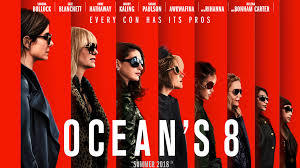
The other night my brother and I went to the Carlton in Toronto to catch Ocean’s 8. I had stayed away from the film for a few weeks, I’d caught a few review headlines since it opened, dud, fizzled out, and franchise fatigue had cropped up a few times. When I first saw the publicity still last year, of all the women on the subway, I was amazed that a bunch of my favourite actresses, comedians, and pop singer (Rhianna) were all doing a film together and I put it on my list. I was pleasantly surprised by Ocean’s’8, it was a lot quirkier and funnier than I thought it would be, and occasionally I had to wipe away a tear from laughing.
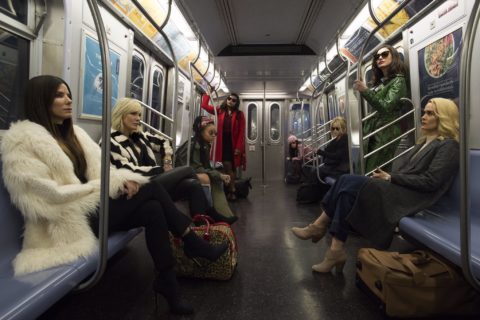
Early publicity still
The film follows the standard heist format pioneered by post war noir filmmakers. The star, Sandra Bullock, plays Debbie Ocean (Danny Ocean’s sister), and after hatching a scheme in prison for, “five years, eight months, and twelve days,” is released and has to put together a crack-pot team in order to steal a Cartier necklace worth over a hundred-million dollars. There are the typical vignettes of Ocean assembling her team, there’s her former partner turned nightclub owner (Cate Blanchette), the hacker 9-ball (Rihanna), a kleptomaniacal fence (Sarah Paulson), the jewelry expert (Mandy Kaling), the down and out fashion designer (Helena Bonham Carter), and the street wise pick pocket (Awkwafina). Together they execute Ocean’s daring plan to steal the necklace at the Met Gala. There are a few twists and turns in the plot which brings in an insurance agent from England, played by James Corden, to find the jewels. The audience is brought into the action through a series of well timed gags and hair-raising moments of suspense.
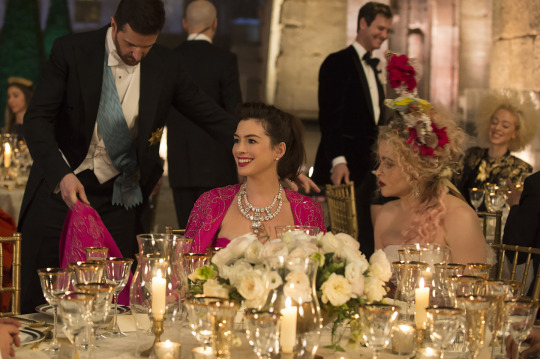
Hathaway and Bonham Carter at the Met Gala
I’m a huge fan of heist films, there’s something about the sub-genre that appeals to me. Going all the way back to the Noir heists The Asphalt Jungle, and the French film Rafifi, I’m a sucker for a group of criminals trying to make one last big score. I wasn’t however a huge fan of the original Ocean movies, nor of the Soderbergh reboot. Which is why I was pleasantly surprised that this installment was so good and incredibly funny. It felt like I was watching an old comedy with Carol Lombard or Rosalind Russell, the comedic power of some of these actresses shines through in almost every scene. Helena Bonham Carter has some of the best reactions I’ve seen in years, her subtle head and eye movements executed just at the right time cracked me up, she wears a puzzled look on her face for most of the film which is incredibly endearing. Bonham Carter, being the veteran English actor of the bunch, even knows how to get all the mileage out of a costume during the Met gala, as she moves about in a bizarre outfit in such a way that makes it hilarious. She’s even poking fun at herself as she has been known for some odd fashion choices over the years at red carpet events. Sarah Paulson is very reserved but incredibly funny, her character, a waspy housewife, always seems to be on the brink of loosing her cool façade (she never does), and it’s fascinating to watch her play a mother role in a heist film. Some of her jokes were visual gags that were set up beautifully. The young Awkwafina gets most of the laughs as the street wise hustler, her role had the most potential for comedy, and she relishes every single moment she is on screen. She knows exactly when to hold a joke, letting in linger in the air, something most comedians don’t understand today. It’s not that you have to be funny all the time, it’s that you have to understand the rhythm of a joke. There’s a touch of Leslie Neilson or Bea Arthur in her comedic pauses.
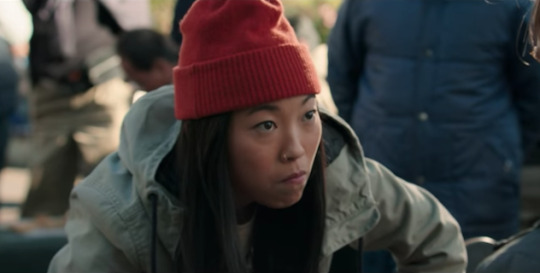
Awkwafina as Constance shines
Anne Hathaway steals some of the show as the vapid gum chewing movie star Daphne Kluger. Her timing is incredibly precise, she uses her gum chewing and big beautiful eyes to really sell her jokes, chewing on her pauses and delivering her lines with surgical precision. I think Hathaway needs to do more comedy outside of the schlocky rom-com type of humour that is ill fitting for her and reboot some the old Carol Lombard type plots that are entirely missing from cinema today.
What was surprisingly nice was that the two headliners, Sandra Bullock and Cate Blanchette, never once took the spotlight away from someone else. They played their roles effectively and knew how to share the stage with the supporting cast allowing each of the others to grab some laughs and shine in their roles. If anything, the film was missing one good fight between Bullock and Blanchette. It would have been nice to add just a little tension between the two characters early on in the film, the should we do this scene was flat and self aggrandizing in their sisterly bond.
Ocean’s 8 was co-written and directed by Gary Ross who’s resume includes Big, Pleasantville, and Mr. Baseball (one of my favorite cinematic guilty pleasures). He knows exactly how to set up a joke or a gag and executes it beautifully. What I found interesting is that most of the audience didn’t laugh at some of the funniest moments in the film. It seemed my brother and I, and a group of friends behind us, were the only ones who got the subtle jokes. I think one of the problems is that audiences today aren’t used to the subtly of reactions and visual gags. My favourite moment in the film is when Sarah Paulson’s character is introduced. She is living in the idyll of suburban America and making a healthy green smoothie when Debbie Ocean calls her, her son playing in the background. Answering the phone, she says, “Buddy do you want to stop that,” the threat is implied. Debbie tells her she’s in her garage and when Paulson walks into her garage there are boxes and boxes of stolen goods. It’s such a wonderful joke, that here in this perfect suburban house lies a kleptomaniacal fence. When Debbie asks her what she tells her husband about all the stolen goods Paulson replies dryly and at just the right moment, “eBay,” I couldn’t help but crack up at her delivery.
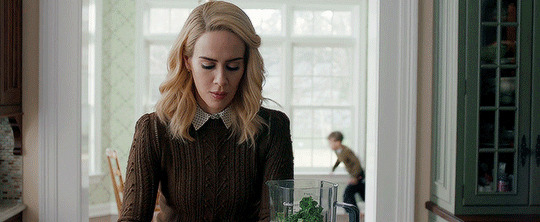
The perfect life, the perfect house, a life of crime
The other problem plaguing the film is it’s underwhelmingly simplistic visual style. The camera moves and cuts competently enough, but the whole style is reminiscent of a de-contrasted Instagram photo or a mediocre Tumblr mood board. It’s a problem shared with a lot of commercial films these days, lackluster shadow-less vistas of muted colours that lacks any texture or depth. One thing that made last years The Florida Project so appealing was its rich palette and crisp composition, great care was taken at figuring out the mise-en-scène. It’s disappointing that the Ocean’s films, being reboots of the iconic 60’s jet set era, don’t devote more effort to their visual look. There was one sequence in a post-modern airport for a fashion show, and the occasional horizontal venetian blind wipe, but aside from that, the film looks like some washed out mediocre miniseries on the FX channel.
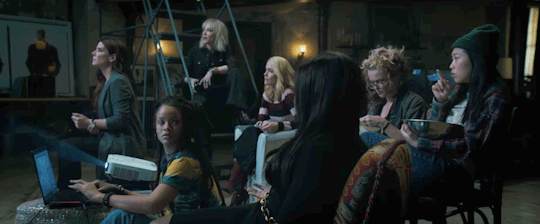
Strong composition, but the lackluster, and washed-out lighting renders the style bland
Ocean’s 8 isn’t pretentious or hokey, it’s just an all female version of a heist film with some incredibly talented actresses. Checking over the box office receipts, the film is doing incredibly well this summer, and along with the Black Panther, is proving to the Hollywood establishment that you can deliver a great product with an all female cast, or a cast of people of colour, or on queer themes, and still turn a tidy sum. People want to watch a good product and they want to see themselves in the characters on the screen. Aside from a few missed opportunities to set this film apart from its predecessors, it’s a fun diversion this summer. If you’re a fan of good comedic pacing, or of any of the actresses, it’s worth the price of admission.
#oceans 8#awkwafina#sarah paulson#cate blanchett#mandy kailing#sandra bullock#anne hathaway#helena bonham carter#heist films#movies of 2018#rihanna#women#carol lombard
23 notes
·
View notes
Text
2018 Megaman Valentine’s Day Contest Results Thread!
Thank you all for your patience this year! I know this is a little later after the holiday than I would like, but one day is simply not enough to contain all this love! Once again, it’s always wonderful to have an assortment of both familiar faces participating, as well as many newcomers.
As always, this will be a rather massive thread, so bear with me. Most of it will be hidden after the break, so please do take a peek at all these wonderful entries!
Due to the size and sheer quantity of comic entries, there are plenty of images to view. For that reason, I’m sticking to thumbnails for now. Please click to view the entry in it’s full glory!
Also, my thanks to @jaybird-c for the help with judging this year. I’ll have some of his commentary with my own below.
The three raffle prize winners will be noted by their alias, as well.
For your reminder, there were two categories, broken down into Humor and Talent. There were 6 total Humor entries, and 14 Talent entries. So, to start off, we’ll begin with the category with the least entrants, and to fit with my tie-in promo art.

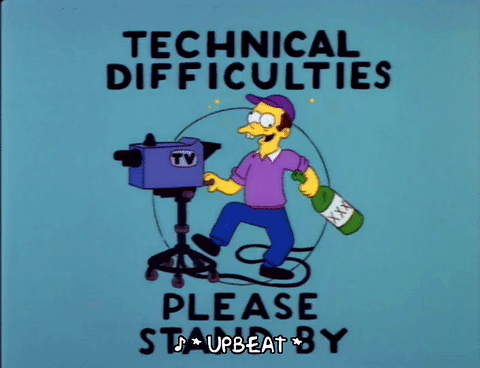
*EDIT* OK, now I think everything is good. So long thumbnails, to keep this shorter.
Once again, for an easy link to all the images in a single gallery, please go here: https://imgbox.com/g/uAbXkTDaot
Otherwise, I’ve tested it again on both mobile and desktop, and everything should link to a full image. It still does on my end.
*/EDIT*
For Humor, this year’s theme was “Beauty and the Beastman.EXE.” The goal was to illustrate a mismatched Megaman couple, one in a monsterous, beastly form, with another more beautiful character that falls for them. Any allusions to the popular tale of Beauty and the Beast were welcome, but not a requirement.
Here are your top 3, followed by the remaining entries in alphabetical order by alias:
1.) @prar-draws: (*Prar wins $100 USD or an item(s) up to that value.)

Jaybird wrote: Prar's comic has the absolute best execution of a joke, increasing the tension until the last panel when it masterfully throws the audience for a loop. Prar's style complements the story very well by making each individual moment easy to digest, and the last panel also just happens to be really funny to look at on its own. Just thinking about it makes me crack up.
Miyabi wrote: While this piece really contains more tension and drama until the final panel, I agree that the build is what helps bring the big laugh at the end. You can also see the temperature rising for Ciel, as her cheeks get redder and redder as the panels move along. I felt it tied in to the Beauty and the Beast storyline nicely, and your chosen characters fit well to pull off the connection. Very cute, and well constructed comic!
2.) @amiable-apparition: (*a-a wins $50 USD or an item(s) up to that value.)
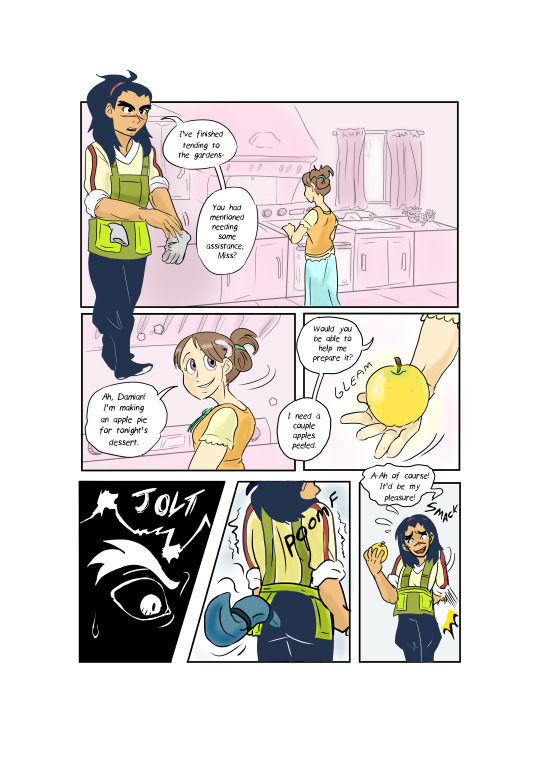
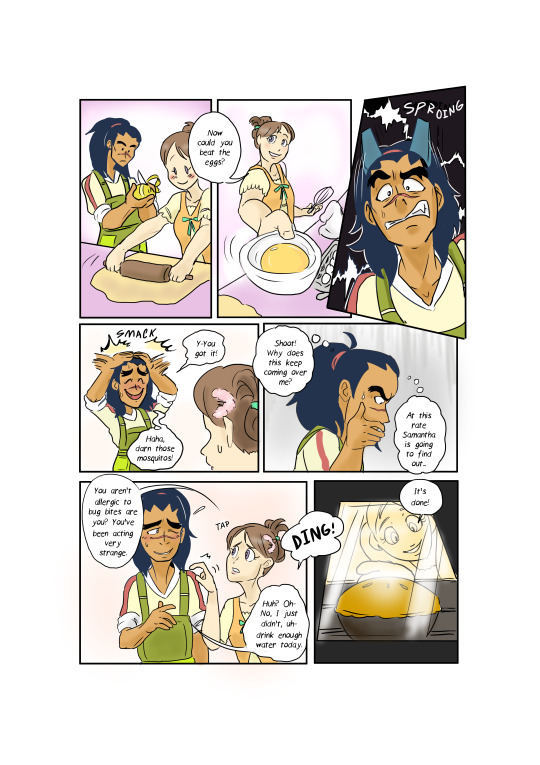

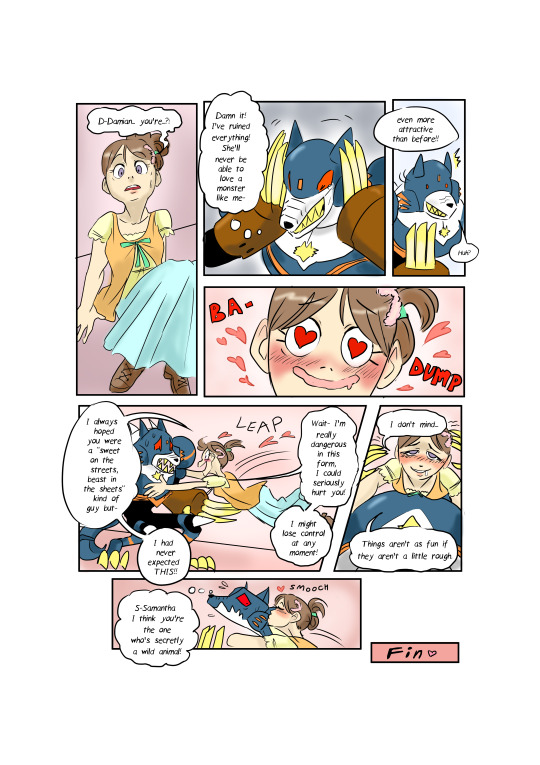
Jaybird wrote: I don't remember this scene from the Star Force anime. Must've been cut from the final release. Clever use of trickery regarding who the real "monster" is; poor Damian appears to have misjudged the situation something fierce. Good idea and use of twist.
Miyabi wrote: I guess Sam was the one who was ‘Hungry Like the Wolf,’ after all! I too enjoyed the spin at the end, it was a funny deviation on how her character was portrayed in the anime. Subject choice was strong here too, connecting the theme with a couple characters who fit well with the concept. Nice work with the variety of panels you created to set things up.
3.) @frankenchio: (*frankenchio wins $25 USD or an item(s) up to that value.)
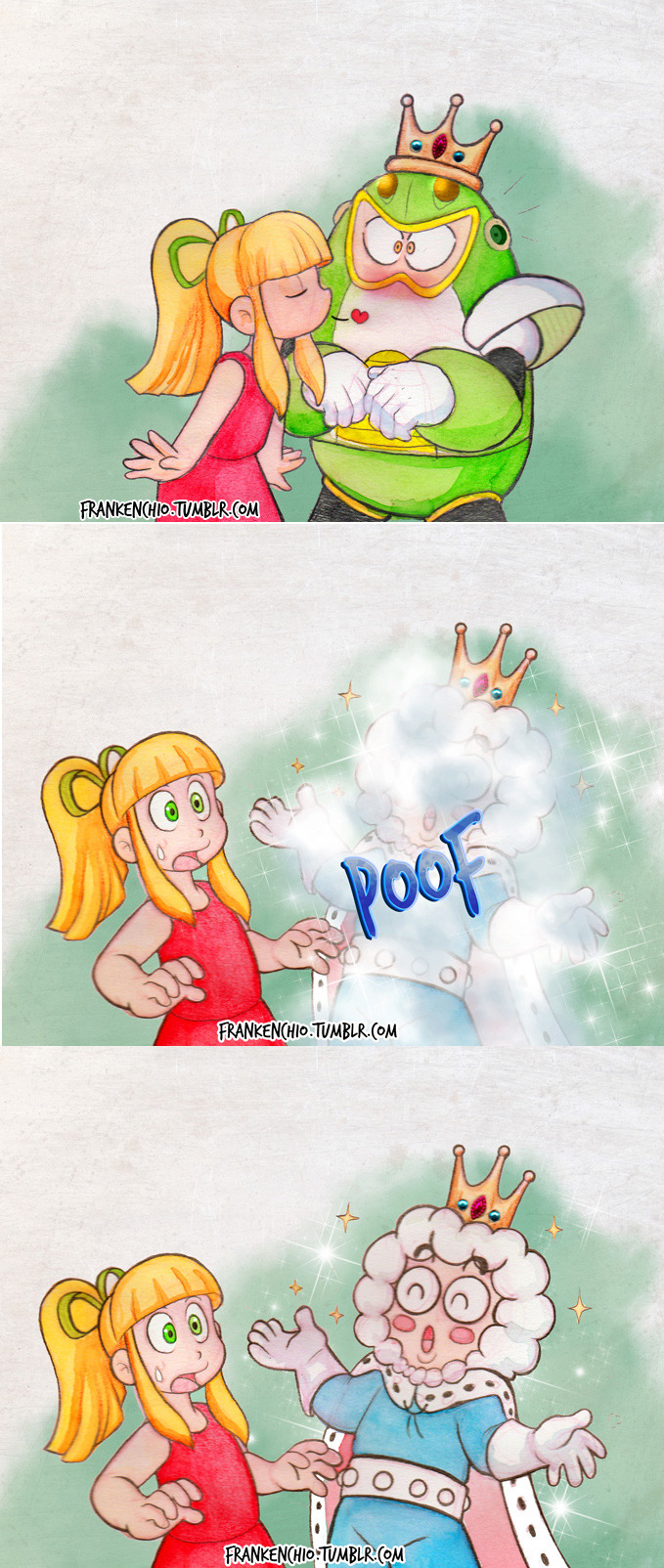
Jaybird wrote: Ah, the Princess and the Toad Man. Frankenchio's piece is a clever little reference to the classic fable, but most of the humor is in how Roll apparently didn't know what kind of prince was on the other end of that frog. Clever, pretty to look at.
Miyabi wrote: I like that you thought outside of the box with the theme, and used a totally different classic tale, but still connected it very well. Ice Man sure lucked out this time, after whoever cursed him into Toad form. While a simple few panels, your style is just adorable. Those jewels on the crown look really detailed!
Close, but not quite ~
Dark Dullahan:

Jaybird wrote: Dark Dullahan has the idea of recreating an actual Disney scene with Iris and (Zoanoroid?) Zero, which is very sweet. It took me a few repeat looks to digest what was going on here but it's amusing to see Zero protecting his wounds from the fierce and terrible Iris. Because she's obviously the worst thing that can happen to him. Cute, amusing scene.
Miyabi wrote: Sorry, I don’t know why this upload defaults to a side view, when I don’t even have it at that orientation. It automatically glitches that way, no matter how I upload it. :/ Anyhow, a clever spin using the EXE versions of Zero and Iris, living in a world where only reploids...no wait, they don’t exist here. This Beastly ZoanoZero will open up to her over time, I’m sure. But first, he needs to heal up. Again, good use of parodying the scene.
@drewblossom:
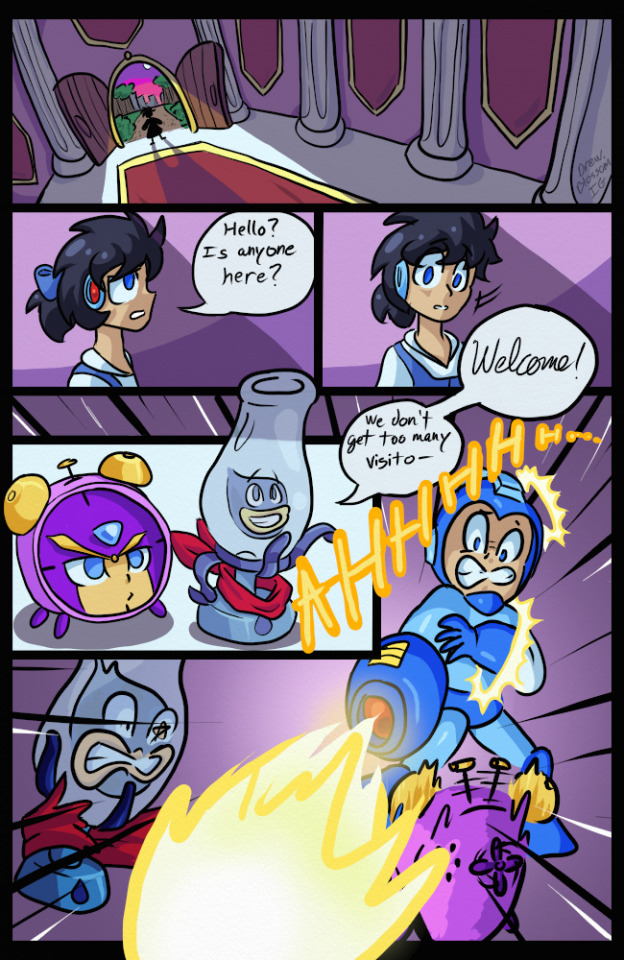
Jaybird wrote: The sheer concept of Rock-Belle made me wonder if they were going to throw in an FMA reference somewhere, but Drew's picture doesn't need it. They make good use of the Disney-classic-gone-wrong idea -- Oil Man and Time Man as Lumiere and Cogsworth are nearly inspired --though I think they didn't quite go far enough and should have rounded out the piece with a more feminine version of the suit; Rock-Belle changing into Mega *Man* raises questions about whether the main character's an actual girl or just a cross-dresser, which distracts from the joke.
Miyabi wrote: I guess Rock is both the beauty and the beast, for totally destroying those poor innocent talking inanimate object bots! While I had a good laugh at the quick-change blast, the character reactions, and the overall parody of the classic scene, sadly I did feel it just didn’t quite have the couple contrast/Valentine’s theme as well as others.
@erekisaiko: (*RAFFLE PRIZE WINNER* Captain N Height Chart)

Jaybird wrote: I feel like I'm missing a reference to something else. As amusing as the concept of JunkMan's and Meddy's unsanitary hospital sounds, the picture doesn't present us with enough information to make sense of what actually happened (i.e. why was JunkMan wearing a cardboard Falzer costume in the first place?), and [=ClockMan's=] joke lacks the punch it ought to have because the punchline has no set up. (Unless of course this is all just an incredibly obvious reference to something I've never been exposed to that would fill in all the missing context). Amusing concept in punchline, it's fun to think about how this situation could've arisen.
Miyabi wrote: Meddy’s not oblivious, she just has a big heart ready to heal any messy, junky slob! Cute and different idea having more of a ‘fake’ beast, although I think Junk still would count as a beastly character on his own, in some respects. Very well-drawn, and appreciate all the detail you put into your internet background.
For the talent category, the theme was “If You Like It, You Should Put a Ring Boomerang On It.” This category was all about proposal scenes. And I am shocked there was not a single Jewel Man! XD
Here are your top 3, followed by the remaining entries in alphabetical order by alias:
1.) @wintesm: (*wint wins $100 USD or an item(s) up to that value.)

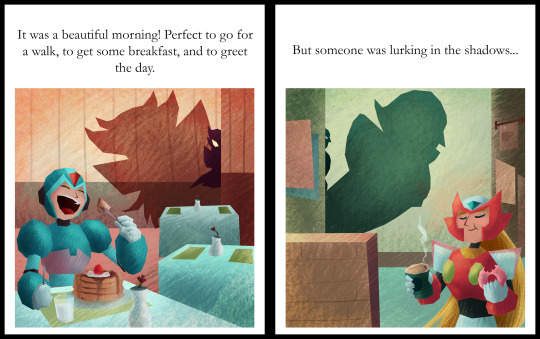
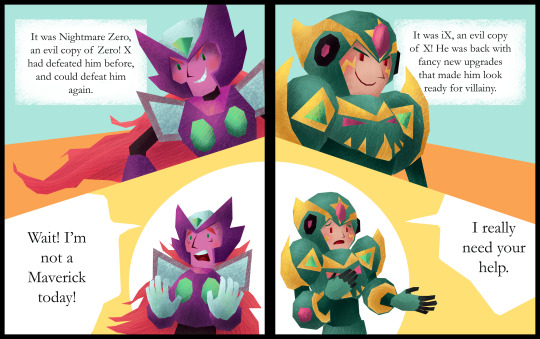
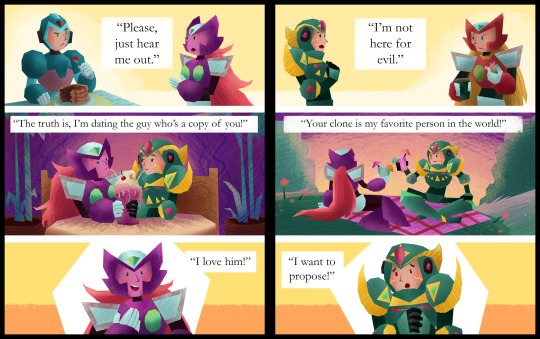
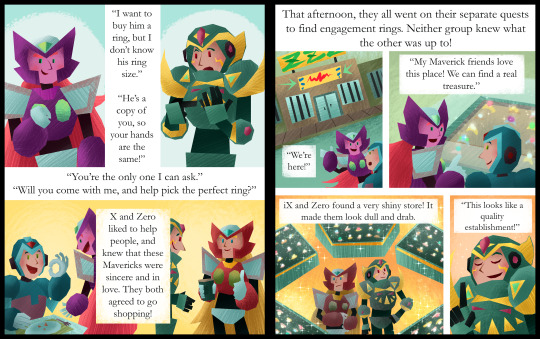
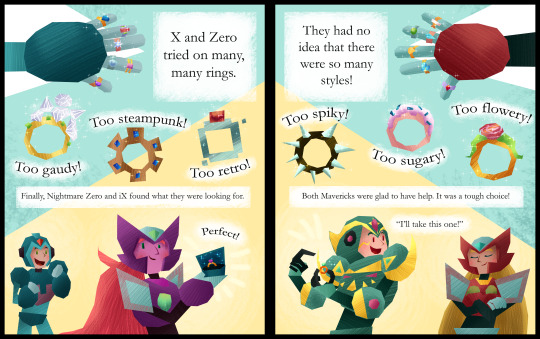
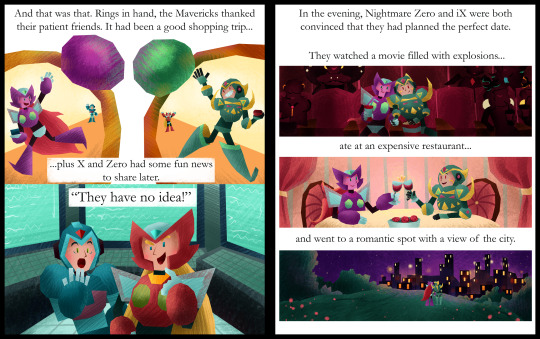

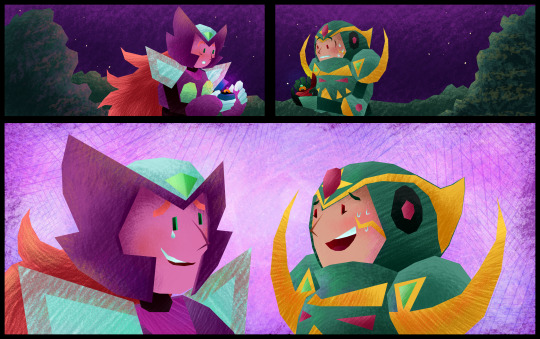
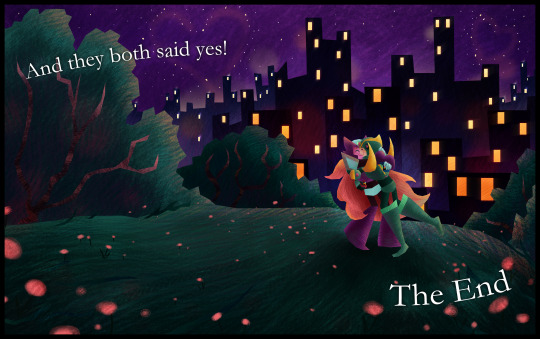
Jaybird wrote: Jeez. Unrelenting Style. Your children's book painting is incredible as ever; your figures, your colors, your atmosphere, just about everything. I ran into a problem with your composition, though; the stark black page divider clashes with the predominantly horizontal-mirror structure and makes it hard to wrap your head around the story as its meant to be told. It was less of a problem once I trained myself to ignore it, and you use the divider very effectively in the second-to-last section, but it still made it harder to enjoy the work. Masterful technique, colors, perspective, expression.
Miyabi wrote: With your subjects, I felt this composition was a very clever way to tell the story, and kinda mirror their separate, but similar tales side-by side. As mentioned, you have such a fitting children’s storybook style, from colors to shapes, that shines once again! It’s a cute tale for such evil characters!
2.) @peach35: (*peach wins $50 USD or an item(s) up to that value.)
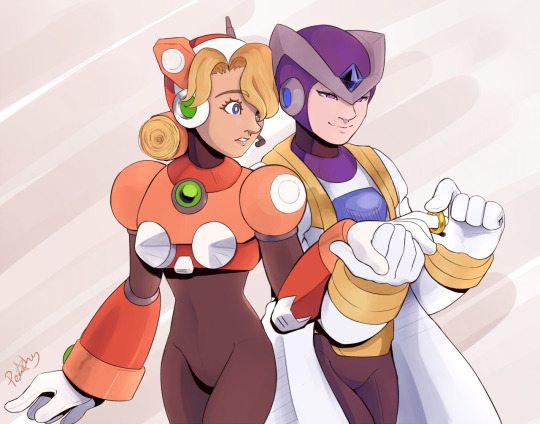
Jaybird wrote: Peach deserves a lot of credit for her mastery of figure-drawing and perspective. That's something a lot of people struggle with, and accomplishment in these matters should be recognized. Another good choice of simple background to highlight the main moment, and awesome use of colors and lighting to suggest 3D -- I'm far more fascinated by Gate's nose than I should be. Incredible faces, hands, colors, and general shading.
Miyabi wrote: The sense of confused shock on Alia’s face is a different reaction that most, as it’s apparent Gate is slipping that ring on in total surprise. Clean lines and soft lighting helped this piece stand out.
3.) @tianura: (*tianura wins $25 USD or an item(s) up to that value.)
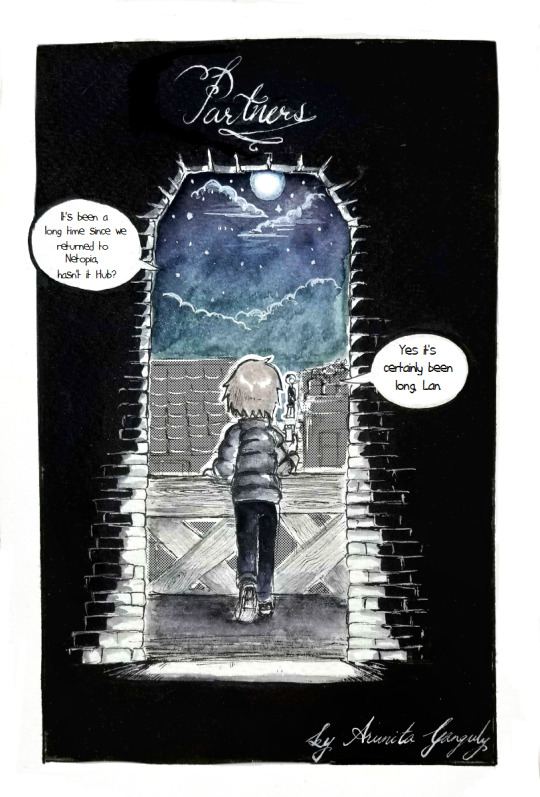
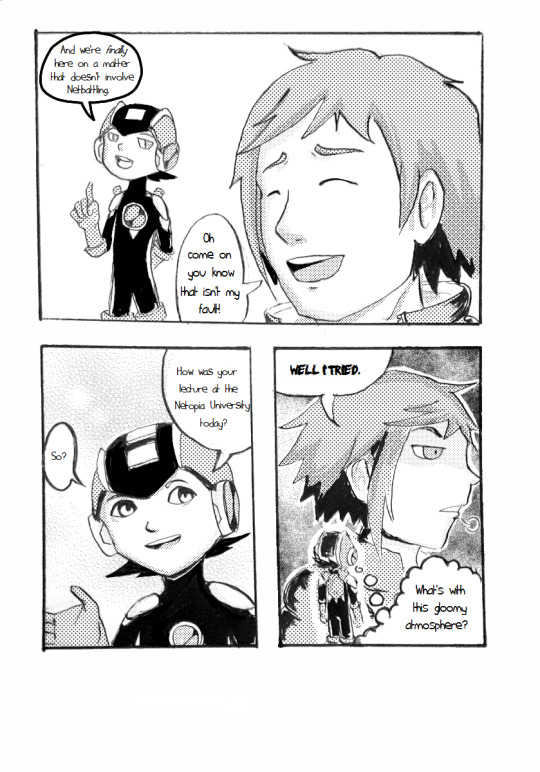
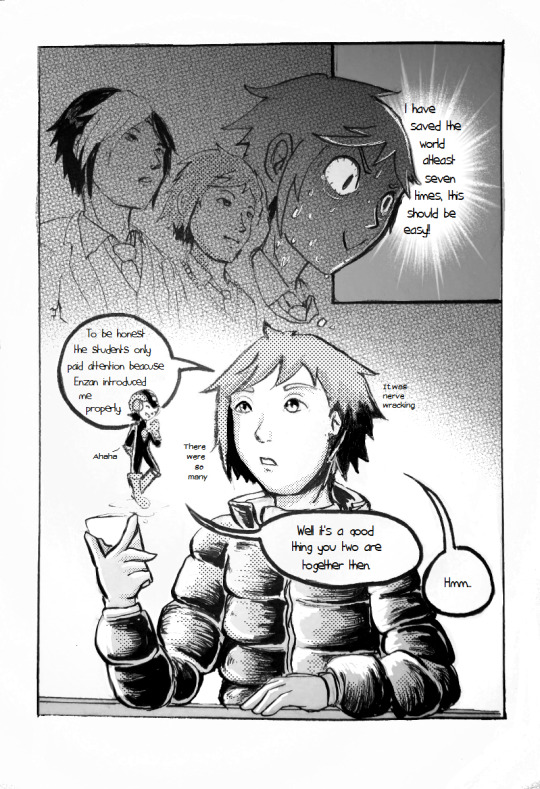




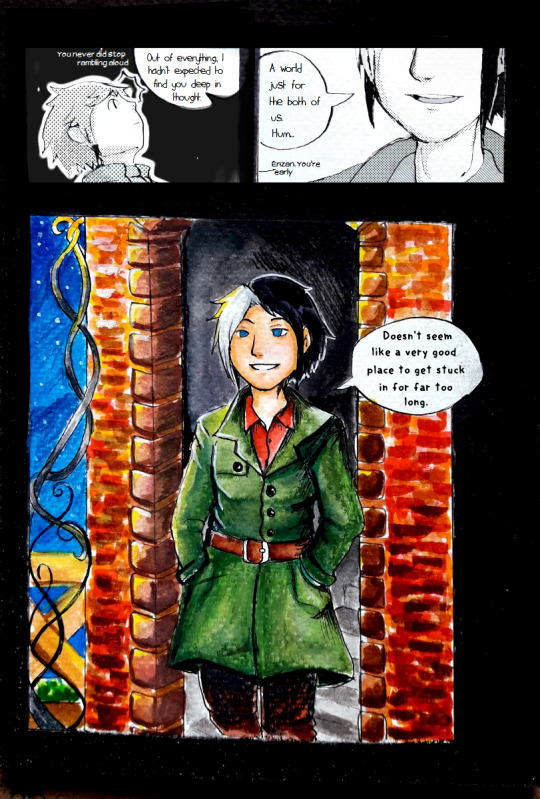

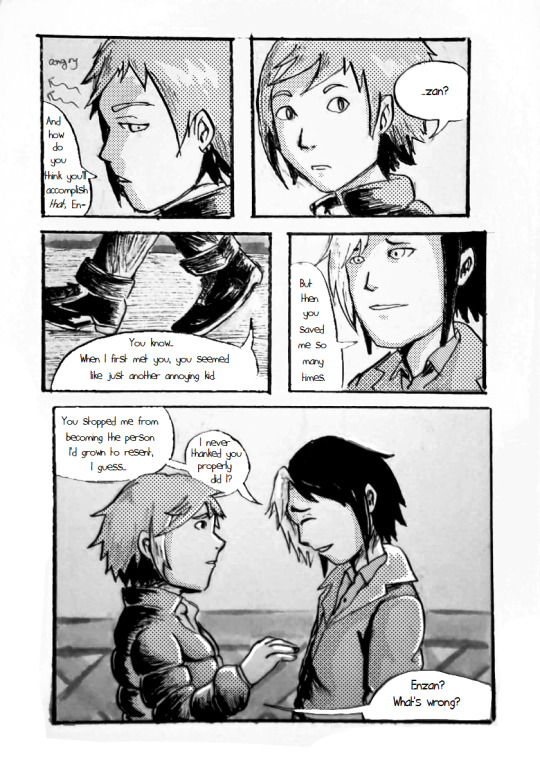

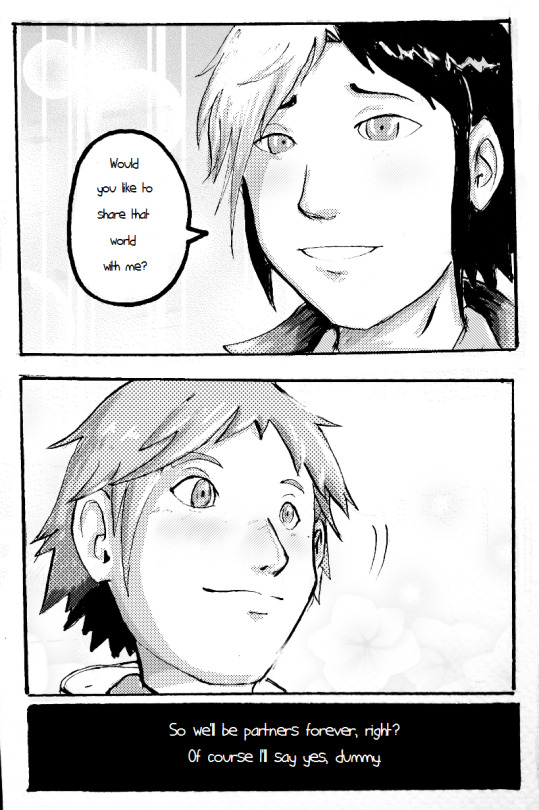
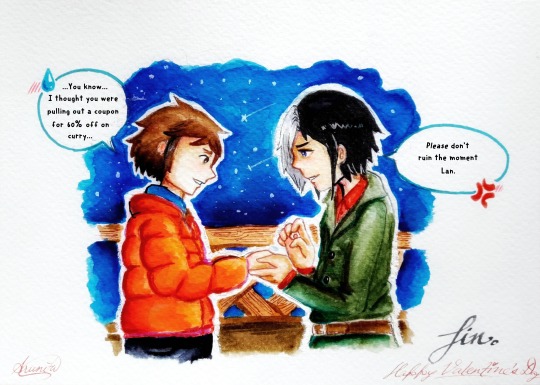
Jaybird wrote: Tianura's style is difficult to read; the line quality can be inconsistent from panel to panel, some attempts to convey 3D positioning could use polish, and the panels never stray very far from simple torso and head shots. That said, the expressions are exceptionally clear (again, look to the eyes) and convey lots of emotion, and the page-by-page composition is very good. Very expressive faces, judicious use of colors for effect.
Miyabi wrote: I thought this was a creative parallel for life-long partners in using Netto and Enzan. You did a nice job keeping Netto’s goofy charm intact, with quite a few humorous lines. The ending was totally fitting for him, older or not. XD While I’m sure you would have liked to color the whole thing, I liked the differing use of screentone shading. And the watercolor look of the color pieces did give it some storybook charm as well.
Close, but not quite ~
@borockman:

Jaybird wrote: It's such a shame this isn't a humor category, because this deserves major points for funny (the Nana-Sigma romance anime that the fandom doesn't want, but nonetheless deserves). The linework itself is pretty good. Expressive, good use of background for mood. Also, Sigma, the ring goes on the ring finger.
Miyabi wrote: It’s a dream. It’s always a dream! Siggy puts the ring on her pinky because Nana’s his ‘lil pinky-poo... ;p With the tears running down her face, I really did like the emotional feel of the moment.
@digitallyfanged:
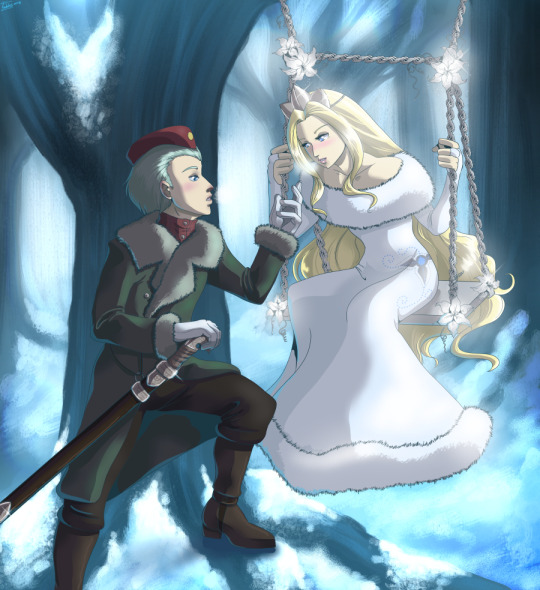
Jaybird wrote: In terms of sheer atmosphere, this is one of the best pieces. It looks like a still from some fairy tale picture-book. The forest scenery, the background, the flower-swing, the misting breath, the quality of the outfits and the details on the dress and sword all make this exquisite. Unfortunately the characters aren't quite as expressive as they ought to be -- this is very clearly a fairy-tale love scene of some kind, but what kind? Laika is clearly being emotional towards the princess, but what is he saying? "Who are you"? "You're beautiful"? "I love you"? "Be mine forever"? It's gorgeous, but it's a little too vague to tell whether it's on topic or not.
Miyabi wrote: Gorgeous scene that felt a bit like another Disney-ish tale, moreso of the Frozen variety. They may just be easy-to-use Clip Studio effects, but I really thought it was quite creative how you pulled off the swing design. The watercolor forest background is beautiful, as is Pride’s snow princess outfit. Pretty, pretty picture!
@drewblossom:
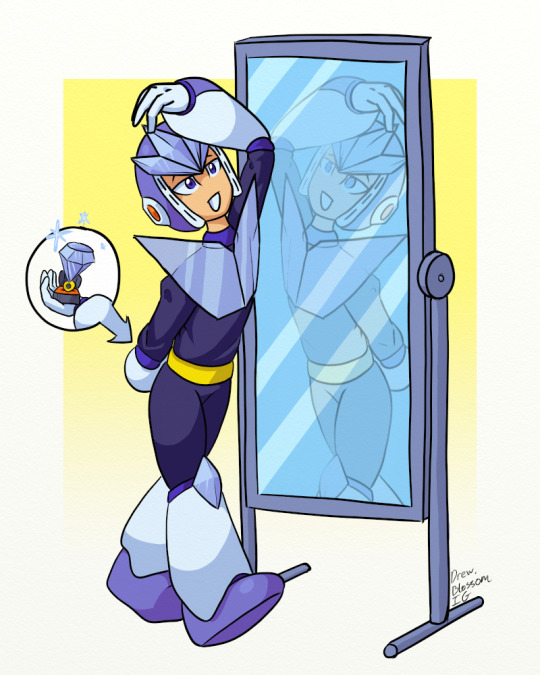
Jaybird wrote: I'm glad I saw Drew's title, because it took me a minute to figure out exactly what was going on -- for a moment I thought Geminiman was trying to propose to himself with that (fittingly) gaudy diamond. The linework is pretty good, and I like the lighting effects on Gemini's crystals and the translucence of his chest plate. I'll give them points for an ambitious concept, but the best mirror art looks at a scene from two different directions, and Gemini's reflection is simply a reverse of the main view. Good colors and lighting, elegantly simple background that does a good job of highlighting the main action.
Miyabi wrote: No better way to practice a proposal than to recite it in front of your self. Of course, if he is proposing to his clone, then I think with his nonchalant actions, he’s got this down already. XD Clever, and unique!
@hyperbole1729:
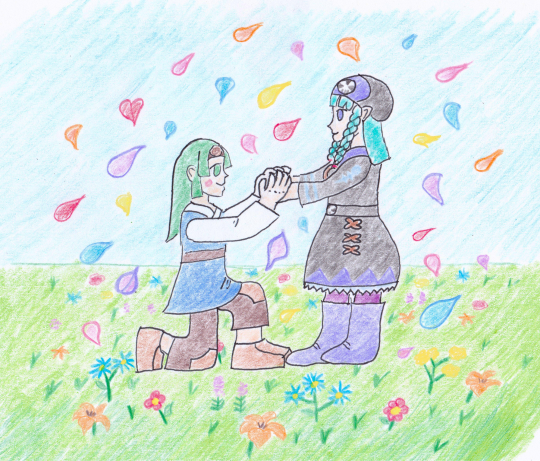
Jaybird wrote: This piece is another mix. It has some very nice things -- the colors are spot on, the composition is very nice (you take cues from the 18th century Romantic movement by having the whole world revolve around the subject), you clearly pay attention to character details, and your field of flowers is great.
Miyabi wrote: Another set of net-battling partners who seem like a great choice for being together forever. The background is a fitting place for Sal to do it, because I don’t quite see Miyu being the one to speak up and propose. That might be more of a frightening proposition. LOL Cute, traditional scene.
@iris-sempi:
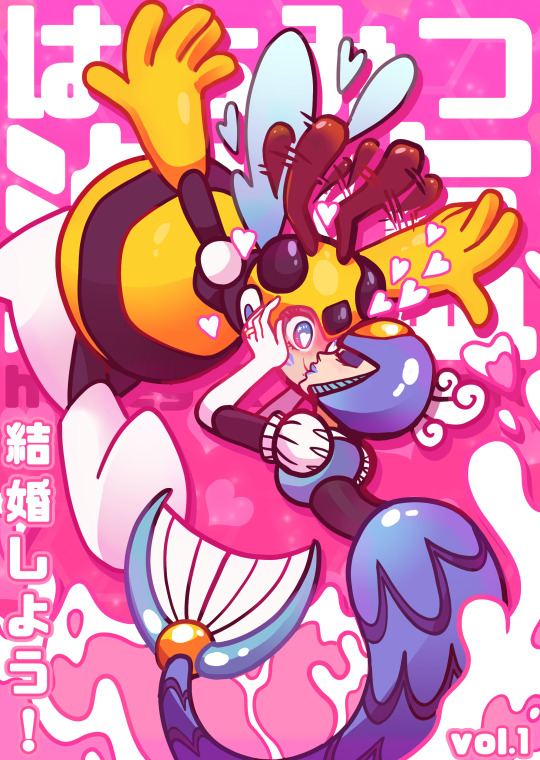
Jaybird wrote: Iris-sempi's got style. The colors are interesting, the subject is clear, the linework pops out because it's -also- part of the colors, the cartoony elements fit in very nicely, and the presentation as a literature/manga cover is well-done. The technique is some of the best I've seen. That said, I have to ask, if you were going to go through all the trouble of creating such a cool cover, I think it's only fair to point out the title is blocked by the artwork, which defeats the purpose, especially on something's Volume 1.
Miyabi wrote: Just to clarify for everyone, the Japanese characters for this piece say "Let's Get Married" and "Sea Salt Honey." I thought it was a really clever mag cover format, where the characters really pop out against the pink background. With the waves, it really does feel like Splashy leapt out of the ocean to smack some salty sugar on Honey/Vesper Woman. Her vibrating antennae give some nice movement and comedic effect, too. Love it, but felt it just didn’t quite have the proposal feel as strongly as others.
@jb-artist: (*RAFFLE PRIZE WINNER* - Megaman 8 cel)

Jaybird wrote: JB's picture is very cute, and we don't have much actual oekaki here, so props. While you deserve even more props for how direct you are to get to the point, it's difficult to judge how we're supposed to interpret this -- is Alouette precociously misunderstanding the nature of a marriage proposal or is it an actual proposal to her older sister figure? The perspective rocks, the colors and lighting are good, and there are lots of little details that portray lots of love for the Zero series.
Miyabi wrote: Zero’s such the silent, brooding type, that he sends Alouette to do the proposal for him. I’m just not sure if that will help or hurt his rank in this stage! XD It is honestly really cute, especially when you see her doodles on the resistance base’s wall. I think that makes the piece more than anything, and was a clever callback to the game. I like how you set up the scene with the background, and those are some really nice mountains back there, too.
@lightlabs:

Jaybird wrote: Now this is pretty. Great composition to direct us through the piece (-nice touch- on giving the ring some bling) and rocking use of paint swatches for style. The art does a great job of directing us into the center, and the warm colors in the center do a lot to convey mood. Zero, you smug jerk, stop showing the rest of us poor schlubs up.
Miyabi wrote: Yes, this is happening. There is a reason for me to go on. What...what am I using this line foooorr? The warm colors and sparkles give it a unique glow, for what seems to be a night scene. The brush strokes give it a neat paint brush look, for your coloring, too. Nice work conveying their emotions with their expressions as well.
@pandapanic0:

Jaybird wrote: In terms of actual skill, the coloring is good and clear, the piece is composed well, the lighting effects are fairly elegant. If it were the actual humor category, the Ring Man's appropriately outlandish bid and Mega Man's exceptionally feminine reaction would gain the piece lots of laugh-out-loud points.
Miyabi wrote: Thank you for taking the title of this category literally and going for the humorous visual of a giant ring Ring Boomerang! Even if he says no, once he tries to get rid of that ring, it’ll just come right back. XD Rock’s blushing expression is cute. Nice crisp coloring and bold lines.
@shikai-the-storyteller: (*RAFFLE PRIZE WINNER* - Archie Worlds Unite Page)

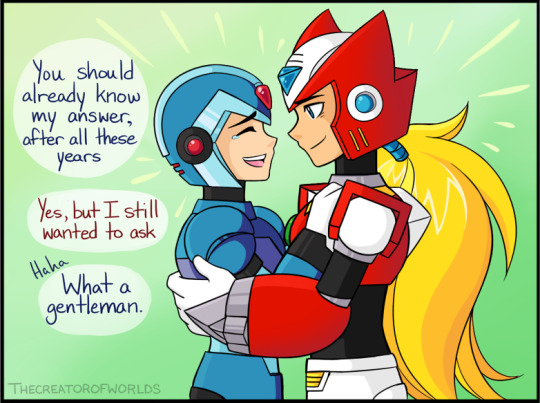
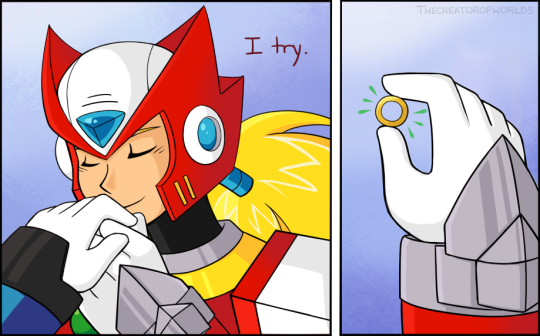
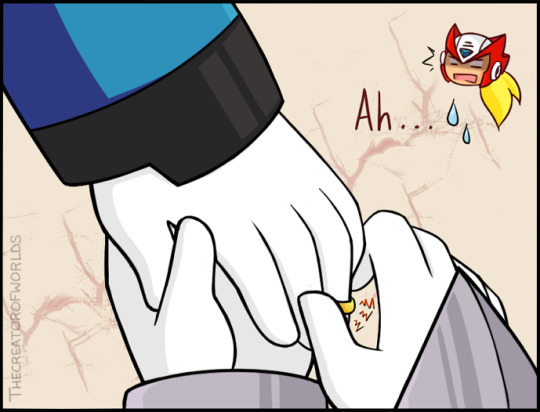
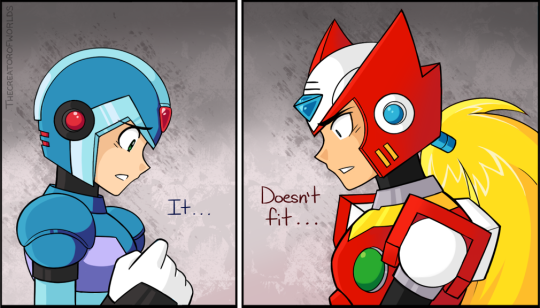
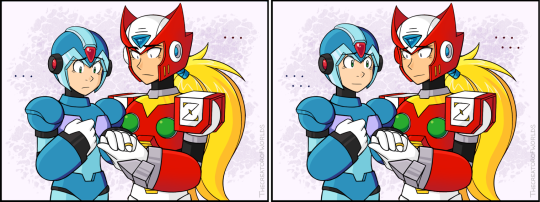


Jaybird wrote: On a panel-by-panel basis, the art is very good: crisp lines; good color and lighting; good technique with hands and faces; great use of background and expression to convey mood -- you got more mileage out of your backgrounds than probably anyone else here.
Miyabi wrote: Another nice job of mixing humor into your piece, while still keeping it a tender, sweet moment. Nice way of showing that things don’t always go as planned for a proposal, but sometimes it’s the thought and effort that counts. As always, your lines, colors and penmanship are smooth and flawless.
Superbasket5:
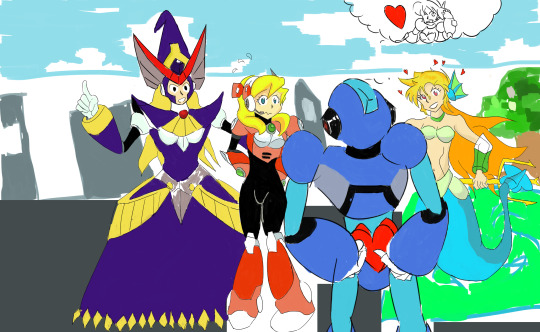
Jaybird wrote: Aww. If I've got this right, it looks like X is so nervous about giving Alia a valentine that he doesn't realize Berkana is giving Alia encouragement as well. I think. I have to wonder what Marty is doing here -- research tells me she has a crush on X, which seems like it would get in the way, and if that's the case, this impending trainwreck will be something worth watching. That said, the piece is still in its rough stages, especially your setting and perspective; I can't really tell where the characters are (outside at a park?), and Alia's hip is in front of X's arm.
Miyabi wrote: Alia has her support group, but I don’t know if she’s going to be able to pop the question to X with a crowd around her, either. XD Cute expressions, showing her nerves, while X is probably not quite expecting what’s hiding behind her back. I kinda wish we would get that visual of what she’s hiding as a cutaway, much like how you gave X a thought bubble for what’s going on in his head.
@yugiohlesbian:
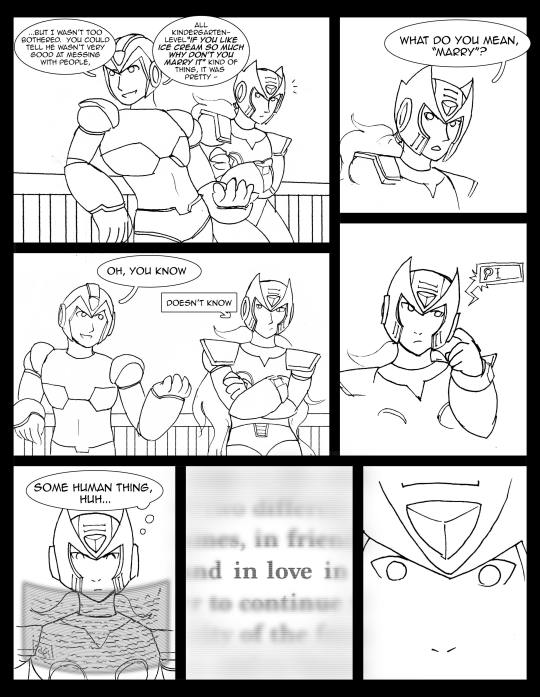
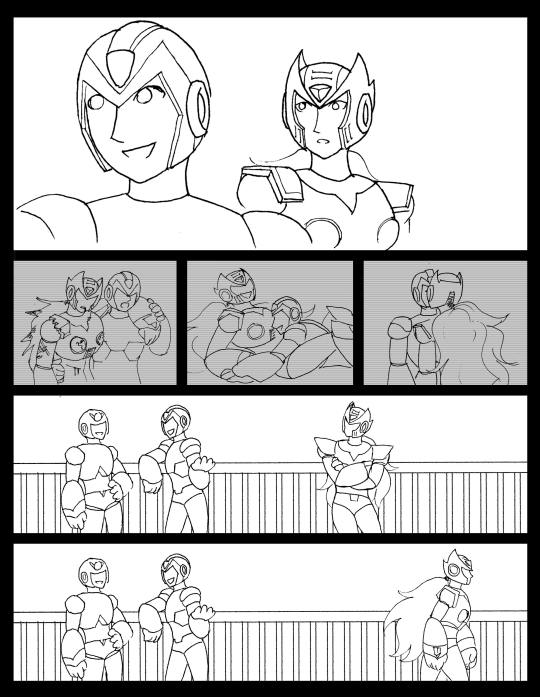
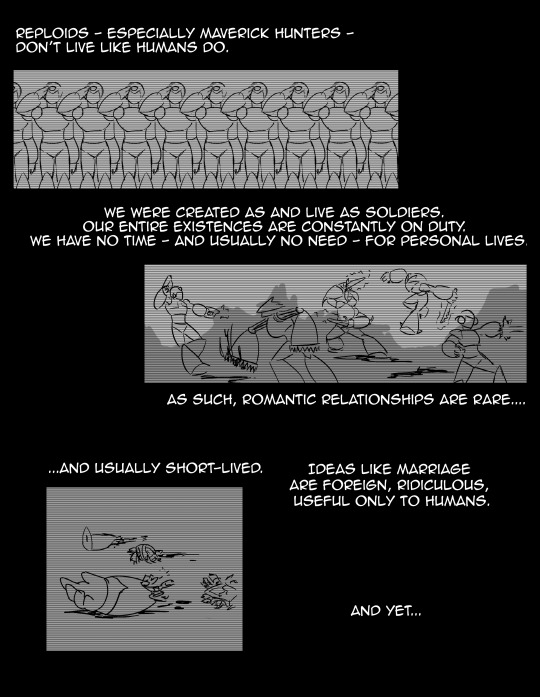



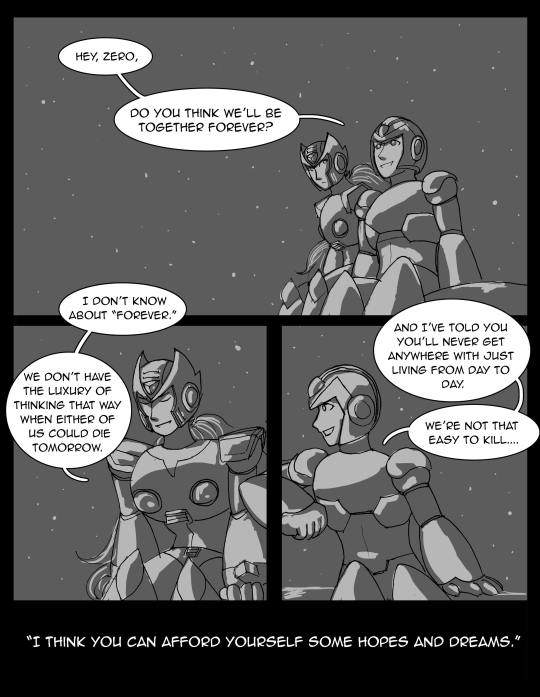
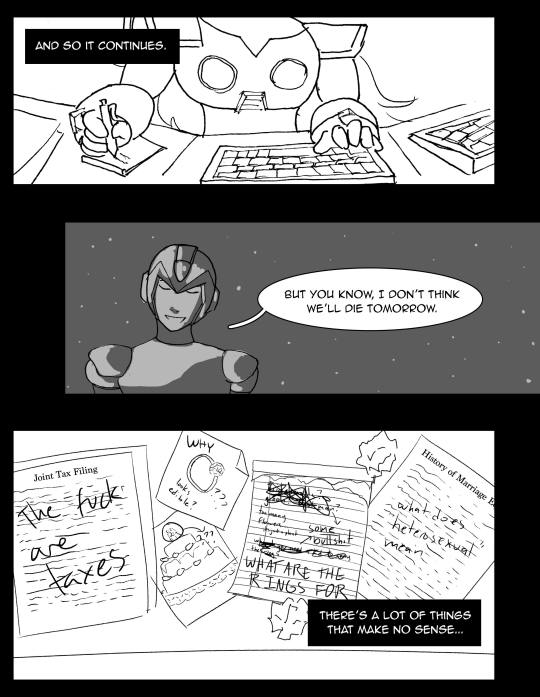

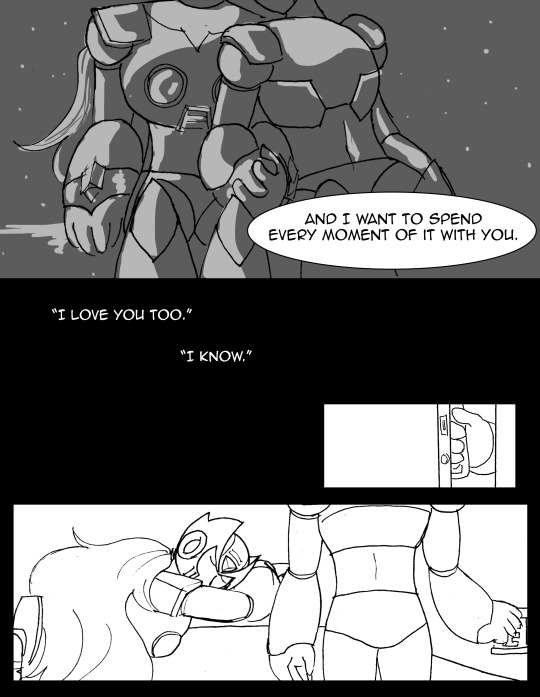


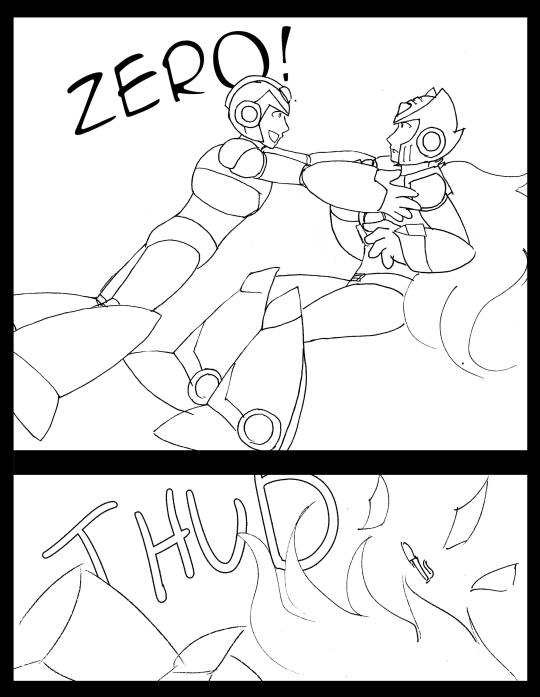
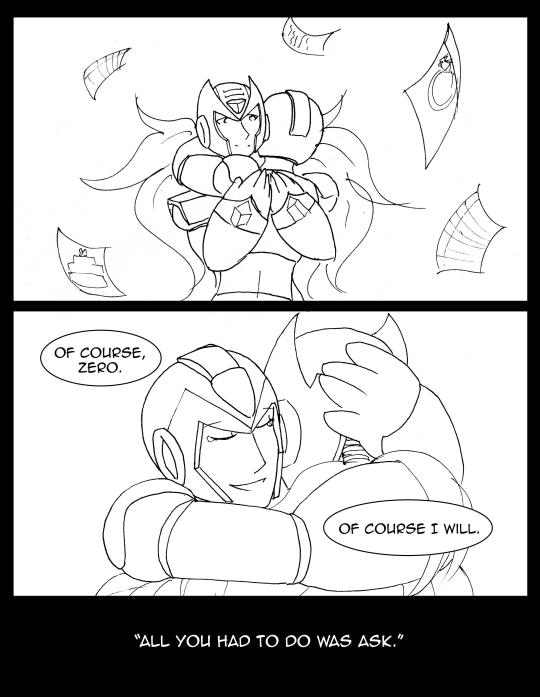
Jaybird wrote: Good job! I'd like to compliment you on how versatile your figures are and how you use that to make them very expressive; your use of perspective and individual panel compositions are both very versatile. While there isn't any color, the nighttime scenes do a good job with the lighting. Your style is pleasantly simple, but sometimes the panels seem to be oversimplified; more developed backgrounds would be welcome in several places.
Miyabi wrote: Totally different subject, but Zero, none of us understand taxes, either. I like how you illustrated the struggle of a reploid trying to understand human logic and traditions, and yet in the end, it still being something Zero didn’t truly need to grasp in that logical sense. While I know you wish you would have had more time to continue perfecting these panels, I agree that the night scenes stand out and give a good contrast between Zero’s computer research scenes.
Thanks once again to all who participated! I will be contacting the winners soon enough. Work will probably keep me from replying to everyone immediately, but if you don’t hear from me today, I will send a message about prizes hopefully within the next day.
For those awaiting the secret contest results...sorry, for another slight delay. Between finishing my promo art for this thread, and typing this, it took up too much time and I’ve gotta head to work. I will have those posted overnight, into Sunday morning, as it won’t be quite as intensive to write up. My apologies, but I hope you can all hang on for another 20 hours or less. ^^;
67 notes
·
View notes
Text
Ranking : Ridley Scott (1937-present)

To try to marginalize or pigeonhole the work of Ridley Scott is an exercise in futility. The English filmmaker will be celebrating his 45th year in the business in 2022, and by that time he will have added two more films to his filmography (pending any issues with their respective releases). By the time he’d released his tenth film, he’d already made two feminist film classics, two genre-defining science-fiction films, a gripping period piece as a debut, a fantasy film, an epic historical drama, two gritty noir thrillers and a sea-faring coming of age film. His name is synonymous with quality film despite having released his fair share of divisive output, but if his upcoming two releases (House of Gucci and The Last Duel) are any indication based on word of mouth and trailers, his form is likely better than ever.
A Ridley Scott ranking has been highly requested over the past few months, but based on the sheer volume of films he has directed, I shied away from the task for much longer than I intended. Deep diving into his catalog has not only allowed me a richer understanding of films like Blade Runner, Hannibal and The Martian, but it gave me the opportunity to see films like Thelma & Louise, Gladiator, Matchstick Men and Prometheus for the first time in a long time, and films like G.I. Jane, Body of Lies, White Squall, Exodus : Gods and Kings and Black Hawk Down for the first time period. For the most part, there were no surprises or shocks in the fallout of ranking these stellar films, outside of the film that unfortunately found itself in my choice for last place. I had machinations of holding off on this list at least until House of Gucci saw the light of day, but once I got into the home stretch of the catalog, the time felt right to share the list.
Enjoy, remember that this list is simply my opinion and not an attempt to state the definitive ranking of Scott’s films, and most importantly, keep deep diving into the world of cinema!


25. Legend (1985) We may as well go ahead and get this out of the way… Legend is the film that delayed the creation of this list. I’ve tried many times over the years to buy into this film the way that the masses and film fans close to me have, but try as I might, my heart is just never in it when I sit down for a screening. Legend marked the end of a frustrating run of films for Scott with varying degrees of success, and in my opinion, that intangible frustration manifests itself in Legend, as if the film has aspirations for greatness but ultimately became a project that just needed to be completed once started in order to be successful. Some of the simplistic shot-reverse shot compositions and locations that resemble sets more so than actual geography would lead me to believe that Scott’s heart wasn’t into the production, but a bit of research proved the opposite to be true, so perhaps it’s the material itself that doesn’t connect with me. Scott had shown he can do ‘classical’ film better with The Duelists, and he proved twice to be a fantasy and science-fiction mastermind with Alien and Blade Runner, but with Legend’s release occurring years after the release of the much darker and more captivating The Dark Crystal (which I connected with heavily at a young age despite its extreme darkness), Scott’s cinematic fairy-tale felt more derivative than it did dynamic.


24. 1492 : Conquest of Paradise (1992) Let’s get the good things about this film out of the way first… in terms of capturing unique locations and making artwork out of the skill of cinematography, 1492 : Conquest of Paradise is up there with the best of Ridley Scott’s work. The sequences on the ocean alone are breathtaking enough to validate Scott and company as masters of their craft. The costuming is on point all around, from Queen Isabella I down to the least significant of the natives, and a quick scan of any collection of characters gives one an immediate indication of how we should see them in comparison with one another. Sigourney Weaver, Fernando Rey, Mark Margolis, Tchéky Karyo, Fernando Guillén Cuervo and Armand Assante all give captivating performances, while Michael Wincott threatens to steal the show from all involved. The overwhelmingly glaring issue with this film, sadly, is Christopher Columbus himself, or rather his depiction by lead actor Gérard Depardieu. While the story itself has lofty aspirations of depicting Columbus as a fearless leader with strong convictions who is wholly aware of his faults, what we get from Depardieu is a baseless, depthless attempt that lacks emotional nuance or dramatic range, resulting in a rather flat attempt to make us care for the individual we spend the most time with on this cinematic journey. Add to this the fact that the natives are initially shown to be what essentially boils down to humanoid Ewoks, with no improvement on how they are presented as the picture unfolds, and we are left with a very surface level presentation that almost accidentally brings up good ideas (such as Columbus mistaking the natives as taking he and his counterparts for Gods) before outright abandoning them. It is clear as day to see what this film wanted to be, which makes it that much more painful how clearly the film failed to be these things.

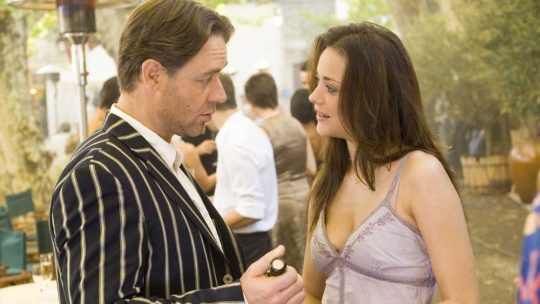
23. A Good Year (2006) Over the course of the past 20 years or so, the trope of the Manic Pixie Dream Girl has stepped into the spotlight, been deconstructed and emerged out the other side as a shallow construct. To be fair, with the trope usually having an association with teenage and young adult romantic comedies and dramas, it is a forgivable one, as the innocence and immaturity of these ages allows room for shallow behavior, surface level observation and seemingly magical resolutions. In order to really see the dramatic and emotional limitations of the trope, however, once must apply the story to the world of adults, and for exhibit A, I present you with Ridley Scott’s A Good Year. One could forgive the film as a cool down of sorts from a string of big budget historical dramas, but Scott already had the somewhat successful Matchstick Man under his belt from just three years prior, which makes A Good Year that much more confounding. As a central protagonist, there is nothing endearing about Max Skinner : he is manipulative and neglectful of his loving Uncle Henry, under-appreciative of his staff of “lab rats” that generate money for him on a daily basis, disrespectful of the vineyard he inherits from his Uncle Henry’s death and dismissive of those who care for it. It is only when the beautiful Fanny Chenal presents herself (in the wake of nearly being killed by Max as he drove while texting, I might add) that Max finds a minimal sense of awareness. The romantic arc the pair share has all the rise and fall of a Kansas road, and by the film’s conclusion, the only thing that has really changed for Max is his place of residence and his relationship status. I assumed there was a reason I was not familiar with this film, and after seeing it, my assumptions were validated and laid to rest. Ridley Scott may be a master of several genres, but based on A Good Year, the romantic comedy is not one of them.


22. The Counselor (2013) With a talent at your disposal like Michael Fassbender, one would be a fool not to maximize your interactions and opportunities with him. In the case of Ridley Scott, the addition of Fassbender into the world of the Alien franchise (via Prometheus) was such a success that it makes sense Scott’s next film would center around a Fassbender character if possible. Ironically, making him the titular character in The Counselor turned out to be a bit of a signal for the issues that would arise with the film : a nameless protagonist that is meant to be an antihero, but lacks the depth for the audience to care for or invest in his existence; a fast-tracked infusion of an outsider attempting to wet his beak in the criminal world without a clear indication of the stakes he faces; tons of big name actors and actresses used to attempt and give the characters within the film some associated weight, all forced to try and mine a surface level story for dramatic depths. It’s not that there’s really anything wrong with The Counselor, it’s just that there’s not a whole lot there to examine or critique. His earlier attempts at thrillers may have been more by the book than off book, but at least they had a dramatic verticality to them that made up for any shortcomings in the narrative path laid out... sadly, The Counselor walks its designated path, making sure not to kick up any dust along the way. Shout out to Cameron Diaz for putting on one hell of a show though.

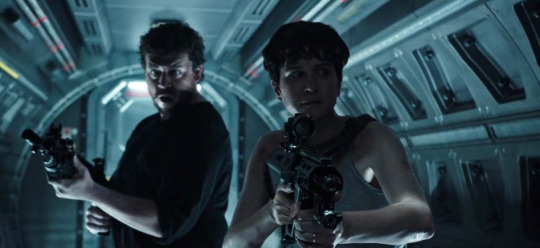
21. Alien : Covenant (2017) An old idiom exists about how too much of a good thing can be a detriment, and in most cases, I found this adage hard to honestly wrap my head around. One would think that multiplying a positive would only result in an overabundance of positivity, and if the world worked on sound logic, maybe this would be the case. Life works with its own set of mathematics, however, and because of this, we get idioms like “too much of a good thing”, and we get examples of this idiom such as Alien : Covenant. The film was the sixth in the monumentally successful Alien franchise, and the third directed by Ridley Scott (not to mention the second of a planned prequel trilogy), but somewhere along the way between concept and critical reception, Alien : Covenant stepped too far away from what made its predecessors classics. The idea of a beacon that draws a crew in with an alternative mission was all too familiar ground for Alien films, David went from being a genius idea to the character forced to shoulder the burden of an entire film, and the once captivating Xenomorphs (and other alien wildlife) succumbed to the allure of digital effects. The film swings wildly between epic dramatic continuances of what was introduced in Prometheus and drawn out expositional dumps disguised as intercharacter conflicts. The one interesting idea, that of David (and by extension, an AI) becoming God-like with the power to create life, is relegated merely to one of the aforementioned exposition dumps, or at least it feels that way as the film crosses over into the third act. Alien : Covenant is not necessarily a bad film in its own right, but by the time it saw the light of day, it felt somewhat unnecessary, and nothing about its existence does much to sway viewers to feel otherwise.


20. Someone to Watch Over Me (1987) After soaring high on the wings of four very production-intensive movies, Someone to Watch Over Me marks the first true look at how Ridley Scott handles the standard Hollywood fare, and to the surprise of nobody, Scott takes basic material and elevates it with the assistance of Tom Berenger, Mimi Rogers and Lorraine Bracco. Scott’s use of light, intent-heavy cinematography and flashes of color make the film look like a Michael Mann affair, though the narrative does not quite meet the gravitas of Mann’s material. In terms of said narrative, overlaying a love triangle with a male/female dynamic similar to The Bodyguard is nothing new, but as mentioned before, the triad of leads bring enough individual character and emotional tension to amplify what’s on the page. The location of Miss Gregory’s apartment stands as a stark centerpiece of the film, with its grandness and opulence not only separating it from the remainder of the world we find ourselves in, but doubling as functional in the standoff between Berenger’s Detective Mike Keegan and Joey Venza, the film’s antagonist (portrayed by Andreas Katsulas). While the film can be praised for taking a non-conventional swerve at the end in terms of resolving its love triangle, it takes Someone to Watch Over Me quite a while to build up to it, which is ironic considering the somewhat standard runtime of the film. All in all, there’s nothing wrong with Someone to Watch Over Me, but as the years went by (and even as soon as his next film), Ridley Scott would surpass the quality of work shown in Someone to Watch Over Me.

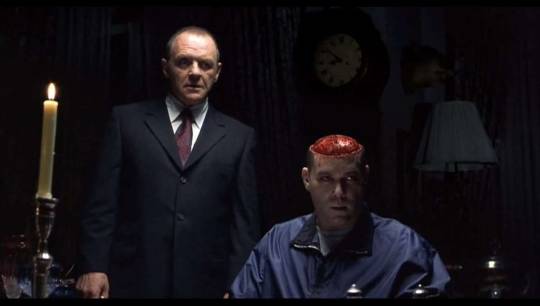
19. Hannibal (2001) In theory, nothing about Hannibal should have worked in the transition from book to script to screen. There are certain aspects of The Silence of the Lambs, the predecessor to Hannibal, that make it the incredibly suspenseful classic that it is : the determination of up and coming FBI Special Agent Clarice Starling, the off the wall nature of Buffalo Bill and the cunning, intelligent brooding sinister nature of Hannibal Lecter create a trio of tenuous connections and dangerous encounters. As The Silence of the Lambs wraps up, one of the most powerful aspects it has working for it is the wonder of how that world progresses after we take in the slice of life we are presented with. The reason Hannibal is so jarring is that it not only dashes our chance at imagination, but it doubles down on what was probably already grim speculation on our part. In Hannibal, the titular antagonist suddenly becomes an active predator setting multiple traps for those in pursuit, Buffalo Bill is replaced by a disfigured former victim of Lecter’s who is seeking brutal revenge, and Agent Starling becomes the captive, trapped under the weight of the dark phases of her career and the intrigue spawned from the reemergence of Lecter. This multifaceted cat and mouse game should have been doomed to fail, but based on the way that Hopkins naturally steps back into his most infamous role, the way that Julianne Moore brings experience (and frustration) into her replacement role, and most importantly, the way that Gary Oldman makes Buffalo Bill look like a first level video game boss, Hannibal manages to hold attention throughout its crazy and over-embellished world. Ridley Scott doesn’t always knock it out the park when he swings for the fences, but in the case of Hannibal, he may have hit himself a walk-off homerun that falls perfectly in line with Manhunter and The Silence of the Lambs saga.


18. Prometheus (2012) Perhaps the most intriguing aspect of Prometheus, the fifth film in the Alien franchise and the second directed by Scott, is the way that it was developed and released as a sort of unspoken backdoor prequel setup for the world of Alien rather than a basic walk-up to the events of the first film. While there are ideas (and even locations) from Alien presented in a sort of reverse echo, Prometheus has more than enough narrative gravity to stand alone from the franchise. The presence of the Weyland Corporation has always been felt in the Alien films, but Prometheus gives us our first look into not only the base motivations of the Weyland Corporation, but a look at Peter Weyland, the man behind the corporate machine. The introduction of David (played brilliantly by Michael Fassbender) makes the film worth seeing in its own right, with his android performance based more on Ridley Scott’s Blade Runner Replicants than on Ash, the infamous android from the first Alien film. The philosophical and evolutionary ideas thrown around in Prometheus give viewers tons of mental stimulus to chew on, adding a bit of narrative depth to the usually straight-forward Alien ventures. I can’t speak on the behalf of Ridley Scott in terms of his feelings about the Alien franchise and its journey, and I certainly wouldn’t want to disparage the likes of James Cameron or Joss Whedon (or their contributions to Alien as a whole), but in many ways, Prometheus feels like an attempt to redirect the overarching narrative course of the film franchise that made Scott a household name… Prometheus attempts to give a pure and clearly discernible history to a franchise that has covered plenty of cultural landscape, which in turn can ground Alien and the Xenomorphs in a way that doesn’t make their comic book, video game and Predator-hunting exploits so ridiculous in retrospect.


17. Black Hawk Down (2001) The U.S. military's 1993 raid in Mogadishu, better known to the populous as the Battle of Mogadishu, marked a dark spot on the record of the United States military in terms of attempts to establish democracy and follow the rules of engagement in order to protect the lives of American soldiers and innocents caught in the midst of battles and civil wars. What was meant to be a support stance and an extraction mission turned into an overnight standoff that took several lives and injured scores of soldiers, and Ridley Scott does a masterful job of setting up military propaganda only to take the shine off the apple like a ripped Band-Aid. The cast is an ensemble in the truest form, with a massive list of character actors and leading men chock-full of personality, so while the establishment of individuals is minimal and fast-tracked, the losses still hit hard because of our satellite familiarity with the men behind the characters. Perhaps the most ironic aspect of the film is the fact that it is open to interpretation in regard to whether it is pro or anti-war, but maybe that’s poetic justice in a way, as the fog of war often makes it hard to identify good or bad in terms of black and white. The nature of the operation and Ridley Scott’s decision to focus on the most FUBAR part of it all would lead one to consider the film anti-war, but even if you’re against the military and the ideals it reinforces, you would have to be a soulless individual to not recognize the courage, honor and valor of those willing to risk their lives in order to pull their trapped brothers out of a nightmare predicament. Black Hawk Down is one of the truest looks at the military, warts and all, and with technology doing everything it can to change the face of war, skirmishes like the Battle of Mogadishu are a grim reminder that war will almost always find itself in an eyeball to eyeball scenario before all is said and done.


16. Matchstick Men (2003) Matchstick Men marked an interesting point in my journey towards deep film fandom. I was less than a year out of college, and my taste for film was expanding as rapidly as my awareness of actors and directors was ballooning. I had recently seen Alison Lohman in White Oleander, and she was amazing. Sam Rockwell was a solid fifteen years into his career (including an early appearance in Teenage Mutant Ninja Turtles that would retroactively blow my mind), but it was a string of appearances in The Green Mile, Galaxy Quest, Charlie’s Angels and Confessions of a Dangerous Mind that put him on my radar. Nicolas Cage was already a star, but somewhere around Face/Off and Con Air he embraced his unpredictable and instinctual side, and by the time Matchstick Men rolled around he was finding the stride we all know and love him for today. At 23, I had nowhere near enough life experience to truly understand how dark a comedy Matchstick Men was, but as a man starting the journey through his 40s, the weight of the irony that Roy Waller falls victim to was not lost on me. As a man with severe OCD that triggers severe Tourette's reactions when untreated, the perfect thing to upset the balance is a teenage daughter he is forced to meet for the first time. As a professional con artist with a fear of playing the long con, it’s only fitting that the long con he will fall victim to would be one of seismic proportions. With such strong parallel narratives, a firm boundary is established for the trio of leads to showcase a wide range of emotional tones, not to mention a foundation for Ridley Scott to build his production mechanisms on that captures the interplay between the world of con artists, with brief interludes set to Roy’s episodes from a first person perspective. In the hands of a regular director Matchstick Men would be a solid but forgettable coming of age meets budding awareness comedy, but Scott elevates the material, turning into a myriad of twists and turns that force us to chase the plot in order to keep up, only to be rewarded once it surrenders itself.


15. Robin Hood (2010) As perhaps the most curious of all films in the Ridley Scott oeuvre, Robin Hood ended up being quite the experience as a first time viewing. Anyone even remotely familiar with the longstanding tradition of the Robin Hood legend walks into any viewing of a Robin Hood tale with a built in set of expectations : a swashbuckling titular character full of outlaw charm, a greedy and corrupt Sheriff that runs roughshod over the people of Nottingham, an opportunistic King who cannot step into the sudden power vacuum fast enough, and a damsel in distress. A major positive of the Ridley Scott Robin Hood is the fact that he chooses not to copy and paste his characters from these familiar constructs, opting instead to ground his world in a bit more of a believable reality in terms of actions and emotions. Russell Crowe, Mark Strong, Oscar Isaac, William Hurt, Max von Sydow and Kevin Durand all give standout performances in a very large cast deep and rich with talent. My only true “gripe” about this film, in all honesty, is the fact that they chose not to fully commit to making Marion Loxley (portrayed brilliantly in another standout performance from Cate Blanchett) the center of this narrative universe. With Robin Hood being stripped of the theatrics and antics usually associated with him and his merry men, not to mention his surname of Loxley, the heart of the film is the story of Marion learning about the death of her husband while in the midst of taking part in a large scale ruse to draw in and defeat Godfrey and his legion, who are acting on behalf of Prince John. While the perspective does shift between that of Robin, Marion and Prince John throughout the film, Robin is the apex of this triangle, whereas placing Marion as the perspective foundation would help us fast-track our understanding of Scott’s intentions on how we should perceive all of the previously named characters we assume to be familiar with going in. If you have hesitations about seeing Robin Hood based on assumptions of what it will be, give it a chance, as it is one of the most captivating portrayals of the story I can remember seeing, and perhaps as far away from what my assumptions were about it as a film can be.


14. Body of Lies (2008) For all of the genre hopping that Ridley Scott has done in his extensive career, his canon is notably absent of espionage-based thrillers. Military films, ensemble casts and action are nothing new to him, and yet outside of Body of Lies, I’d be hard-pressed to label any of his other films as spy films (pardon the use of a reductive genre signifier). His lack of presence in this realm is a shame, because the genre really fits him. His curiously active camerawork, penchant for color-timing his films with a dark and sinister hue and consistent exploration of the human elements his characters possess already make his films striking, and when applied to a story rife with tension due to the fog of modern warfare, it makes Body of Lies kinetic with all kinds of energy flowing back and forth between its many moving pieces. Leonardo DiCaprio puts another notch in his belt of standout performances, and though his screen time shared with Russell Crowe is minimal, DiCaprio brings out the snide best in Crowe during their numerous back and forths. Oscar Isaac, Mark Strong and a host of others populate the world in which DiCaprio navigates, giving him a host of different temperaments to play off of, which helps us as viewers feel the uneasiness and fleetingly tacit understanding of the situations that DiCaprio’s character shares with them. Placing the film in Iraq and embedding its story firmly in the C.I.A.’s anti-terrorism efforts gives the film a fascinatingly shaky foundation in the form of fleeting intelligence, an ever-shifting hierarchy of power and ever-present threat of the IED or the suicide bomber. Perhaps the biggest knock against this film is its solitary existence within the Ridley Scott filmography, as it feels like him dipping his toe into the waters of the genre and making a few waves rather than a full-style immersion. I’d imagine that if the right espionage-based thriller came down the pipeline before Scott decides to call it a wrap, we could get a potential masterpiece out of him, if not a genre-defining effort at the least, based solely on the potential shown from Body of Lies.


13. Exodus : Gods and Kings (2014) There seems to be a recurring theme in the films of Ridley Scott involving a sort of humanistic takedown for characters we tend to romanticize in our media. Be they historical figures like Christopher Columbus or the Mogadishu military team, fictional characters like Robin Hood or Hannibal Lecter, or even conceptual constructs like the many cyborgs sprinkled throughout the Alien franchise, Scott loves depicting them warts and all in his attempts to harness, capture and present a true-to-life portrayal of his cinematic protagonists. While Exodus : Gods and Kings was not well received due to supposed historical inaccuracies, the whitewashing of region-specific characters and judgement based on Scott’s stance as an atheist, I’d argue that when taken at face value, his portrayal of Moses is the closest he’s come to the bullseye in his attempt to humanize those we canonize. Like all Ridley Scott epics, the film looks and sounds amazing, and you can definitely see the budget on the screen. While packing the film with Western movie stars ended up being a detriment to the film due to the cultural shift that was taking place in terms of political correctness and cinematic representation, the cast is a particularly strong one, with Christian Bale’s enthralling performance supported by the likes of Joel Edgerton, John Turturro, Sigourney Weaver, Aaron Paul, Ben Mendelsohn, Ben Kingsley and many more. The action portrayed on the screen heightens the stakes without being overzealous, the symbolic moments have impact, and the presentation of the ten plagues stands as a shockingly stark contrast to the events preceding it (while also setting up the climactic centerpiece of the film). Biblical epics may not be for everyone, but for those secure in their faith or those not seeking a film that will preach to them, Exodus : Gods and Kings is definitely a take on Moses worth your time.


12. All the Money in the World (2017) Back in the dark ages of the DOOMonFILM blog, All the Money in the World had the opportunity to be one of the first ten films covered. Upon revisiting my thoughts on the film, the only thing that has really changed is my approach to writing on film… like all Ridley Scott films, All the Money in the World looks like a moving work of art, the emotional tension is rooted deep in the individual character’s outlook and approach to life (and how these stances clash with one another), and most key, a narrative that is propelled forward early and holds its momentum throughout due to stellar acting and an intriguing sequence of events. Speaking of intrigue, perhaps the most intriguing thing about All the Money in the World is how the real life emergence of the Me Too movement ironically worked out for the benefit of the film… while Kevin Spacey was likely more than willing and capable of portraying the infamously rich John Paul Getty, the sexual misconduct allegations levied against him forced his removal from the project, opening the door for a standout performance by Christopher Plummer (who was likely better suited to play the role when all was said and done). Thriller films anchored by the ransom format are nothing new, but the story of John Paul Getty III’s kidnapping, his estranged mother willing to do whatever it takes to get him back, and most importantly, his eponymous grandfather who is more than capable of being the financial savior but unwilling to unhand even a shred of his historically large fortune enhances every part of this familiar format, which in turn brings a new approach to Ridley Scott’s never-ending quest to examine humanity down to its core.


11. The Martian (2015) Usually, the success of a film depends on the collective effort of all those in front of and behind the camera. The director, crew, post-production staff, writers, producers and actors all share equal responsibility for whether or not the goal of a particular film is achieved, and if that vision is crystalized, everyone involved can celebrate knowing they shared an equal role in said film’s success. On occasion, however, you run into a situation where the efforts of a single individual can be clearly recognized above and beyond that of the collective, and in my opinion, The Martian is one of these achievements. To be fair, Ridley Scott deserves tons of credit for taking Drew Goddard’s adaptation of Andy Weir’s novel and turning it into a strong visual and auditory experience. The ensemble cast is strong from top to bottom… Jessica Chastain, Michael Peña, Sean Bean, Kate Mara, Askel Hennie and Sebastian Stan make an entertaining and emotionally expressive crew, while Chiwetel Ejiofor, Kristen Wiig, Jeff Daniels, Benedict Wong and Donald Glover all stand out as the Earthbound supporting cast. When it comes down to it, the star of The Martian, figuratively and literally, is Matt Damon, who spends a sizable amount of the film monologuing and making the most of having so much room to work with. Luckily for all involved (including viewers), Matt Damon is a pleasure on the big screen and is more than ready, willing and able to shoulder the dramatic burden that the role requires, and with the aforementioned extremely capable ensemble cast picking up the slack, what reads as a low key rumination on extreme isolation and the indomitable will of the human spirit plays as a spirited science-fiction drama that exceeds the bar it set for itself.


10. Black Rain (1989) When it comes to style, Black Rain has it to spare. Despite apparently being such a traumatic production experience that it caused Ridley Scott to vow never to work in Japan again, the Osaka location gives the film a similar visual texture to Blade Runner balanced against the look of popular gritty crime thrillers of the 1970s like The French Connection, Dirty Harry or the early films of the Death Wish series. Hans Zimmer shines in his first scoring job for a Ridley Scott film, providing enough dramatic weight and experimental texture to really capture the troubled mindset that fuels the captivating Michael Douglas performance. Speaking of this performance, the pain, turmoil and need for personal validation that fuels the Douglas portrayal of Nick Conklin plants itself well inside the extremely literal fish out of water scenario that the narrative is built upon… Conklin immediately starts off on the wrong foot with allegations of corruption hanging around him like a dark cloud, the inciting incident is an extreme case of being in the wrong place at the wrong time, and after an epically fumbled extradition attempt involving a dangerous criminal attempting to topple an opposing mob boss, Conklin and his partner Charlie Vincent find themselves shackled at every turn and unable to work their case. Ken Takakura’s performance of Detective Massahiro Matsumoto is powerful in terms of his channeled dignity, and is far from the only powerful supporting performance in this film. Black Rain could have easily been a kitsch crime drama that came one generation to late, forever finding itself damned to being dated by heavy shades of its era, but in my estimation, the combination of Michael Douglas, Hans Zimmer and Ridley Scott standing the test of time makes this film early proof of their talents.


9. White Squall (1996) I can’t speak on behalf of Ridley Scott, but White Squall feels like a redemption film. With the underwhelming saga 1492 : Conquest of Paradise under wraps and taking a slight beating out in the world, it felt like Scott needed a cinematic win that took place on the open water. With White Squall, Scott dips into true story territory again, albeit a much more recent and personal one via the sinking of the brigante Albatross. Scott dips into ensemble cast territory again, and the balance of young talent and character actors is impressive : young versions of Scott Wolf, Jeremy Sisto, Ethan Embry and Ryan Phillipe stand out in the student cast, while John Savage, Julio Oscar Mechoso and Caroline Goodall bring supporting power to Jeff Bridges’ dynamic lead ability. The lion’s share of White Squall centers around the process of shaping naïve boys into hard-working and respectable men, and the aforementioned ensemble cast more than steps up to the challenge of endearing the audience. By the time that the titular storm rears its ugly head, we’ve been given glimpses of the power of nature and the ocean, but nothing we’ve been primed with gives us preparation for the aquatic hell that punctuates the story. For some reason, I seem to have an aversion to films that take place on the open water, and full disclosure, White Squall was not high on my list of anticipated Ridley Scott films. This is a testament to the true quality of this film, however, because well before the heart-breaking third act climax hits us flush in the feels, I was already locked in to the White Squall experience.


8. Gladiator (2000) When Ridley Scott decides to go big, he puts his everything into it, and in the case of Gladiator, his maximum effort resulted in the first film to make a wide pop cultural impact in the new millennium. As the official signal of the summer film release schedule for 2000, the film instantly inserted itself into the zeitgeist, so much so that it even took on a deep significance in my favorite TV series, The Sopranos. Joaquin Phoenix had a healthy resume prior to Gladiator, but his role as the scheming sociopath Lord Commodus put him on the map in terms of the general movie-going public. Russell Crowe also had years of obscure roles under his belt, and had even transitioned into the Hollywood system prior to Gladiator with appearances in films like Virtuosity and L.A. Confidential, but his portrayal of the dishonored hero to the people Maximus made him a member of the Hollywood elite… so much so, in fact, that his band Thirty Odd Foot of Grunt gained awareness from Crowe’s high profile, a feat that only the rare handful of acting musician have been able to pull off. Like a modern day Ben Hur, Gladiator captured the imaginations of film fans and critics, dominating at the box office and placing second at year’s end (just behind Mission : Impossible 2) with nearly $200 million domestically and $500 million worldwide. When awards season rolled around, Gladiator received its flowers while it could still smell them, garnering a number of nominations from the Oscars, Golden Globes, BAFTAs and more, and winning in 48 of its nearly 120 nominations across the board. There isn’t much to be written or said about Gladiator that hasn’t already, and if not for my general malaise towards Russell Crowe, I’d probably be on board the Gladiator hype train with the general population. I’m not a hater, however, so I must respect the film for the glorious achievement that it is.

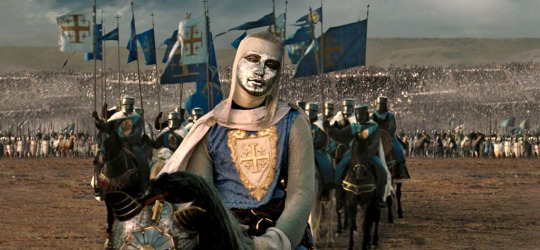
7. Kingdom of Heaven (2005) Using the Crusades as a backdrop for a personal crisis of faith feels like fertile creative ground for a mind like Ridley Scott’s, so it comes as no surprise that Kingdom of Heaven is operating on a very high level in all aspects, even if it is a bit on the long side. It’s easy to be dismissive of Orlando Bloom in this lead performance, as his stockier frame and majority internalized performance leave plenty of room for one to overlay their preferred casting on top of his subdued performance, but for the raw and direct manner in which Kingdom of Heaven lays out its narrative, Bloom’s performance works well. He is supported and opposed by a world of talent : Eva Green, Jeremy Irons, Brendan Gleeson, Liam Neeson, an unrecognizable Edward Norton and a host of others create a world full of characters all over the spectrum of religious zealotry and hunger for power. Scott returns to Morocco for his distinct Middle Eastern look, which he manages to make sinister and full of chiaroscuro despite the region’s unforgiving sun, and balances these harsh terrains against more regal locations scattered throughout Spain. The multitude of arms and wardrobe meant to represent the dueling regions match the epic feel of both the imposing of beliefs and the grand battles that result from opposing belief systems. The battles and weapons used look great on camera without being overly dramatic or flashy, with much of the close quarters combat looking and feeling as gruesome and intense as it likely was in real life. Though the film does not feel quite like the same level of spectacle that Gladiator or Exodus : Gods and Kings were, this slow burn will likely win viewers over from act to act much in the same manner that it did me during my introductory viewing.

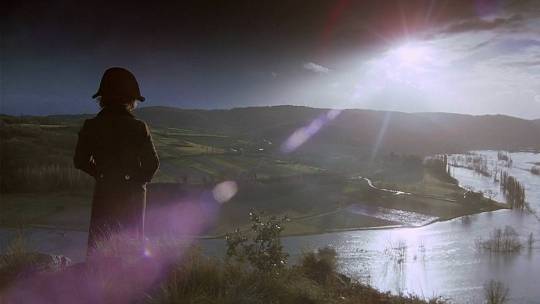
6. The Duelists (1977) At the risk of being hyperbolic, The Duelists may be one of the most impressive directorial debuts I’ve ever had the pleasure of seeing. Every aspect of this film resonates with the skill and confidence of a seasoned director, which would only serve as a sign of the greatness to come from Ridley Scott in his nearly 50 year career. One thing that is immediately noticeable is the astounding look of the film… while not quite on the level of a Barry Lyndon, The Duelists does a stellar job turning the period narrative into a living and breathing painting with rich, saturated colors all around, soft accents of light that enhance the objects they touch, and extremely deep lenses that capture the uncultivated nature of the land. Keith Carradine and a fiercely intense Harvey Keitel hold the audience captive as they battle one another over their personal definitions of honor. Most importantly, per the film’s title, the duels shown are very realistic rather than stylized for the screen… they are extremely patient in the way they advance, the actual battles are relatively close quarters rather than choreographed like a dance for the camera, and the majority of them end briefly and suddenly. The film does have touches that emulate the period it presents, but there is a modernity to the film that tosses the often hard to process dialogue and traditions of the period aside for the overall benefit. The string-driven score also deserves to be mentioned, and providing the Napoleonic Wars as a backdrop allows characters to evolve and move around the world, though when the rubber hits the road, all centers back around to the history of duels between our protagonist and antagonist.

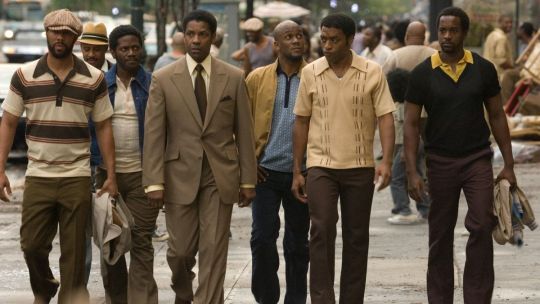
5. American Gangster (2007) Gangster films have been an American staple since the early days of Hollywood, but much like history or other aspects of the entertainment sphere, the Black experience is often minimalized, trivialized, and more often than not, overlooked completely. Maybe that’s what makes American Gangster such an intriguing film… not only does the Frank Lucas story get the same treatment that Once Upon a Time in America or The Godfather got, but it gets this treatment at the hands of Ridley Scott, a director whose previous 16 films would give you no indication that he would have aspirations to tell such a niche story. Nevertheless, the film does several key things that I am surprised a non-Black director (forgive me for how shortsighted that sounds) would be aware of : Harlem is shown in all of its historic glory as bigger than the sum of its parts; the story of Black migration in the face of post-slavery and Jim Crow America is a key element to why Frank Lucas stood out in Harlem; and, perhaps most importantly, Frank Lucas, not to mention the majority of his peers and counterparts, are shown as wise, calculated and shrewd businessmen willing to do dirty work, rather than the animalistic thugs that Black gangsters are often portrayed as. The cast of American Gangster reads like a who’s who of the early 2000s acting and musical spectrum, which is fitting considering the level of names the people were portraying for their reality-based cinematic counterparts. As glamorous and well-made a movie as American Gangster is, the film is not afraid of going eyeball to eyeball with the grim and brutal reality of the organized crime game, and it is this dynamism that made this film an instant classic, not to mention one of the best in the Ridley Scott oeuvre.

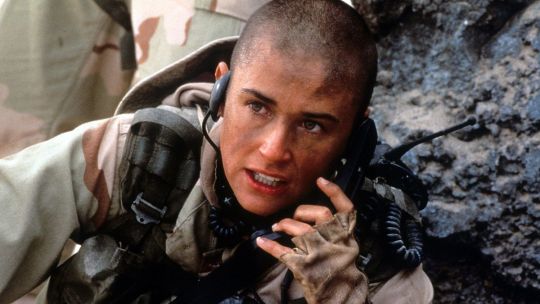
4. G.I. Jane (1997) It was pretty much impossible to be alive and cognizant in the late 1990s and not be aware of the phenomenon that was G.I. Jane. Maybe it was the defiant teenager in me, but with all the hype surrounding the film at the time of its release (not to mention the whirlwind of tabloids that was the marriage between Demi Moore and Bruce Willis), I skipped it at the time and never did find my way back around to checking it out. Much like Gus Van Sant’s To Die For (which got a similar treatment from me), I’m realizing that I cheated myself out of a classic film. Ridley Scott takes the construct of David versus Goliath and not only makes it more universally relevant by substituting a woman in the David role (which, whether we like it or not, immediately forces us to examine our ideas on gender roles and norms), but Goliath comes in several forms : the patriarchy, the United States military, an overzealous Master Chief and a wishy washy politician are all hurdles that Lieutenant Jordan O'Neil must overcome, not to mention the grueling process that is Navy SEAL training. Ridley Scott is no stranger to visceral and vivid production, and everything about this film rocks you with weight of Lieutenant O’Neil’s journey, be it the cold look of the film, the intense sound design, or the brutally in-your-face cinematography. The soundtrack on this film also has no business being as good as it is, with a couple of my personal favorite music cues involving songs from The Pretenders and Bikini Kill. Perhaps the most important outcome from this film was the performance from Demi Moore herself… at the time, I remember G.I. Jane receiving some harsh criticism, with many people pointing out Moore’s performance in particular. With so many years removed from its release, not to mention the benefit of a fresh perspective from a first viewing, I must recognize G.I. Jane for the forward-thinking accomplishment it is.


3. Thelma & Louise (1991) Ridley Scott already had at least two classics under his belt (three, considering your thoughts on Legend) by the time he directed Thelma & Louise, so nobody was doubting his ability to make compelling and stark cinematic visions. What Thelma & Louise did mark, however, was Scott’s ability to make a classic outside of the science-fiction realm. Thelma & Louise is many things all effortlessly wrapped up into one : it’s a buddy-based roadtrip picture, an outlaw film, a very dark comedy, and most importantly, it is a symbolic analogy on how much turmoil litters the path that women must travel through life, and how quickly someone else’s bad decision can change a woman’s life for the worst. Geena Davis was America’s sweetheart at the time this film came out, and Susan Sarandon was entering the third decade of what had already been a relatively successful career, but Thelma & Louise made both women instant icons, not to mention the last pair of co-leads in a film to both be nominated for Best Actor or Actress awards at the Oscars. The film also won for Best Original Screenplay, it became an instant benchmark in the feminist film movement, and 25 years after its initial release, it was selected for preservation by the Library of Congress for its cultural, historical and aesthetic significance. Harvey Keitel, Michael Madsen and Christopher McDonald all had standout supporting roles, and Brad Pitt’s brief but memorable appearance marked his shift from featured extra to eventual leading man. Words truly do not do a film like Thelma & Louise justice, despite the fact that it is very easy to gush over this absolutely beautiful and heartbreaking film… perhaps one of the few films that ends on a tragic note that still manages to instill optimism in viewers.


2. Alien (1979) With an impressive debut film under his belt, it seems that Ridley Scott’s career trajectory could have carried him in any direction. His name clearly held weight in the industry at that point, with his promise being evident to all, and in the wake of the monumental success that was Star Wars (which came out the same year as The Duelists), Fox’s hold on the Alien property suddenly shifted from a low speculation project to a promising science-fiction property. Scott accepted the offer to direct the film, and as they say, the rest was history… Scott’s keen eye and penchant for style met with the creature design of H.R. Giger, incredible set design and a script reminiscent of The Thing that was being pitched as “Jaws in space”. A cast of strong character actors was assembled, composed of Tom Skerritt, Veronica Cartwright, Harry Dean Stanton, John Hurt, Ian Holm and Yaphet Kotto, but the true cherry on top was the breakout star-making performance of Sigourney Weaver. While the premise of the film is relatively surface, the mixture of science-fiction, horror and psychological thriller aspects makes for a compelling journey full of unexpected twists and turns, with the most famous of all being the instantly iconic chest-bursting Xenomorph scene. I highly doubt that when Ridley Scott wrapped on Alien he would have expected it to receive the instant accolades that it did, so it probably would have been impossible to fathom at the time that the film would go on to be a cult classic recognized by critical media and scholars at the highest level, not to mention the cornerstone of a franchise that found success in the realm of print and video games, as well as an equally iconic peer in the Predator. While Alien wouldn’t be the last journey into the world of classic films for Ridley Scott, it’s arguable that it marked the most important step of his then budding career, fast-tracking him into the fraternity of Hollywood big hitters less than five years into his professional career.


1. Blade Runner (1982) What do you do when your first film is well above average and your second film is an instant classic? Well, if you’re Ridley Scott, you direct an iconic film that is arguably one of the most popular cult classics of all time, not to mention one of the most influential films ever made in terms of having an impact across a multitude of disciplines. The fact that Blade Runner has so many cuts (I watched The Final Cut, for reference), even more interpretations of where Deckard and Rachael fall on the Replicant scale, and an equally epic and compelling sequel should be a testament to its incredible influence. Elements of the production design, wardrobe, lighting and clever product placement not only build one of the most tangible worlds ever captured on the screen, but have gone on to be emulated in other media (be it print, film or digital) in countless ways too numerous to list. If Blade Runner isn’t the film that created neo-noir, it’s the film that wrote the book on how it should be done, as Deckard approximates Sam Spade in a world that looks like a mixture of the slummish parts of THX 1138 and the Star Wars planets on the Outer Rim. The complexities of the story give it a narrative volume many films strive for, with ruminations on artificial intelligence and what defines the human element abound, and surprisingly, Scott and company make no efforts to dumb down the distribution of information. Harrison Ford and Rutger Hauer are both a joy to watch in this film, with their eventual face-off living up to all of the promise that is built up in the promise of their story arcs crashing into one another… Hauer’s Tannhäuser Gate monologue is a joy to behold every time it is delivered. If you’re a fan of anime like Akira, films like The Fifth Element or Total Recall, the music of El-P or the work of Phillip K. Dick, or even if you’re just curious about the science-fiction genre, then seeing Blade Runner is a must.
#ChiefDoomsday#DOOMonFILM#RIdleyScott#TheDuelists#Alien#BladeRunner#Legend#SomeoneToWatchOverMe#BlackRain#Thlema&Louise#1492ConquestOfParadise#WhiteSquall#GIJane#Gladiator#Hannibal#BlackHawkDown#MatchstickMen#KingdomOfHeaven#AGoodYear#AmericanGangster#BodyOfLies#RobinHood#Prometheus#TheCounselor#ExodusGodsAndKings#TheMartian#AlienCovenant#AllTheMoneyInTheWorld
0 notes